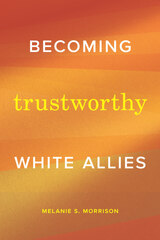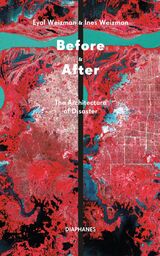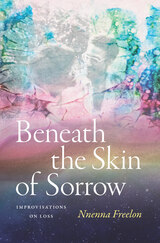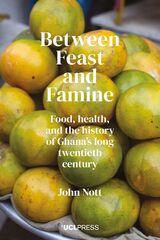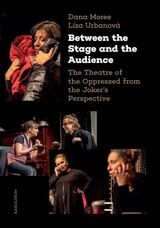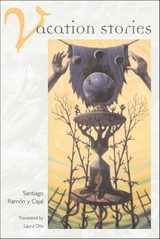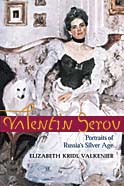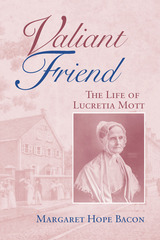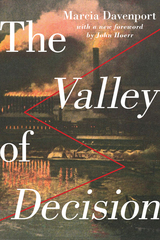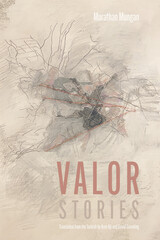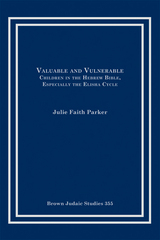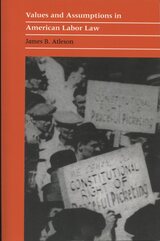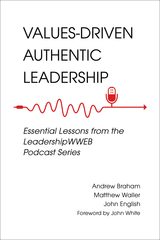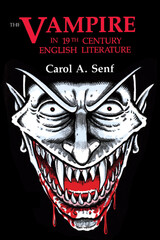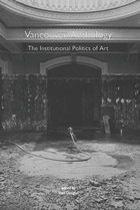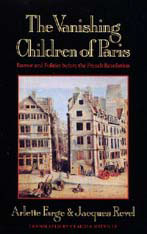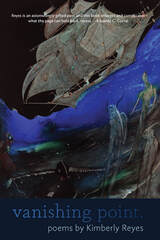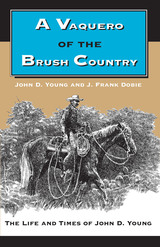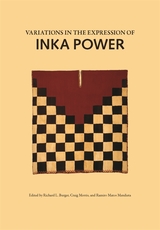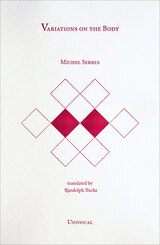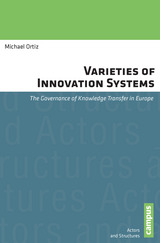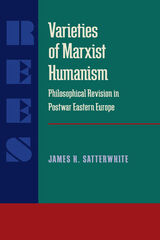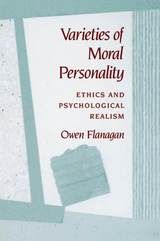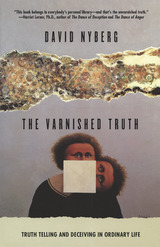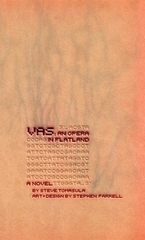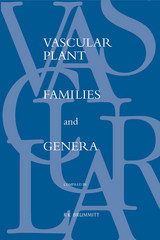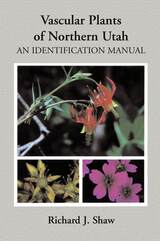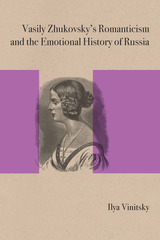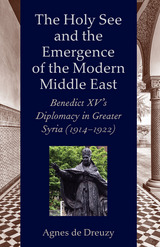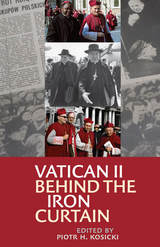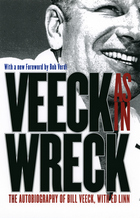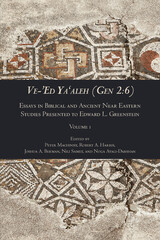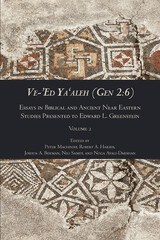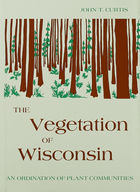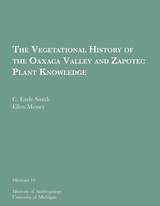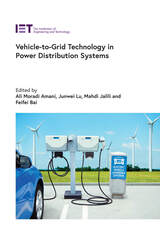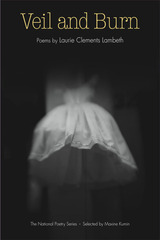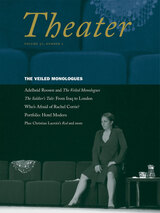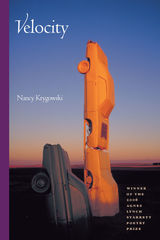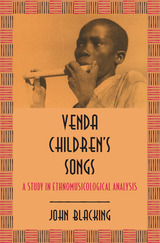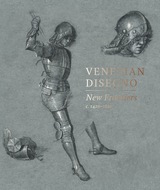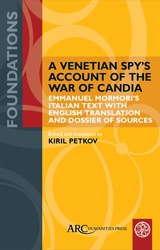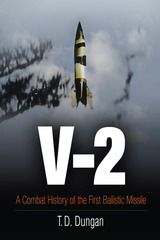 V-2: A Combat History of the First Ballistic Missile
T. D. Dungan
Westholme Publishing, 2005 A History of One of World War II's Most Advanced and Terrifying Technologies
In August 1944, Londoners thought the war might be over by Christmas. But on September 8, 1944, in the London suburb of Chiswick, a thunderous double-boom was heard followed by a huge plume of black smoke rising high into the air. Several minutes later another explosion rocked the earth near Epping. There had been no warnings, no drone of aircraft above, just sudden devastation. "Operation Penguin," the V-2 offensive, had begun. The A-4 rocket, better known as the V-2, Vergeltungswaffen Zwei, or "Vengeance Weapon 2," was the first ballistic missile to be used in combat. Soaring over 50 miles high at supersonic speeds, the V-2 would strike its target within 5 minutes of launching. Once in the air its deadly warhead was unstoppable. The ancestor of all Cold War and modern day ballistic missiles, as well as the rockets used for space exploration, the V-2 could not win the war for Germany—it was too expensive, too complicated, too inaccurate, and its warhead was too small—but its unprecedented invulnerability and influence on Allied planning made the V-2 and the advancements it represented the ultimate war prize, and British, American, and Soviet forces scrambled to seize German rocket technology along with its scientists and engineers. In V-2: A Combat History of the First Ballistic Missile, T. D. Dungan relies on an unparalleled collection of original documents, unpublished photographs, and accounts from those who were there to provide a complete description of the V-2 program, the missile's use in combat, and the race to capture its secrets.
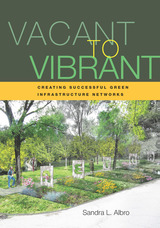 Vacant to Vibrant: Creating Successful Green Infrastructure Networks
Sandra L. Albro
Island Press, 2019 Vacant lots, so often seen as neighborhood blight, have the potential to be a key element of community revitalization. As manufacturing cities reinvent themselves after decades of lost jobs and population, abundant vacant land resources and interest in green infrastructure are expanding opportunities for community and environmental resilience. Vacant to Vibrant explains how inexpensive green infrastructure projects can reduce stormwater runoff and pollution, and provide neighborhood amenities, especially in areas with little or no access to existing green space.
Sandra Albro offers practical insights through her experience leading the five-year Vacant to Vibrant project, which piloted the creation of green infrastructure networks in Gary, Indiana; Cleveland, Ohio; and Buffalo, New York. Vacant to Vibrant provides a point of comparison among the three cities as they adapt old systems to new, green technology. An overview of the larger economic and social dynamics in play throughout the Rust Belt region establishes context for the promise of green infrastructure. Albro then offers lessons learned from the Vacant to Vibrant project, including planning, design, community engagement, implementation, and maintenance successes and challenges. An appendix shows designs and plans that can be adapted to small vacant lots.
Landscape architects and other professionals whose work involves urban greening will learn new approaches for creating infrastructure networks and facilitating more equitable access to green space.
 Vaccine Hesitancy: Public Trust, Expertise, and the War on Science
Maya Goldenberg
University of Pittsburgh Press, 2021 Winner, 2022 PSA Women's Caucus Prize in Feminist Philosophy of Science Award
The public has voiced concern over the adverse effects of vaccines from the moment Dr. Edward Jenner introduced the first smallpox vaccine in 1796. The controversy over childhood immunization intensified in 1998, when Dr. Andrew Wakefield linked the MMR vaccine to autism. Although Wakefield’s findings were later discredited and retracted, and medical and scientific evidence suggests routine immunizations have significantly reduced life-threatening conditions like measles, whooping cough, and polio, vaccine refusal and vaccine-preventable outbreaks are on the rise. This book explores vaccine hesitancy and refusal among parents in the industrialized North. Although biomedical, public health, and popular science literature has focused on a scientifically ignorant public, the real problem, Maya J. Goldenberg argues, lies not in misunderstanding, but in mistrust. Public confidence in scientific institutions and government bodies has been shaken by fraud, research scandals, and misconduct. Her book reveals how vaccine studies sponsored by the pharmaceutical industry, compelling rhetorics from the anti-vaccine movement, and the spread of populist knowledge on social media have all contributed to a public mistrust of the scientific consensus. Importantly, it also emphasizes how historical and current discrimination in health care against marginalized communities continues to shape public perception of institutional trustworthiness. Goldenberg ultimately reframes vaccine hesitancy as a crisis of public trust rather than a war on science, arguing that having good scientific support of vaccine efficacy and safety is not enough. In a fraught communications landscape, Vaccine Hesitancy advocates for trust-building measures that focus on relationships, transparency, and justice.
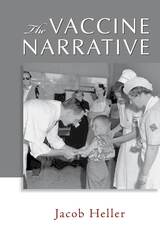 The Vaccine Narrative
Jacob Heller
Vanderbilt University Press, 2008 The Salk vaccine seemed like a miracle to parents whose children were threatened with the scourge of polio. With its protection from polio, came also a story line-there were heroic researchers who would use science to protect us from epidemics and perhaps even eradicate disease. For most people, vaccines have become the magic bullets for dealing with dangerous diseases. The continuing quest for new vaccines, including an HIV/AIDS vaccine, despite technical, epidemiological, and social obstacles, suggests the abiding power of this narrative.
The author examines four cases that span the twentieth century--diphtheria, rubella, pertussis, and HIV/AIDS. Each case challenges the reader to examine how the values we attribute to vaccines influence their use. Diphtheria vaccination brought laboratory science into an existing narrative based on earlier vaccines. With rubella vaccine, researchers efficiently responded to an epidemic of birth defects while subtly changing the relationship between vaccination recipients and beneficiaries. Opposition to pertussis vaccine from average Americans created a narrative crisis, in which faith in vaccination as a whole seemed to be at risk. With more recent vaccines, including a hoped-for HIV/AIDS vaccine, the persistent cultural narrative continues to encourage vaccine development and use.
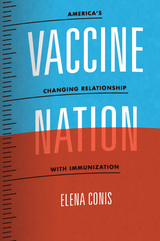 Vaccine Nation: America's Changing Relationship with Immunization
Elena Conis
University of Chicago Press, 2014 With employers offering free flu shots and pharmacies expanding into one-stop shops to prevent everything from shingles to tetanus, vaccines are ubiquitous in contemporary life. The past fifty years have witnessed an enormous upsurge in vaccines and immunization in the United States: American children now receive more vaccines than any previous generation, and laws requiring their immunization against a litany of diseases are standard. Yet, while vaccination rates have soared and cases of preventable infections have plummeted, an increasingly vocal cross section of Americans have questioned the safety and necessity of vaccines. In Vaccine Nation, Elena Conis explores this complicated history and its consequences for personal and public health.
Vaccine Nation opens in the 1960s, when government scientists—triumphant following successes combating polio and smallpox—considered how the country might deploy new vaccines against what they called the “milder” diseases, including measles, mumps, and rubella. In the years that followed, Conis reveals, vaccines fundamentally changed how medical professionals, policy administrators, and ordinary Americans came to perceive the diseases they were designed to prevent. She brings this history up to the present with an insightful look at the past decade’s controversy over the implementation of the Gardasil vaccine for HPV, which sparked extensive debate because of its focus on adolescent girls and young women. Through this and other examples, Conis demonstrates how the acceptance of vaccines and vaccination policies has been as contingent on political and social concerns as on scientific findings.
By setting the complex story of American vaccination within the country’s broader history, Vaccine Nation goes beyond the simple story of the triumph of science over disease and provides a new and perceptive account of the role of politics and social forces in medicine.
 Vaccine Nation: America's Changing Relationship with Immunization
Elena Conis
University of Chicago Press, 2014 This is an auto-narrated audiobook edition of this book.
With employers offering free flu shots and pharmacies expanding into one-stop shops to prevent everything from shingles to tetanus, vaccines are ubiquitous in contemporary life. The past fifty years have witnessed an enormous upsurge in vaccines and immunization in the United States: American children now receive more vaccines than any previous generation, and laws requiring their immunization against a litany of diseases are standard. Yet, while vaccination rates have soared and cases of preventable infections have plummeted, an increasingly vocal cross section of Americans have questioned the safety and necessity of vaccines. In Vaccine Nation, Elena Conis explores this complicated history and its consequences for personal and public health.
Vaccine Nation opens in the 1960s, when government scientists—triumphant following successes combating polio and smallpox—considered how the country might deploy new vaccines against what they called the “milder” diseases, including measles, mumps, and rubella. In the years that followed, Conis reveals, vaccines fundamentally changed how medical professionals, policy administrators, and ordinary Americans came to perceive the diseases they were designed to prevent. She brings this history up to the present with an insightful look at the past decade’s controversy over the implementation of the Gardasil vaccine for HPV, which sparked extensive debate because of its focus on adolescent girls and young women. Through this and other examples, Conis demonstrates how the acceptance of vaccines and vaccination policies has been as contingent on political and social concerns as on scientific findings.
By setting the complex story of American vaccination within the country’s broader history, Vaccine Nation goes beyond the simple story of the triumph of science over disease and provides a new and perceptive account of the role of politics and social forces in medicine.
 Vaccine Rhetorics
Heidi Yoston Lawrence
Ohio State University Press, 2020 Finalist, 2021 Association for the Rhetoric of Science, Technology, and Medicine Book Award
Honorable Mention, Conference on College Composition and Communication Best Book in Technical or Scientific Communication
Debates over vaccination run rampant in the US—from the pages of medical journals, to news coverage about the latest outbreak, to vehement messages passed back and forth online. From the professional level to the personal one, almost everyone has an opinion on vaccinations—and often conversations around this issue pit supporters of vaccinations against “anti-vaxxers.” In Vaccine Rhetorics, Heidi Yoston Lawrence turns a critical eye toward such conversations—proposing a new approach that moves us beyond divisive rhetoric and seeks to better understand the material conditions underlying the debate.
Starting with a key question—If vaccines work, why are they controversial?—and using an approach she calls “material exigence,” Lawrence seeks to understand the material conditions of disease and injury associated with vaccination. Examining four primary motivations—the exigency of disease at the heart of physician views, the desire for eradication from policymakers, concern over injury expressed by parents and patients in online confessionals, and questions about the unknown surrounding potential recipients of the flu vaccine, Lawrence demonstrates the complexity of vaccination skepticism and the need for more nuanced public discourse. In bringing together the voices of those who oppose, question, and support vaccines, Vaccine Rhetorics unearths the material circumstances that lead to differing viewpoints and brings important attention not just to what is said but how and why it is said—providing a useful framework for studying other controversial issues.
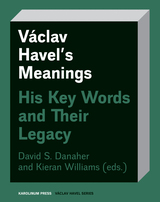 Václav Havel’s Meanings: His Key Words and Their Legacy
Edited by David Danaher and Kieran Williams
Karolinum Press, 2022 A close read of the rich collections of texts left behind by Václav Havel, one of the most important Czech thinkers and leaders of the twentieth century.
No one in Czech politics or culture could match the international stature of Václav Havel at the time of his death in 2011. In the years since his passing, his legacy has only grown, as developments in the Czech Republic and elsewhere around the world continue to show the importance of his work and writing against a range of political and social ills, from autocratic brutality to messianic populism.
This book looks squarely at the heart of Havel’s legacy: the rich corpus of texts he left behind. It analyzes the meanings of key concepts in Havel’s core vocabulary: truth, power, civilsociety, home, appeal, indifference, hotspot, theatre, prison, and responsibility. Where do these concepts appear in Havel’s oeuvre? What part do they play in his larger intellectual project? How might we understand Havel’s focus on these concepts as a centerpiece of his contribution to contemporary thought? How does Havel’s particular perspective on the meaning of these concepts speak to us in the here and now? The ten contributors use a variety of methodological tools to examine the meaning of these concepts, drawing on a diversity of disciplines: political science and political philosophy, historical and cultural analysis, discourse/textual analysis, and linguistic-corpus analysis.
Vacuum Switchgear
Allan Greenwood
The Institution of Engineering and Technology, 1994 This book provides a broad perspective of vacuum switchgear drawn from the author's many years of experience in this field. Allan Greenwood describes the development of the technology from the earliest beginnings to the most recent designs now on offer by leading companies around the world.
Vaikhānasa Mantra Praśna V–VIII (Daivikacatuṣṭayam)
Howard Resnick
Harvard University Press The Vaikhānasas are mentioned in many Vedic texts, and they maintain a close affiliation with the Taittirīya school of the Kṛṣṇa Yajur Veda. Yet they are Vaiṣṇavas, monotheistic worshipers of Viṣṇu. Generally, Vaiṣnavism is held to be a post-Vedic development. Thus, the Vaikhānasas bridge two key ages in the history of South Asian religion. This text contains many quotations from ancient Vedic literature, and probably some other older original material, as well as architectural and iconographical data of the later first millennium CE. The Vaikhānasas remain relevant today. They are the chief priests (arcakas) in more than half of the Viṣṇu temples in the South Indian states of Tamil Nadu, Andhra Pradesh, and Karnataka—including the renowned Hindu pilgrimage center Tirupati in Andhra Pradesh.
Valentin Serov: Portraits of Russia's Silver Age
Elizabeth Valkenier
Northwestern University Press, 2001 Valentin Serov (1865-1911) burst onto the art scene at the age of twenty-two with his portrait Girl with Peaces. In a short time he became the preeminent portraitist of Russia's Silver Age.
Elizabeth Kridl Valkenier weds art criticism to social history in her study of Serov. She casts the artist's work against the Gilden Age of turn-of-the-century Russia, an era when money and consumption abounded and revolutionary change was taking place at all levels of society. Painting prominent people of the day in business, government, the nobility, and the arts, Serov created a gallery of Russia's important figures--figures seen with a sharp eye and painted with subtle irony.
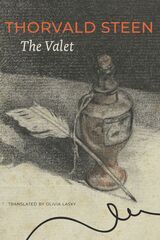 The Valet
Thorvald Steen
Seagull Books, 2026 A gripping historical novel that explores how the Fourth Crusade plundered Constantinople and forever changed the course of European history.
The year is 1204. Stripped of his power and held captive, Massimo Gasparino, once the most trusted aide to the Doge of Venice, pens a desperate secret letter to Pope Innocent III. His confession? He has witnessed the most egregious crime in human history: the deliberate diversion of the Fourth Crusade from Jerusalem to the heart of Christian Europe, Constantinople. As the city is ruthlessly plundered and its treasures shipped to Venice, Gasparino’s letter exposes the Doge’s shocking betrayal, a sin that irrevocably alters the course of history. But with his life and the fate of this explosive truth hanging precariously in the balance, can he get his message to Pope Innocent III before the Doge silences him forever?
The Valet is a tense, intimate drama of ambition, guilt, and the enduring shadows of a war that still resonates in today’s world.
 Valiant Vel: Vel Phillips and the Fight for Fairness and Equality
Jerrianne Hayslett
Wisconsin Historical Society Press, 2025 An illustrated biography of groundbreaking civil rights activist Vel Phillips for young readers
Fair housing advocate, civil rights champion, and civic leader Vel Phillips spent her life breaking barriers and fighting for justice for all people. As the first Black woman on the Milwaukee Common Council, Wisconsin’s first Black judge, and the first Black woman to win statewide office when she was elected secretary of state of Wisconsin, Phillips left a lasting legacy that has inspired generations to continue the fight for justice and equality.
Valiant Vel depicts Phillips’s captivating story for young readers in middle and high school—from her childhood experiences facing racial discrimination, to achieving her dream of becoming a lawyer, to her long career in politics and civil rights. In the 1960s, Phillips spearheaded a campaign to advocate for fair housing in Milwaukee, joining forces with the NAACP Youth Council and marching alongside other activists in the face of violent opposition. In 1968, Phillips’s persistence paid off when the Milwaukee Common Council passed a fair housing ordinance.
Beautifully illustrated with historic photographs and original artwork by Milwaukee artist Aaron Boyd, Valiant Vel makes an excellent addition to young readers’ bookshelves at school and at home. With an afterword by Phillips’s son, Michael, a glossary of terms, and sources for further research, this book provides a thorough look at an inspirational activist who dedicated her life to making the world a better place.
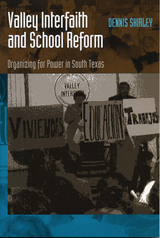 Valley Interfaith and School Reform: Organizing for Power in South Texas
By Dennis Shirley
University of Texas Press, 2002 Can public schools still educate America's children, particularly in poor and working class communities? Many advocates of school reform have called for dismantling public education in favor of market-based models of reform such as privatization and vouchers. By contrast, this pathfinding book explores how community organizing and activism in support of public schools in one of America's most economically disadvantaged regions, the Rio Grande Valley of South Texas, has engendered impressive academic results. Dennis Shirley focuses the book around case studies of three schools that have benefited from the reform efforts of a community group called Valley Interfaith, which works to develop community leadership and boost academic achievement. He follows the remarkable efforts of teachers, parents, school administrators, clergy, and community activists to take charge of their schools and their communities and describes the effects of these efforts on students' school performance and testing results. Uniting gritty realism based on extensive field observations with inspiring vignettes of educators and parents creating genuine improvement in their schools and communities, this book demonstrates that public schools can be vital "laboratories of democracy," in which students and their parents learn the arts of civic engagement and the skills necessary for participating in our rapidly changing world. It persuasively argues that the American tradition of neighborhood schools can still serve as a bedrock of community engagement and academic achievement.
 The Valley of Bones: Book 7 of A Dance to the Music of Time
Anthony Powell
University of Chicago Press, 1995 Anthony Powell’s universally acclaimed epic A Dance to the Music of Time offers a matchless panorama of twentieth-century London. Now, for the first time in decades, readers in the United States can read the books of Dance as they were originally published—as twelve individual novels—but with a twenty-first-century twist: they’re available only as e-books.
World War II has finally broken out, and The Valley of Bones (1964) finds Nick Jenkins learning the military arts. A stint at a training academy in Wales introduces him to the many unusual characters the army has thrown together, from the ambitious bank clerk-turned-martinet, Gwatkin, to the hopelessly slovenly yet endearing washout, Bithel. Even during wartime, however, domestic life proceeds, as a pregnant Isobel nears her term and her siblings’ romantic lives take unexpected turns—their affairs of the heart lent additional urgency by the ever-darkening shadow of war.
"Anthony Powell is the best living English novelist by far. His admirers are addicts, let us face it, held in thrall by a magician."--Chicago Tribune
"A book which creates a world and explores it in depth, which ponders changing relationships and values, which creates brilliantly living and diverse characters and then watches them grow and change in their milieu. . . . Powell's world is as large and as complex as Proust's."--Elizabeth Janeway, New York Times
"One of the most important works of fiction since the Second World War. . . . The novel looked, as it began, something like a comedy of manners; then, for a while, like a tragedy of manners; now like a vastly entertaining, deeply melancholy, yet somehow courageous statement about human experience."--Naomi Bliven, New Yorker
“The most brilliant and penetrating novelist we have.”--Kingsley Amis
The Valley Of Decision
Marcia Davenport
University of Pittsburgh Press, 1989 Originally published in 1942, The Valley of Decision was an instant success, and its story of four generations of the Scott family—owners and operators of a Pittsburgh iron and steel works—has since captured the imagination of generations of readers. Absorbing and complex, it chronicles the family’s saga from the economic panic of 1873 through the dramatic rise of American industry and trade unionism, through waves of immigration, class conflict, natural disaster, World War I, and Pearl Harbor. In 1945 it was made into a major motion picture starring Greer Garson and Gregory Peck.
This reissue features a new foreword by noted steel industry historian John Hoerr, author of And the Wolf Finally Came, who places the novel in context as a classic depiction of twentieth-century America.
The Valley of Shadows: SANGAMON SKETCHES
Francis Grierson
University of Illinois Press, 1990 Debora Greger is a stoic comedian in an age when even wit has its dark
undertones. In this her fourth collection she finds Ovid in Provincetown,
a right whale in Iowa, and Cleopatra in the afterworld. Nothing resides
in its proper place, except the place of exile. "Characteristic wit,
irony, and precision." —Publishers Weekly
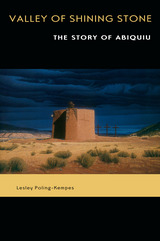 Valley of Shining Stone: The Story of Abiquiu
Lesley Poling-Kempes
University of Arizona Press, 1997 North by northwest from old Santa Fe is the winding road to Abiquiu (ah-be-cue'), Ghost Ranch, and el Valle de la Piedra Lumbre, the Valley of Shining Stone: mythical names in a near-mythical place, captured for the ages in the famous paintings of Georgia O'Keeffe.
O'Keeffe saw the magic of sandstone cliffs and turquoise skies, but her life and death here are only part of the story. Reading almost like a novel, this book spills over with other legends buried deep in time, just as some of North America's oldest dinosaur bones lie hidden beneath the valley floor. Here are the stories of Pueblo Indians who have claimed this land for generations. Here, too, are Utes, Navajos, Jicarilla Apaches, Hispanos, and Anglos—many lives tangled together, yet also separate and distinct.
Underlying these stories is the saga of Ghost Ranch itself, a last living vestige of the Old West ideal of horses, cowboys, and wide-open spaces. Readers will meet a virtual Who's Who of visitors from "dude ranch" days, ranging from such luminaries as Willa Cather, Ansel Adams, and Charles Lindbergh to World War II scientist J. Robert Oppenheimer and his colleagues, who were working on the top-secret atomic bomb in nearby Los Alamos. Moving on through the twentieth century, the book describes struggles to preserve the valley's wild beauty in the face of land development and increased tourism.
Just as the Piedra Lumbre landscape has captivated countless wayfarers over hundreds of years, so its stories cast their own spell. Indispensable for travelers, pure pleasure for history buffs and general readers, these pages are a magic carpet to a magic land: Abiquiu, Ghost Ranch, the Valley of Shining Stone.
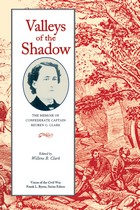 Valleys of the Shadow: The Memoir of Confederate Captain Reuben G. Clark
Willene B. Clark
University of Tennessee Press, 2002 Valleys of the Shadow is the previously unpublished account of Captain Reuben Clark’s first-hand experiences as a Confederate officer, a prisoner of war, and a post war civilian living in a conquered state.
Captain Clark was a twenty-seven-year-old Knoxville businessman when the first shots of the Civil War were fired in 1861. Like many southern gentlemen, Clark was opposed to secession but could not desert his family and friends. Enlisting as a first lieutenant in the Confederacy’s Third Tennessee Infantry Regiment, he spent his first night as a soldier on the bloody battlefield of Manasses. Clark’s recollections of Manasses and the battles and skirmishes that followed pinpoint his regiment’s activities in previously undocumented areas while providing valuable analyses of battles from a participant’s point of view and discussing the irony many soldiers felt when battle pitted them against men they had known before the war in business, politics, and society.
Captured after the battle of Morristown in the fall of 1864, Clark was jailed in Knoxville, then under Federal control. His account of the eight months he spent as a prisoner—his harsh treatment, a near-fatal illness, the false accusations of traitorous activities—offer a detailed description of the physical and legal battles of a Confederate prisoner of war fighting to obtain his freedom. Clark’s post war experiences relate his struggles as a former Rebel living in a conquered state, reflecting the deeply divided loyalties of East Tennessee that continued for years after the war’s end.
This first book in the Voices of the Civil War series shares the story of a man who remained sensible of his kinship with those he was forced to call his enemies. Written a quarter-century after the war began, Clark's memories vividly bring to life the tragedy that was the Civil War.
 Valor and Courage: The Story of the USS Block Island Escort Carriers in World War II
Benjamin J. Hruska
University of Alabama Press, 2021 Recounts the stories of the USS Block Island CVE 21 and CVE 106 and their crews, many of whom served on both ships in the Atlantic and Pacific theatres
In Valor and Courage: The Story of the USS Block Island Escort Carriers in World War II Benjamin Hruska explores the history and commemoration of the USS Block Island—or, more properly, the Block Islands, as two escort carriers bore that name during WWII. The first, CVE 21, bears the distinction of having been the only American aircraft carrier sunk in the Atlantic Theatre after being torpedoed by a German U-boat off the coast of North Africa.
Of the CVE 21’s 957 crew members, six sailors were killed and eighteen injured in the strike, and four of the Block Island’s fighter pilots were lost later in the day searching for a safe place to land their planes. When the CVE 106 was commissioned to replace its predecessor, Captain Massie Hughes successfully persuaded the Navy to keep the CVE 21’s crew together in manning the new ship. After resurrection as the CVE 106, the Block Island was assigned to the Pacific theater where it fought until the end of the war. The saga of these two ships and the crew that navigated two very different theaters of war offers a unique lens on naval strategy and engineering as it evolved during WWII, especially as pertains to the escort carrier class—generally underappreciated both in naval studies and in public memory.
Using archival materials, dozens of oral histories, primary sources, and official records, Hruska traces the life of the Block Island from the CVE 21’s construction through its missions in the Atlantic, its work as an antisubmarine hunter, its destruction, and the lasting impact of those experiences on its crew. Hruska’s study juxtaposes traditional military history with an examination of the acts of remembrance and commemoration by veterans who served on the escort carriers, how those practices evolved over time, and how the meanings of personal wartime experiences and memories gradually shifted throughout that process.
Valor: Stories
Murathan Mungan, translated from the Turkish by Aron Aji and David Gramling
Northwestern University Press, 2022 Winner of the 2021 Global Humanities Translation Prize
Among Murathan Mungan’s signature works, Cenk Hikâyeleri (Valor: Stories) has long been considered a milestone of twentieth-century Turkish literature. The six short stories in the collection reflect the author’s multiethnic background (which includes Kurdish, Arab, and Turkish heritage) and represent his lush poetics, literary breadth, and sociopolitical commitments.
Valor reimagines Shahmaran, a mythical half‑human, half‑snake figure that commonly appears in the folklore of Turkey’s southeastern provinces. Legend interweaves with the contemporary realities of ethnicity, religious dogma, gender, and sexuality. Uncovering hidden narratives within a rich and complicated culture, Mungan’s stories depict self-realization and sexual awakening as they showcase one of Turkey’s most popular literary voices.
 Valorizing the Barbarians: Enemy Speeches in Roman Historiography
By Eric Adler
University of Texas Press, 2011 With the growth of postcolonial theory in recent decades, scholarly views of Roman imperialism and colonialism have been evolving and shifting. Much recent discussion of the topic has centered on the ways in which ancient Roman historians consciously or unconsciously denigrated non-Romans. Similarly, contemporary scholars have downplayed Roman elite anxiety about their empire's expansion. In this groundbreaking new work, Eric Adler explores the degree to which ancient historians of Rome were capable of valorizing foreigners and presenting criticisms of their own society. By examining speeches put into the mouths of barbarian leaders by a variety of writers, he investigates how critical of the empire these historians could be. Adler examines pairs of speeches purportedly delivered by non-Roman leaders so that the contrast between them might elucidate each writer's sense of imperialism. Analyses of Sallust's and Trogus's treatments of the Eastern ruler Mithradates, Polybius's and Livy's speeches from Carthage's Hannibal, and Tacitus's and Cassius Dio's accounts of the oratory of the Celtic warrior queen Boudica form the core of this study. Adler supplements these with examinations of speeches from other characters, as well as contextual narrative from the historians. Throughout, Adler wrestles with broader issues of Roman imperialism and historiography, including administrative greed and corruption in the provinces, the treatment of gender and sexuality, and ethnic stereotyping.
VALU, AVX and GPU Acceleration Techniques for Parallel FDTD Methods
Wenhua Yu
The Institution of Engineering and Technology, 2014 Development of computer science techniques has significantly enhanced computational electromagnetic methods in recent years. The multi-core CPU computers and multiple CPU work stations are popular today for scientific research and engineering computing. How to achieve the best performance on the existing hardware platforms, however, is a major challenge. In addition to the multi-core computers and multiple CPU workstations, distributed computing has become a primary trend due to the low cost of the hardware and the high performance of network systems. In this book we introduce a general hardware acceleration technique that can significantly speed up FDTD simulations and their applications to engineering problems without requiring any additional hardware devices.
Valuable and Vulnerable: Children in the Hebrew Bible, especially the Elisha Cycle
Julie Faith Parker
SBL Press, 2013 Just as women in the Bible have been overlooked for much of interpretative history, children in the Bible have fascinating and compelling stories that scholars have largely ignored. This groundbreaking book focuses on children in the Hebrew Bible. The author argues that the biblical writers recognized children as different from adults and used these ideas to shape their stories. She provides conceptual and historical frameworks for understanding children and childhood, and examines Hebrew terms related to children and youth. The book introduces a new methodology of childist interpretation and applies it to the Elisha cycle (2 Kings 2-8), which contains forty-nine child characters. Combining literary insights with social-scientific evidence, the author demonstrates that children play critical roles in the world of the text as well as the culture that produced it.
Value and Income
Arthur Eli Monroe
Harvard University Press This study undertakes to explain the prices of goods and the earnings of the productive factors, which are viewed as resultants of a common process. The conventional practice of analyzing value before the problems of distribution have been considered is therefore abandoned, and the argument is built up by examining the effect of the successive introduction of land and capital into a simple labor system of production. An important role is assigned to costs of various kinds, in the sense of opportunities foregone. Though the emphasis is primarily upon conditions in contemporary capitalistic societies, considerable attention is given to the influence of various cultural and technological factors which have undergone significant changes in the course of time.
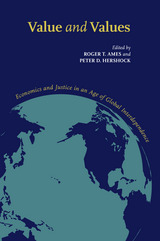 Value and Values: Economics and Justice in an Age of Global Interdependence
Edited by Roger T. Ames and Peter D. Hershock
University of Hawaii Press, 2015 The most pressing issues of the twenty-first century—climate change and persistent hunger in a world of food surpluses, to name only two—are not problems that can be solved from within individual disciplines, nation-states, or cultural perspectives. They are predicaments that can only be resolved by generating sustained and globally robust coordination across value systems. The scale of the problems and necessity for coordinated global solutions signal a world historical transit as momentous as the Industrial Revolution: a transition from the predominance of technical knowledge to that of ethical deliberation. This volume brings together leading thinkers from around the world to deliberate on how best to correlate worth (value) with what is worthwhile (values), pairing human prosperity with personal, environmental, and spiritual flourishing in a world of differing visions of what constitutes a moral life. Especially in the aftermath of what is now being called the Great Recession, awareness has mounted of the imperative to question the modern divorce of economics from ethics. While the domains of economics and ethics were from antiquity through at least the eighteenth century understood in many cultures to be coterminous and mutually entailing, the modern assumption has been that the goal of maximizing human prosperity and the aim of justly enhancing our lives as persons and as communities were functionally and practically distinct. Working from a wide array of perspectives, the contributors to this volume offer a set of challenges to the assumed independence of the quantitative and qualitative dimensions of human and planetary well-being. Reflecting on the complex interrelationship among economics, justice, and equity, the book resists “one size fits all” approaches and struggles to revitalize the marriage of economics and ethics by activating cultural differences as the basis of mutual contribution to shared human flourishing. The publication of this important collection will stimulate or extend critical debates among scholars and students working in a number of disciplines in the social sciences and humanities, including philosophy, history, environmental studies, economics, and law. Contributors: Roger T. Ames, James Behuniak Jr., Steve Bein, Nalini Bhushan, Purushottama Bilimoria, Steven Burik, Amita Chatterjee, Baoyan Cheng, Gordon Davis, Jay L. Garfield, Steven F. Geisz, Peter D. Hershock, Larry A. Hickman, Kathleen M. Higgins, Heidi M. Hurd, Thomas P. Kasulis, Workineh Kelbessa, Lori Keleher, Oliver Leaman, James McRae, Jin Y. Park, James Peterman, Naoko Saito, May Sim, Robert Smid, Paul Standish, Kenneth W. Stikkers, Karsten J. Struhl, Meera Sushila Viswanathan, Wu Shiu- Ching, Xu Di, T. Yamauchi, Yang Liuxin.
 Value and Vision in American Literature: Essays in Honor of Ray Lewis White
Joseph Candido
Ohio University Press, 1999 The widely divergent voices in this collection are united by their common interest in the American literary heritage and by their intention to redefine that heritage by altering our angle of vision or forcing us to re-examine some traditional values. Unabashedly eclectic in methodology, subject matter, and technique, the essays collected in Value and Vision in American Literature nonetheless share a common intention to recover the neglected, reassess the familiar, or challenge the orthodox.
Through their various (and sometimes contrasting) critical points of view, these essays call attention to ideas or connections that demand a reappraisal of conventional attitudes or ingrained responses. Ranging in focus from the period of the mid-nineteenth century to the present day, they treat indisputably canonical figures such as Hawthorne, Faulkner, James, Hemingway, Cather, Bellow, Porter, Welty, and Warren in the same breath and often refreshingly on the same terms with Wallace Stegner, Cormac McCarthy, Dunstan Thompson, neglected Civil War poets, and the New Formalist critics of the last ten years.
In celebration and in reflection of the important critical contribution Ray Lewis White has made to the study of American literature, these writers, each a noted scholar in the field of literary studies, present a picture of American literature that manages to value the past at the same time that it asks us to envision that past anew.
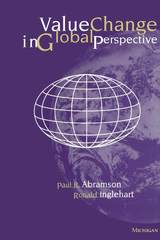 Value Change in Global Perspective
Paul R. Abramson and Ronald Inglehart
University of Michigan Press, 1995 In this pioneering work, Paul R. Abramson and Ronald Inglehart show that the gradual shift
from Materialist values (such as the desire for economic and physical security) to Post-materialist values (such as the desire for freedom, self-expression, and the quality of life) is in all likelihood a global phenomenon. Value Change in Global Perspective analyzes over thirty years worth of national surveys in European countries and presents the most comprehensive and nuanced discussion of this shift to date. By paying special attention to the way generational replacement transforms values among mass publics, the authors are able to present a comprehensive analysis of the processes through which values change.
In addition, Value Change in Global Perspective analyzes the 1990-91 World Values Survey, conducted in forty societies representing over seventy percent of the world's population. These surveys cover an unprecedentedly broad range of the economic and political spectrum, with data from low-income countries (such as China, India, Mexico, and Nigeria), newly industrialized countries (such as South Korea) and former state-socialist countries in Eastern Europe and the former Soviet Union. This data adds significant new meaning to our understanding of attitude shifts throughout the world.
Value Change in Global Perspective has been written to meet the needs of scholars and students alike. The use of percentage, percentage differences, and algebraic standardization procedures will make the results easy to understand and useful in courses in comparative politics and in public opinion.
Paul R. Abramson is Professor of Political Science, Michigan State University. Ronald Inglehart is Professor of Political Science and Program Director, Institute for Social Research, University of Michigan.
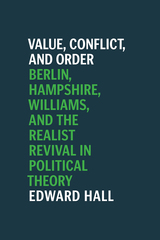 Value, Conflict, and Order: Berlin, Hampshire, Williams, and the Realist Revival in Political Theory
Edward Hall
University of Chicago Press, 2020 Is the purpose of political philosophy to articulate the moral values that political regimes would realize in a virtually perfect world and show what that implies for the way we should behave toward one another? That model of political philosophy, driven by an effort to draw a picture of an ideal political society, is familiar from the approach of John Rawls and others. Or is political philosophy more useful if it takes the world as it is, acknowledging the existence of various morally non-ideal political realities, and asks how people can live together nonetheless? The latter approach is advocated by “realist” thinkers in contemporary political philosophy. In Value, Conflict, and Order, Edward Hall builds on the work of Isaiah Berlin, Stuart Hampshire, and Bernard Williams in order to establish a political realist’s theory of politics for the twenty-first century. The realist approach, Hall argues, helps us make sense of the nature of moral and political conflict, the ethics of compromising with adversaries and opponents, and the character of political legitimacy. In an era when democratic political systems all over the world are riven by conflict over values and interests, Hall’s conception is bracing and timely.
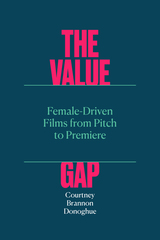 The Value Gap: Female-Driven Films from Pitch to Premiere
Courtney Brannon Donoghue
University of Texas Press, 2023 How female directors, producers, and writers navigate the challenges and barriers facing female-driven projects at each stage of filmmaking in contemporary Hollywood.
Conversations about gender equity in the workplace accelerated in the 2010s, with debates inside Hollywood specifically pointing to broader systemic problems of employment disparities and exploitative labor practices. Compounded by the devastating #MeToo revelations, these problems led to a wide-scale call for change. The Value Gap traces female-driven filmmaking across development, financing, production, film festivals, marketing, and distribution, examining the realities facing women working in the industry during this transformative moment. Drawing from five years of extensive interviews with female producers, writers, and directors at different stages of their careers, Courtney Brannon Donoghue examines how Hollywood business cultures “value” female-driven projects as risky or not bankable. Industry claims that “movies targeting female audiences don’t make money” or “women can’t direct big-budget blockbusters” have long circulated to rationalize systemic gender inequities and have served to normalize studios prioritizing the white male–driven status quo. Through a critical media industry studies lens, The Value Gap challenges this pervasive logic with firsthand accounts of women actively navigating the male-dominated and conglomerate-owned industrial landscape.
 Value in Art: Manet and the Slave Trade
Henry M. Sayre
University of Chicago Press, 2022 Art historian Henry M. Sayre traces the origins of the term “value” in art criticism, revealing the politics that define Manet’s art.
How did art critics come to speak of light and dark as, respectively, “high in value” and “low in value”? Henry M. Sayre traces the origin of this usage to one of art history’s most famous and racially charged paintings, Édouard Manet’s Olympia.
Art critics once described light and dark in painting in terms of musical metaphor—higher and lower tones, notes, and scales. Sayre shows that it was Émile Zola who introduced the new “law of values” in an 1867 essay on Manet. Unpacking the intricate contexts of Zola’s essay and of several related paintings by Manet, Sayre argues that Zola’s usage of value was intentionally double coded—an economic metaphor for the political economy of slavery. In Manet’s painting, Olympia and her maid represent objects of exchange, a commentary on the French Empire’s complicity in the ongoing slave trade in the Americas.
Expertly researched and argued, this bold study reveals the extraordinary weight of history and politics that Manet’s painting bears. Locating the presence of slavery at modernism’s roots, Value in Art is a surprising and necessary intervention in our understanding of art history.
Value in Ethics and Economics
Elizabeth Anderson
Harvard University Press, 1993 Elizabeth Anderson offers a new theory of value and rationality that rejects cost–benefit analysis in our social lives and in our ethical theories. This account of the plurality of values thus offers a new approach, beyond welfare economics and traditional theories of justice, for assessing the ethical limitations of the market. In this light, Anderson discusses several contemporary controversies involving the proper scope of the market, including commercial surrogate motherhood, privatization of public services, and the application of cost–benefit analysis to issues of environmental protection.
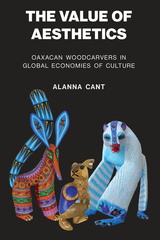 The Value of Aesthetics: Oaxacan Woodcarvers in Global Economies of Culture
By Alanna Cant
University of Texas Press, 2019 Unlike many other handicrafts in the Mexican state of Oaxaca, which have long cultural and historical trajectories, Oaxacan woodcarving began in the second half of the twentieth century and has always been done for the commercial market. In The Value of Aesthetics, Alanna Cant explores how one family’s workshop in the village of San Martín Tilcajete has become the most critically and economically successful, surpassing those of neighbors who use similar materials and techniques. The dominance of this family is tied to their ability to produce a new aesthetic that appeals to three key “economies of culture”: the tourist market for souvenirs, the national market for traditional Mexican artesanías, and the international market for indigenous art. Offering a new analytical model by which anthropologists can approach visual aesthetics and conceptualize the power of artworks as socially active objects, The Value of Aesthetics shows how aesthetic practices produce and redefine social and political relationships. By investigating the links between aesthetics and issues of production, authorship, ownership, and identity, Cant shows aesthetic change to be a process that ultimately repackages everyday life into commodified objects in Oaxaca.
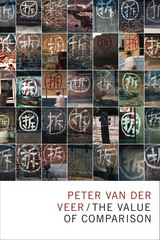 The Value of Comparison
Peter van der Veer
Duke University Press, 2016 In The Value of Comparison Peter van der Veer makes a compelling case for using comparative approaches in the study of society and for the need to resist the simplified civilization narratives popular in public discourse and some social theory. He takes the quantitative social sciences and the broad social theories they rely on to task for their inability to question Western cultural presuppositions, demonstrating that anthropology's comparative approach provides a better means to understand societies. This capacity stems from anthropology's engagement with diversity, its fragmentary approach to studying social life, and its ability to translate difference between cultures. Through essays on topics as varied as iconoclasm, urban poverty, Muslim immigration, and social exclusion van der Veer highlights the ways that studying the particular and the unique allows for gaining a deeper knowledge of the whole without resorting to simple generalizations that elide and marginalize difference.
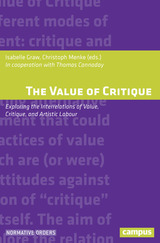 The Value of Critique: Exploring the Interrelations of Value, Critique, and Artistic Labour
Edited by Isabelle Graw and Christoph Menke
Campus Verlag, 2019 The Value of Critique casts its gaze on the two dominant modes of passing judgment in art—critique and value (or evaluation). The act of critique has long held sway in the world of art theory but has recently been increasingly abandoned in favor of evaluation, which advocates alternate modes of judgment aimed at finding the intrinsic “value” of a given work rather than picking apart its intentions and relative success. This book’s contributors explore the relationship between these two practices, finding that one cannot exist with the other. As soon as a critic decides an object is worthy enough of their interest and time to critique it, they have imbued that object with a certain value. Similarly, theories of value are typically marked by a critical impetus: as much as critique takes part in the construction of evaluations, bestowing something with value can then trigger critiques. Assembling essays from an international array of authors, this book is the first to put value, critique, and artistic labor in conversation with one another, making clear just how closely all three are related.
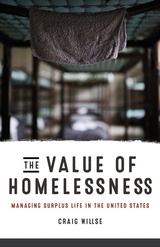 The Value of Homelessness: Managing Surplus Life in the United States
Craig Willse
University of Minnesota Press, 2015 It is all too easy to assume that social service programs respond to homelessness, seeking to prevent and understand it. The Value of Homelessness, however, argues that homelessness today is an effect of social services and sciences, which shape not only what counts as such but what will?or ultimately won’t?be done about it. Through a history of U.S. housing insecurity from the 1930s to the present, Craig Willse traces the emergence and consolidation of a homeless services industry. How to most efficiently allocate resources to control ongoing insecurity has become the goal, he shows, rather than how to eradicate the social, economic, and political bases of housing needs. Drawing on his own years of work in homeless advocacy and activist settings, as well as interviews conducted with program managers, counselors, and staff at homeless services organizations in New York, Los Angeles, San Francisco, and Seattle, Willse provides the first analysis of how housing insecurity becomes organized as a governable social problem. An unprecedented and powerful historical account of the development of contemporary ideas about homelessness and how to manage homelessness, The Value of Homelessness offers new ways for students and scholars of social work, urban inequality, racial capitalism, and political theory to comprehend the central role of homelessness in governance and economy today.
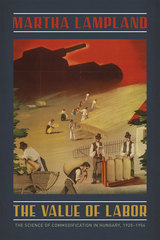 The Value of Labor: The Science of Commodification in Hungary, 1920-1956
Martha Lampland
University of Chicago Press, 2016 At the heart of today’s fierce political anger over income inequality is a feature of capitalism that Karl Marx famously obsessed over: the commodification of labor. Most of us think wage-labor economics is at odds with socialist thinking, but as Martha Lampland explains in this fascinating look at twentieth-century Hungary, there have been moments when such economics actually flourished under socialist regimes. Exploring the region’s transition from a capitalist to a socialist system—and the economic science and practices that endured it—she sheds new light on the two most polarized ideologies of modern history.
Lampland trains her eye on the scientific claims of modern economic modeling, using Hungary’s unique vantage point to show how theories, policies, and techniques for commodifying agrarian labor that were born in the capitalist era were adopted by the socialist regime as a scientifically designed wage system on cooperative farms. Paying attention to the specific historical circumstances of Hungary, she explores the ways economists and the abstract notions they traffic in can both shape and be shaped by local conditions, and she compellingly shows how labor can be commodified in the absence of a labor market. The result is a unique account of economic thought that unveils hidden but necessary continuities running through the turbulent twentieth century.
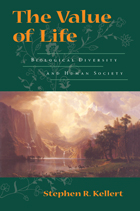 The Value of Life: Biological Diversity And Human Society
Stephen R. Kellert
Island Press, 1996 The Value of Life is an exploration of the actual and perceived importance of biological diversity for human beings and society. Stephen R. Kellert identifies ten basic values, which he describes as biologically based, inherent human tendencies that are greatly influenced and moderated by culture, learning, and experience. Drawing on 20 years of original research, he considers: - the universal basis for how humans value nature
- differences in those values by gender, age, ethnicity, occupation, and geographic location
- how environment-related activities affect values
- variation in values relating to different species
- how vlaues vary across cultures
- policy and management implications
Throughout the book, Kellert argues that the preservation of biodiversity is fundamentally linked to human well-being in the largest sense as he illustrates the importance of biological diversity to the human sociocultural and psychological condition.
 The Value of Names and Other Plays
Jeffrey Sweet
Northwestern University Press, 2008 Spanning a quarter of a century, this collection of plays demonstrates author Jeffrey Sweet’s eye for the drama of human relationships. Sweet works with sensitivity and irony to confront both personal politics and the impact of historical change. These nine works, taken together, present a playwright who extends the struggles of his small circles of characters to his audience and humanity in general. The title work, first mounted in 1982, is a comedy-drama about the aftermath of the blacklist whose continued relevance makes it a frequently produced play today. The family drama Porch suggests larger social changes through the interaction of a small-town shopkeeper and his defiant daughter. The lauded American Enterprise, set in the Chicago of the robber barons, is a song-filled true story about a millionaire whose stubborn idealism leads to disaster. Stay Till Morning is a rueful comedy about sex and accommodation in the Florida Keys. The three plays that grew out of his fascination with the effects of World War II—Berlin ’45, Court-Martial at Fort Devens, and The Action Against Sol Schumann—dramatize the ways in which that conflict transformed private fates. Each script is accompanied by an extended introduction from the playwright as well as complete performance notes.
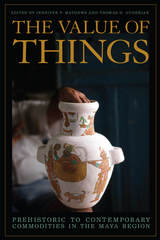 The Value of Things: Prehistoric to Contemporary Commodities in the Maya Region
Edited by Jennifer P. Mathews and Thomas H. Guderjan
University of Arizona Press, 2017 Jade, stone tools, honey and wax, ceramics, rum, land. What gave these commodities value in the Maya world, and how were those values determined? What factors influenced the rise and fall of a commodity’s value? The Value of Things examines the social and ritual value of commodities in Mesoamerica, providing a new and dynamic temporal view of the roles of trade of commodities and elite goods from the prehistoric Maya to the present. Editors Jennifer P. Mathews and Thomas H. Guderjan begin the volume with a review of the theoretical literature related to the “value of things.” Throughout the volume, well-known scholars offer chapters that examine the value of specific commodities in a broad time frame—from prehistoric, colonial, and historic times to the present. Using cases from the Maya world on both the local level and the macro-regional, contributors look at jade, agricultural products (ancient and contemporary), stone tools, salt, cacao (chocolate), honey and wax, henequen, sugarcane and rum, land, ceramic (ancient and contemporary), and contemporary tourist handicrafts. Each chapter author looks into what made their specific commodity valuable to ancient, historic, and contemporary peoples in the Maya region. Often a commodity’s worth goes far beyond its financial value; indeed, in some cases, it may not even be viewed as something that can be sold. Other themes include the rise and fall in commodity values based on perceived need, rarity or overproduction, and change in available raw materials; the domestic labor side of commodities, including daily life of the laborers; and relationships between elites and nonelites in production. Examining, explaining, and theorizing how people ascribe value to what they trade, this scholarly volume provides a rich look at local and regional Maya case studies through centuries of time.
Contributors:
Rani T. Alexander
Dean E. Arnold
Timothy Beach
Briana Bianco
Steven Bozarth
Tiffany C. Cain
Scott L. Fedick
Thomas H. Guderjan
John Gust
Eleanor Harrison-Buck
Brigitte Kovacevich
Samantha Krause
Joshua J. Kwoka
Richard M. Leventhal
Sheryl Luzzadder-Beach
Jennifer P. Mathews
Heather McKillop
Allan D. Meyers
Gary Rayson
Mary Katherine Scott
E. Cory Sills
Value-based Learning Healthcare Systems: Integrative modeling and simulation
Bernard P. Zeigler
The Institution of Engineering and Technology, 2019 Achieving value-based healthcare, increasing quality, reducing cost, and spreading access, has proven to be extremely challenging, in part due to research that is siloed and largely focused on singular risk factors, ineffective care coordination resulting from service fragmentation, and costly unintended consequences of reform that have emerged due to the complexity of healthcare systems. Understanding the behaviour of the overall system is becoming a major concern among healthcare managers and decision-makers intent on increasing value for their systems.
 Value-Focused Thinking: A Path to Creative Decisionmaking
Ralph L. Keeney
Harvard University Press, 1992 The standard way of thinking about decisions is backwards, says Ralph Keeney: people focus first on identifying alternatives rather than on articulating values. A problem arises and people react, placing the emphasis on mechanics and fixed choices instead of on the objectives that give decisionmaking its meaning. In this book, Keeney shows how recognizing and articulating fundamental values can lead to the identification of decision opportunities and the creation of better alternatives. The intent is to be proactive and to select more attractive decisions to ponder before attempting any solutions.
Keeney describes specific procedures for articulating values by identifying and structuring objectives qualitatively, and he shows how to apply these procedures in various cases. He then explains how to quantify objectives using simple models of values. Such value analysis, Keeney demonstrates, can yield a full range of alternatives, thus converting decision problems into opportunities. This approach can be used to uncover hidden objectives, to direct the collection of information, to improve communication, to facilitate collective decisionmaking, and to guide strategic thinking. To illustrate these uses, Keeney shows how value-focused thinking works in many business contexts, such as designing an integrated circuit tester and managing a multibillion-dollar utility company; in government contexts, such as planning future NASA space missions and deciding how to transport nuclear waste to storage sites; and in personal contexts, such as choosing career moves and making wise health and safety decisions.
An incisive, applicable contribution to the art and science of decisionmaking, Value-Focused Thinking will be extremely useful to anyone from consultants and managers to systems analysts and students.
 Value-Free Science?: Purity and Power in Modern Knowledge
Robert Proctor
Harvard University Press, 1991 Why have scientists shied away from politics, or defended their work as value free? How has the ideal of neutrality come to dominate the world of science? These are some of the central questions that Robert Proctor addresses in his study of the politics of modern science.
Value-Free Science? emphasizes the importance of understanding the political origins and impact of scientific ideas. Proctor lucidly demonstrates how value-neutrality is a reaction to larger political developments, including the use of science by government and industry, the specialization of professional disciplines, and the efforts to stifle intellectual freedoms or to politicize the world of the academy.
The first part of the book traces the origins of value-neutrality prior to the eighteenth century. Plato and Aristotle saw contemplative thought as superior to practical action, and this separation of theory and practice is still invoked today in defense of "neutral science." In the seventeenth century the Baconian search for useful knowledge allowed a new and closer tie between theory and practice, but it also isolated moral knowledge from natural philosophy. Another version of neutrality was introduced by the mechanical conception of the universe, in which the idea of a benevolent, human-centered cosmos was replaced with a "devalorized" view of nature.
The central part of the book explores the exclusion of politics and morals with the emergence of the social sciences. Proctor highlights the case of Germany, where the ideal of value-neutrality was first articulated in modern form by social scientists seeking to attack or defend Marxism, feminism, and other social movements. He traces the rise and fall of positivist ethical and economic theory, showing that arguments for value-free science often mask concrete political maneuvers. Finally, he reviews critiques of science that have been voiced in recent debates over critical issues in agricultural science, military research, health and medicine, and biological determinism.
This provocative book will interest anyone seeking ways to reconcile the ideals of scientific freedom and social responsibility.
Values and Assumptions in American Labor Law
James B. Atleson
University of Massachusetts Press, 1983 Chosen as a Lawyer's Literary Club Selection, this book looks behind stated legal rules and doctrines in the field of labor law to clearly formulate the often hidden values and assumptions that motivate those who make labor law decisions. The author demonstrates that the "received wisdom" in labor law, which is that decisions are based on analyses of the rational implications of statutory policy, language, or legislative history, fails to account for the actual history of decision-making, particularly the interpretation of the Wagner Act of 1935 that established collective bargaining and the National Labor Relations Board. Through close interpretation, Atleson shows the legal decisions that have been reached are better explained by such factors as notional of inherent property rights, the need for capital mobility, and the interest in continued productivity.
 Values at the End of Life: The Logic of Palliative Care
Roi Livne
Harvard University Press, 2019 This insightful study examines the deeply personal and heart-wrenching tensions among financial considerations, emotional attachments, and moral arguments that motivate end-of-life decisions.
America’s health care system was built on the principle that life should be prolonged whenever possible, regardless of the costs. This commitment has often meant that patients spend their last days suffering from heroic interventions that extend their life by only weeks or months. Increasingly, this approach to end-of-life care is coming under scrutiny, from a moral as well as a financial perspective. Sociologist Roi Livne documents the rise and effectiveness of hospice and palliative care, and growing acceptance of the idea that a life consumed by suffering may not be worth living.
Values at the End of Life combines an in-depth historical analysis with an extensive study conducted in three hospitals, where Livne observed terminally ill patients, their families, and caregivers negotiating treatment. Livne describes the ambivalent, conflicted moments when people articulate and act on their moral intuitions about dying. Interviews with medical staff allowed him to isolate the strategies clinicians use to help families understand their options. As Livne discovered, clinicians are advancing the idea that invasive, expensive hospital procedures often compound a patient’s suffering. Affluent, educated families were more readily persuaded by this moral calculus than those of less means.
Once defiant of death—or even in denial—many American families and professionals in the health care system are beginning to embrace the notion that less treatment in the end may be better treatment.
 The Values Campaign?: The Christian Right and the 2004 Elections
John C. Green, Mark J. Rozell, and Clyde Wilcox, Editors
Georgetown University Press, 2006 The Christian Right never ceases to surprise professional observers of American politics.
With the Christian coalition in disarray, many expected that the movement would play less of a role in the 2004 elections. But when exit polls reported that "moral values" were the most commonly cited reason for presidential vote choice, pundits immediately proclaimed the importance of the "values vote." Yet the role of the Christian Right, of statewide referenda on same-sex marriage, and of religious mobilization remained the subject of debate.
The Values Campaign? The Christian Right and the 2004 Elections reaches well beyond the instant analyses of the post-election period to provide an assessment of the role of the religious right in 2004. The contributors to this volume are among the leading scholars of religion and politics in the United States, and many have contributed for over a decade to ongoing discussions of the role played by the religious right in national elections. The authors consider national mobilization and issues, and also explore the role of the Christian Right in specific states. Their evaluations contend that the "values campaign" was not an aberration but a consistent pattern of national politics, and that moral traditionalism will likely continue to be a significant factor in future elections. A timely study of the 2004 elections, this volume will appeal to scholars and observers of electoral politics, state politics, and religion and politics.
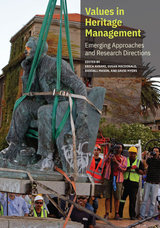 Values in Heritage Management: Emerging Approaches and Research Directions
Erica Avrami
J. Paul Getty Trust, The, 2019 Bringing together leading conservation scholars and professionals from around the world, this volume offers a timely look at values-based approaches to heritage management.
Over the last fifty years, conservation professionals have confronted increasingly complex political, economic, and cultural dynamics. This volume, with contributions by leading international practitioners and scholars, reviews how values-based methods have come to influence conservation, takes stock of emerging approaches to values in heritage practice and policy, identifies common challenges and related spheres of knowledge, and proposes specific areas in which the development of new approaches and future research may help advance the field.
The free online edition of this open-access book is available at www.getty.edu/publications/heritagemanagement/ and includes zoomable illustrations. Also available are free PDF, EPUB, and Kindle/MOBI downloads of the book.
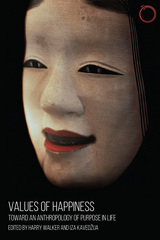 Values of Happiness: Toward an Anthropology of Purpose in Life
Edited by Iza Kavedžija and Harry Walker
HAU, 2016 How people conceive of happiness reveals much about who they are and the values they hold dear. Drawing on ethnographic insights from diverse field sites around the world, this book offers a unique window onto the ways in which people grapple with fundamental questions about how to live and what it means to be human. Developing a distinctly anthropological approach concerned less with gauging how happy people are than with how happiness figures as an idea, mood, and motive in everyday life, the book explores how people strive to live well within challenging or even hostile circumstances.
The contributors explore how happiness intersects with dominant social values as well as an array of aims and aspirations that are potentially conflicting, demonstrating that not every kind of happiness is seen as a worthwhile aim or evaluated in positive moral terms. In tracing this link between different conceptions of happiness and their evaluations, the book engages some of the most fundamental questions concerning human happiness: What is it and how is it achieved? Is happiness everywhere a paramount value or aim in life? How does it relate to other ideas of the good? What role does happiness play in orienting peoples’ desires and life choices? Taking these questions seriously, the book draws together considerations of meaning, values, and affect, while recognizing the diversity of human ends.
 Values-Based Multinational Management: Achieving Enterprise Sustainability through a Human Rights Strategy
Lee A. Tavis
University of Notre Dame Press, 2009
In this timely book, Lee Tavis and Timothy Tavis contend that the values dimension of the actions of multinational firms is becoming increasingly important, given the worldwide integration of economies and peoples. The digital revolution has broadened the reach of globalization and created an informed society that demands higher standards of behavior from the business enterprise; at the same time, multinational corporations have gained power often comparable to that of the nation state, and global society is in need of widely accepted, enduring social and ethical standards. Tavis and Tavis argue that multinational firms must embrace an ethically pro-active stance in their own long-term interests. A strategy of supporting universal human rights, often in partnership with NGOs, offers the greatest potential for success.
Values-Based Multinational Management provides an agenda for practical action, with special reference to the United Nations Universal Declaration of Human Rights and the United Nations Global Compact. It informs and addresses the values concerns of multinational business managers. It presents its examples and analyses in a clear and concise manner and will be of use both to practitioners in the business community and students and scholars of business ethics.
"Values-Based Multinational Management employs a novel approach and a variety of perspectives that make it a very valuable addition to business ethics literature. This is excellent, helpful material that discusses an important way in which human rights may fit with globalization." --Timothy L. Fort, George Washington University
"More and more business executives understand that society increasingly judges corporate performance through a broad social lens that includes ideas of corporate social responsibility and business ethics. They are now ready to position their firms to meet these requirements. This volume is a thoughtful discussion of the ways in which the United Nations Global Compact can serve this purpose through a long-term human rights strategy and, importantly, how that strategy can be implemented within the firm." --Georg Kell, UN Global Compact
"This book underlines the fact that--despite the importance of institutional and social ethics--the individual ethics, if not virtue ethics, of corporate leaders remain central. Of highest importance is the authors' emphasis that no individuals--in whatever professional or personal role--can escape the fact that they are responsible for the outcome of their actions. It is to be hoped that this book revitalizes a facet of the debate on business ethics and corporate responsibility that has been neglected for too long." --Klaus M. Leisinger, Novartis Foundation for Sustainable Development
Values-Driven Authentic Leadership: Essential Lessons from the LeadershipWWEB Podcast Series
Andrew Braham
Epic Books, 2022 In Values-Driven Authentic Leadership: Essential Lessons from the LeadershipWWEB Podcast Series, Andrew Braham, Matthew Waller, and John English examine the intersection of values, authenticity, and leadership. Drawing upon numerous conversations with a wide range of professional leaders, including several Fortune 500 CEOs, the authors identify six key opportunities for leadership growth: having a mentor, being in a group, knowing yourself, navigating transitions, being a mentor, and values and company culture. By sharing their own experiences, Braham, Waller, English, and the leaders they interview bring the facets of authentic leadership to life with personal insight. Whether you are a mentor or a mentee, a student or a professional, Values-Driven Authentic Leadership will help guide you on your own leadership journey.
 Valuing Children: Rethinking the Economics of the Family
Nancy Folbre
Harvard University Press, 2010 Nancy Folbre challenges the conventional economist's assumption that parents have children for the same reason that they acquire pets--primarily for the pleasure of their company. Children become the workers and taxpayers of the next generation, and "investments" in them offer a significant payback to other participants in the economy.
Yet parents, especially mothers, pay most of the costs. The high price of childrearing pushes many families into poverty, often with adverse consequences for children themselves.
Parents spend time as well as money on children. Yet most estimates of the "cost" of children ignore the value of this time. Folbre provides a startlingly high but entirely credible estimate of the value of parental time per child by asking what it would cost to purchase a comparable substitute for it.
She also emphasizes the need for better accounting of public expenditure on children over the life cycle and describes the need to rethink the very structure and logic of the welfare state. A new institutional structure could promote more cooperative, sustainable, and efficient commitments to the next generation.
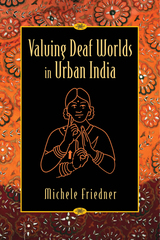 Valuing Deaf Worlds in Urban India
Michele Friedner
Rutgers University Press, 2015 Although it is commonly believed that deafness and disability limits a person in a variety of ways, Valuing Deaf Worlds in Urban India describes the two as a source of value in postcolonial India. Michele Friedner argues that the experiences of deaf people offer an important portrayal of contemporary self-making and sociality under new regimes of labor and economy in India. Friedner contends that deafness actually becomes a source of value for deaf Indians as they interact with nongovernmental organizations, with employers in the global information technology sector, and with the state. In contrast to previous political economic moments, deaf Indians increasingly depend less on the state for education and employment, and instead turn to novel and sometimes surprising spaces such as NGOs, multinational corporations, multilevel marketing businesses, and churches that attract deaf congregants. They also gravitate towards each other. Their social practices may be invisible to outsiders because neither the state nor their families have recognized Indian Sign Language as legitimate, but deaf Indians collectively learn sign language, which they use among themselves, and they also learn the importance of working within the structures of their communities to maximize their opportunities. Valuing Deaf Worlds in Urban India analyzes how diverse deaf people become oriented toward each other and disoriented from their families and other kinship networks. More broadly, this book explores how deafness, deaf sociality, and sign language relate to contemporary society.
Valuing Health for Policy: An Economic Approach
Edited by George Tolley, Donald Kenkel, and Robert Fabian
University of Chicago Press, 1994 How much should citizens invest in promoting health, and how should resources be allocated to cover the costs? A major contribution to economic approaches to the value of health, this volume brings together classic and up-to-date research by economists and public health experts on theories and measurements of health values, providing useful information for shaping public policy.
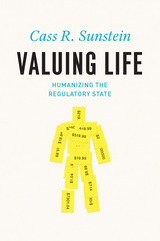 Valuing Life: Humanizing the Regulatory State
Cass R. Sunstein
University of Chicago Press, 2014 The White House Office of Information and Regulatory Affairs (OIRA) is the United States’s regulatory overseer. In Valuing Life, Cass R. Sunstein draws on his firsthand experience as the Administrator of OIRA from 2009 to 2012 to argue that we can humanize regulation—and save lives in the process.
As OIRA Administrator, Sunstein helped oversee regulation in a broad variety of areas, including highway safety, health care, homeland security, immigration, energy, environmental protection, and education. This background allows him to describe OIRA and how it works—and how it can work better—from an on-the-ground perspective. Using real-world examples, many of them drawn from today’s headlines, Sunstein makes a compelling case for improving cost-benefit analysis, a longtime cornerstone of regulatory decision-making, and for taking account of variables that are hard to quantify, such as dignity and personal privacy. He also shows how regulatory decisions about health, safety, and life itself can benefit from taking into account behavioral and psychological research, including new findings about what scares us, and what does not. By better accounting for people’s fallibility, Sunstein argues, we can create regulation that is simultaneously more human and more likely to achieve its goals.
In this highly readable synthesis of insights from law, policy, economics, and psychology, Sunstein breaks down the intricacies of the regulatory system and offers a new way of thinking about regulation that incorporates human dignity– and an insistent focus on the consequences of our choices.
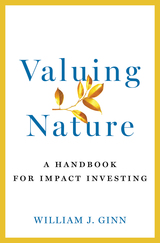 Valuing Nature: A Handbook for Impact Investing
William J. Ginn
Island Press, 2020 As the world faces unprecedented challenges such as climate change and biodiversity loss, the resources needed far outstrip the capabilities of nonprofits and even governments. Yet there are seeds of hope—and much of that hope comes from the efforts of the private sector. Impact investing is rapidly becoming an essential tool, alongside philanthropy and government funding, in tackling these major problems. Valuing Nature presents a new set of nature-based investment areas to help conservationists and investors work together.
NatureVest founder William Ginn outlines the emerging private sector investing opportunities in natural assets such as green infrastructure, forests, soils, and fisheries. The first part of Valuing Nature examines the scope of nature-based impact investing while also presenting a practical overview of its limitations and the challenges facing the private sector. The second part of the book offers tools for investors and organizations to consider as they develop their own projects and tips on how nonprofits can successfully navigate this new space. Case studies from around the world demonstrate how we can use private capital to achieve more sustainable uses of our natural resources without the unintended consequences plaguing so many of our current efforts.
Valuing Nature provides a roadmap for conservation professionals, nonprofit managers, and impact investors seeking to use market-based strategies to improve the management of natural systems.
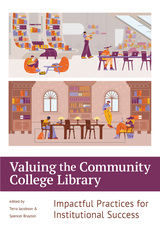 Valuing the Community College Library: Impactful Practices for Institutional Success
Terra Jacobson
Association of College & Research Libraries, 2025 Sharing the work of our community college libraries—our efforts, stories, and how we’re advancing the institution—and advocating to our peers and administration can boost the libraries’ role on our unique campuses.
Valuing the Community College Library: Impactful Practices for Institutional Success provides a holistic approach to exhibiting community college library value through historical context, practical applications, and future thinking. Through case studies, editorials from administrators, and practical approaches, it addresses why community college libraries exist and should exist, and the nuanced approaches to how library workers situate themselves at their institutions.
Community college libraries need to provide access to content, people, space, and technology and offer instruction, but can also serve as an outreach arm in advancing the mission of open enrollment and affordable access to higher education. Valuing the Community College Library can help you be an advocate for your library on campus and in your community.
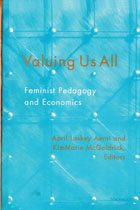 Valuing Us All: Feminist Pedagogy and Economics
April Laskey Aerni and KimMarie McGoldrick, Editors
University of Michigan Press, 1999 A basic knowledge of economics is critical for making informed decisions in today's world. By offering courses and materials that are more relevant to our students' lives and encouraging more active participation in the discovery of economic concepts and theories, we promote the development of informed citizens.
This volume collects pioneering work on the integration of feminist pedagogy in economics. Part 1 introduces a vision of feminist pedagogy, explains the importance of developing feminist pedagogy in economics, and proposes a model for achieving feminist pedagogy in economics that suggests changes in both course content and teaching methods. Part 2 reveals how current course content is narrowly defined and demonstrates how content can be altered to be more inclusive. Included are an analysis of current textbook treatments and examples of broadening discussions of labor supply models, U.S. poverty, and stereotyping, as well as general overviews of macro- and microeconomic courses. Part 3 reports on current disparities in economics education by gender and provides alternative teaching strategies for correcting this problem, including the service learning, peer review, e-mail discussion lists, case studies, internships, and collaborative learning.
The contributors incorporate their vision of a new pedagogy with important economic concepts emphasizing equity as well as efficiency, cooperation as well as competition, and inter-dependence as well as independence. The volume will be a valuable resource for college faculty teaching economics in the United States, as well as to those teaching in related disciplines who want to design exercises that promote a more inclusive classroom environment through changes in both content and teaching methods.
April Laskey Aerni is Associate Professor of Economics, Nazareth College of Rochester. KimMarie McGoldrick is Associate Professor of Economics, University of Richmond.
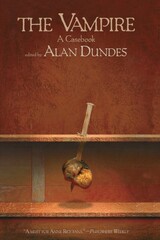 The Vampire: A Casebook
Edited by Alan Dundes
University of Wisconsin Press, 1998 Vampires are the most fearsome and fascinating of all creatures of folklore. For the first time, detailed accounts of the vampire and how its tradition developed in different cultures are gathered in one volume by eminent folklorist Alan Dundes. Eleven leading scholars from the fields of Slavic studies, history, anthropology, and psychiatry unearth the true nature of the vampire from its birth in graveyard lore to the modern-day psychiatric patient with a penchant for drinking blood.
The Vampire: A Casebook takes this legend out of the realm of literature and film and back to its dark beginnings in folk traditions. The essays examine the history of the word “vampire;” Romanian vampires; Greek vampires; Serbian vampires; the physical attributes of vampires; the killing of vampires; and the possible psychoanalytic underpinnings of vampires. Much more than simply a scary creature of the human imagination, the vampire has been and continues to haunt the lives of all those who encounter it—in reality or in fiction.
The Vampire in Nineteenth Century English Literature
Carol A. Senf
University of Wisconsin Press, 1988 Carol A. Senf traces the vampire’s evolution from folklore to twentieth-century popular culture and explains why this creature became such an important metaphor in Victorian England. This bloodsucker who had stalked the folklore of almost every culture became the property of serious artists and thinkers in Victorian England, including Charlotte and Emily Brontë, George Eliot, Charles Dickens, Karl Marx, and Friedrich Engels. People who did not believe in the existence of vampires nonetheless saw numerous metaphoric possibilities in a creature from the past that exerted pressure on the present and was often threatening because of its sexuality.
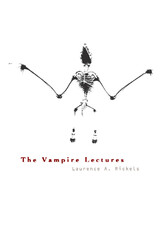 Vampire Lectures
Laurence A. Rickels
University of Minnesota Press, 1999 A wild and wide-ranging “psycho-history” of the vampire. A wild and wide-ranging “psycho-history” of the vampire. Bela Lugosi may-as the eighties gothic rock band Bauhaus sang-be dead, but the vampire lives on. A nightmarish figure dwelling somewhere between genuine terror and high camp, a morbid repository for the psychic projections of diverse cultures, an endlessly recyclable mass-media icon, the vampire is an enduring object of fascination, fear, ridicule, and reverence. In The Vampire Lectures, Laurence A. Rickels sifts through the rich mythology of vampirism, from medieval folklore to Marilyn Manson, to explore the profound and unconscious appeal of the undead.Based on the course Rickels has taught at the University of California, Santa Barbara, for several years (a course that is itself a cult phenomenon on campus), The Vampire Lectures reflects Rickels’s unique lecture style and provides a lively history of vampirism in legend, literature, and film. Rickels unearths a trove that includes eyewitness accounts of vampire attacks; burial rituals and sexual taboos devised to keep vampirism at bay; Hungarian countess Elisabeth Bathory’s use of girls’ blood in her sadistic beauty regimen; Bram Stoker’s Dracula, with its turn-of-the-century media technologies; F. W. Murnau’s haunting Nosferatu; and crude, though intense, straight-to-video horror films such as Subspecies. He makes intuitive, often unexpected connections among these sometimes wildly disparate sources.More than a compilation of vampire lore, however, The Vampire Lectures makes an original and intellectually rigorous contribution to literary and psychoanalytic theory, identifying the subconscious meanings, complex symbolism, and philosophical arguments-particularly those of Marx, Freud, and Nietzsche-embedded in vampirism and gothic literature.ISBN 0-8166-3391-6 Cloth £34.50 $49.95xxISBN 0-8166-3392-4 Paper £14.00 $19.95376 Pages 5 7/8 x 9 SeptemberTranslation inquiries: University of Minnesota Press
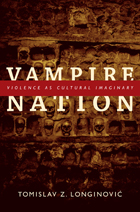 Vampire Nation: Violence as Cultural Imaginary
Tomislav Z. Longinovi
Duke University Press, 2011 Vampire Nation is a nuanced analysis of the cultural and political rhetoric framing ‘the serbs’ as metaphorical vampires in the last decades of the twentieth century, as well as the cultural imaginaries and rhetorical mechanisms that inform nationalist discourses more broadly. Tomislav Z. Longinović points to the Gothic associations of violence, blood, and soil in the writings of many intellectuals and politicians during the 1990s, especially in portrayals by the U.S.-led Western media of ‘the serbs’ as a vampire nation, a bloodsucking parasite on the edge of European civilization. Interpreting oral and written narratives and visual culture, Longinović traces the early modern invention of ‘the serbs’ and the category’s twentieth-century transformations. He describes the influence of Bram Stoker’s nineteenth-century novel Dracula on perceptions of the Balkan region and reflects on representations of hybrid identities and their violent destruction in the works of the region’s most prominent twentieth-century writers. Concluding on a hopeful note, Longinović considers efforts to imagine a new collective identity in non-nationalist terms. These endeavors include the emigrant Yugoslav writer David Albahari’s Canadian Trilogy and Cyber-Yugoslavia, a mock nation-state with “citizens” in more than thirty countries.
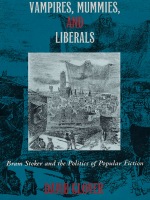 Vampires, Mummies and Liberals: Bram Stoker and the Politics of Popular Fiction
David Glover
Duke University Press, 1996 Nearly a hundred years after its debut in 1897, Dracula is still one of the most popular of all Gothic narratives, always in print and continually adapted for stage and screen. Paradoxically, David Glover suggests, this very success has obscured the historical conditions and authorial circumstances of the novel’s production. By way of a long overdue return to the novels, short stories, essays, journalism, and correspondence of Bram Stoker, Vampires, Mummies, and Liberals reconstructs the cultural and political world that gave birth to Dracula. To bring Stoker’s life into productive relationship with his writing, Glover offers a reading that locates the author within the changing commercial contours of the late-Victorian public sphere and in which the methods of critical biography are displaced by those of cultural studies.
Glover’s efforts reveal a writer who was more wide-ranging and politically engaged than his current reputation suggests. An Irish Protestant and nationalist, Stoker nonetheless drew his political inspiration from English liberalism at a time of impending crisis, and the tradition’s contradictions and uncertainties haunt his work. At the heart of Stoker’s writing Glover exposes a preoccupation with those sciences and pseudo-sciences—from physiognomy and phrenology to eugenics and sexology—that seemed to cast doubt on the liberal faith in progress. He argues that Dracula should be read as a text torn between the stances of the colonizer and the colonized, unable to accept or reject the racialized images of backwardness that dogged debates about Irish nationhood. As it tracks the phantasmatic form given to questions of character and individuality, race and production, sexuality and gender, across the body of Stoker’s writing, Vampires, Mummies, and Liberals draws a fascinating portrait of an extraordinary transitional figure.
Combining psychoanalysis and cultural theory with detailed historical research, this book will be of interest to scholars of Victorian and Irish fiction and to those concerned with cultural studies and popular culture.
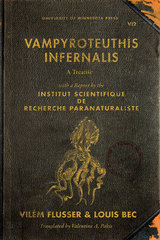 Vampyroteuthis Infernalis: A Treatise, with a Report by the Institut Scientifique de Recherche Paranaturaliste
Vilém Flusser
University of Minnesota Press, 2012 How far apart are humans from animals—even the “vampire squid from hell”? Playing the scientist/philosopher/provocateur, Vilém Flusser uses this question as a springboard to dive into a literal and a philosophical ocean. “The abyss that separates us” from the vampire squid (or vampire octopus, perhaps, since Vampyroteuthis infernalis inhabits its own phylogenetic order somewhere between the two) “is incomparably smaller than that which separates us from extraterrestrial life, as imagined in science fiction and sought by astrobiologists,” Flusser notes at the outset of the expedition. Part scientific treatise, part spoof, part philosophical discourse, part fable, Vampyroteuthis Infernalis gives its author ample room to ruminate on human—and nonhuman—life. Considering the human condition along with the vampire squid/octopus condition seems appropriate because “we are both products of an absurd coincidence . . . we are poorly programmed beings full of defects,” Flusser writes. Among other things, “we are both banished from much of life’s domain: it into the abyss, we onto the surfaces of the continents. We have both lost our original home, the beach, and we both live in constrained conditions.” Thinking afresh about the life of an “other”—as different from ourselves as the vampire squid/octopus—complicates the linkages between animality and embodiment. Odd, and strangely compelling, Vampyroteuthis Infernalis offers up a unique posthumanist philosophical understanding of phenomenology and opens the way for a non-philosophy of life.
 Van Dorn: The Life and Times of a Confederate General
Robert G. Hartje
Vanderbilt University Press, 1967 In 1861 Mississippian Earl Van Dorn entered the Confederate Army, heralded as one of its most gifted officers. Few men of his age had more military experience. Van Dorn had already distinguished himself in the Mexican War and in the Indian Wars along the Texas-Oklahoma border. His friend Jefferson Davis expected great things of him.
When it came to large-scale military initiatives, however, Van Dorn was remarkable for his failures. His tactical blunders at the battles of Pea Ridge, Arkansas, and Corinth, Mississippi, contributed greatly to the end of the Confederate military advantage in the Civil War.
The intrigue and scandals that figured in his personal life, even at the height of the War, led directly to his murder and the mystery that still surrounds it. Van Dorn’s dishonorable death concludes Hartje’s fascinating account of a checkered career and the role Earl Van Dorn played in the great tragedy of the Civil War.
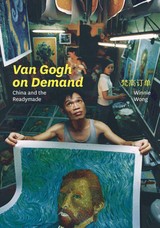 Van Gogh on Demand: China and the Readymade
Winnie Won Yin Wong
University of Chicago Press, 2014 In a manufacturing metropolis in south China lies Dafen, an urban village that famously houses thousands of workers who paint van Goghs, Da Vincis, Warhols, and other Western masterpieces for the world market, producing an astonishing five million paintings a year. To write about work and life in Dafen, Winnie Wong infiltrated this world, first investigating the work of conceptual artists who made projects there; then working as a dealer; apprenticing as a painter; surveying wholesalers and retailers in Europe, East Asia and North America; establishing relationships with local leaders; and organizing a conceptual art exhibition for the Shanghai World Expo. The result is Van Gogh on Demand, a fascinating book about a little-known aspect of the global art world—one that sheds surprising light on the workings of art, artists, and individual genius. Confronting big questions about the definition of art, the ownership of an image, and the meaning of originality and imitation, Wong describes an art world in which idealistic migrant workers, lofty propaganda makers, savvy dealers, and international artists make up a global supply chain of art and creativity. She examines how Berlin-based conceptual artist Christian Jankowski, who collaborated with Dafen’s painters to reimagine the Dafen Art Museum, unwittingly appropriated the work of a Hong Kong-based photographer Michael Wolf. She recounts how Liu Ding, a Beijing-based conceptual artist, asked Dafen “assembly-line” painters to perform at the Guangzhou Triennial, neatly styling himself into a Dafen boss. Taking the Shenzhen-based photojournalist Yu Haibo’s award-winning photograph from the Amsterdam's World Press Photo organization, she finds and meets the Dafen painter pictured in it and traces his paintings back to an unlikely place in Amsterdam. Through such cases, Wong shows how Dafen’s painters force us to reexamine our preconceptions about creativity, and the role of Chinese workers in redefining global art. Providing a valuable account of art practices in an ascendant China, Van Gogh on Demand is a rich and detailed look at the implications of a world that can offer countless copies of everything that has ever been called “art.”
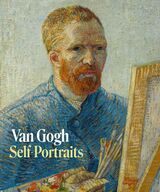 Van Gogh. Self-Portraits
Edited by Karen Serres
Paul Holberton Publishing, 2022 An exhibition catalog tracing the evolution of Van Gogh’s self-presentation in his art.
This volume accompanies an exhibition at London’s Courtauld Gallery, the first to explore the full chronological range of Vincent van Gogh’s self-portraits.
The myth of Van Gogh today is linked as much to his extraordinary life as it is to his world-famous paintings. His biography has often shaped the way his self-portraits have been (mis)understood. Spanning his entire career, this volume explores these highly personal paintings, analyzing the artist’s self-representation in context to reveal the role it plays in his oeuvre. Of particular interest is the striking way the evolution of Van Gogh’s self-representation can be seen as a microcosm of his development as a painter.
In addition to the celebrated Self-Portrait with Bandaged Ear, the exhibition showcases a group of major masterpieces brought together from international collections, including the Van Gogh Museum in Amsterdam, the Musee d’Orsay in Paris, the Art Institute of Chicago, and the National Gallery of Art in Washington, DC, among others. Beautifully illustrated, this exhibition companion includes detailed entries on each work, an appendix illustrating all of Van Gogh’s self-portraits, and three insightful essays on the theme.
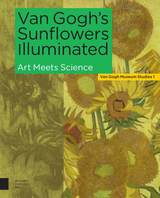 Van Gogh's Sunflowers Illuminated: Art Meets Science
Ella Hendriks
Amsterdam University Press, 2019 Vincent van Gogh's Sunflowers are seen by many as icons of Western European art. Two of these masterpieces — the first version painted in August 1888 (The National Gallery, London) and the painting made after it in January 1889 (Van Gogh Museum, Amsterdam) — have been the subject of a detailed comparison by an interdisciplinary team of experts. The pictures were examined in unprecedented depth using a broad array of techniques, including state-of-the-art, non-invasive imaging analytical methods, to look closely at and under the paint surface. Not only the making, but also the subsequent history of the works was reconstructed, including later campaigns of restoration. The study’s conclusions are set out in this book, along with the fascinating genesis of the paintings and the sunflower’s special significance to Van Gogh. More than 30 authors, all specialists in the field of conservation, conservation science and art history, have contributed to the research and publication presenting the outcomes of this unique project.
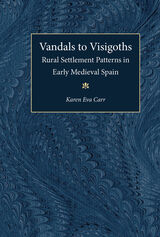 Vandals to Visigoths: Rural Settlement Patterns in Early Medieval Spain
Karen Eva Carr
University of Michigan Press, 2002 Though many argue that the fall of Rome around 400 C.E. had little effect on the rural poor of the western Mediterranean, Karen Eva Carr argues persuasively to the contrary. Vandals to Visigoths shows how the empire's collapse significantly transformed the lives of rural people. Even after the dust settled from the Germanic invasions, landscape archaeology shows the surviving rural population defending themselves in isolated hill-forts and cut off from the larger Mediterranean world.
Vandals to Visigoths uses archaeological survey data as a springboard to a theoretical discussion of rural survival strategies in the non-industrial world and the ways in which these strategies are affected by government actions. Carr draws on historical, archaeological, and ethnographic comparanda to conclude that the larger, more powerful Roman government was more advantageous for the rural poor than the weaker Vandal and Visigothic regimes. Though Carr agrees that the lives of the rural people and the free slaves were miserable, she shows through her data and theory that they became even more wretched after the decline of the empire.
Vandals to Visigoths will appeal to historians of Rome, as well as of Early Medieval Europe and Spain. Anthropologists, economists, and political scientists who study Late Antiquity and the medieval period will also be interested, as it discusses the broader implications of the role of government in the lives of early medieval Spain's subjects.
Karen Eva Carr is Associate Professor of History, Portland State University.
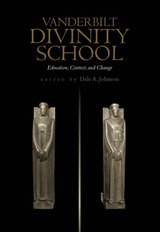 Vanderbilt Divinity School: Education, Contest and Change
Dale A. Johnson
Vanderbilt University Press, 2002 The Vanderbilt Divinity School is one of only four university-based interdenominational institutions in the United States, and the only one in the South. As such, its history provides a distinct vantage point for viewing what has occurred in theological education since the latter part of the nineteenth century. In this book, the contributors explore the school's history in terms of four main themes:
Engagement with southern culture, present from the beginnings of the university but taking on special significance in the mid-twentieth century around the issue of race;
The transition from an institution of the church (Methodist) to an independent and interdenominational school with a liberal Protestant orientation;
The development of the modern research university, evident in the establishment of a graduate program in religion in addition to its program for the profession of ministry;
From the 1950s, a growing concern with diversity and inclusivity, in keeping with national and international issues and developments both religious and cultural, which has broadened the school's sense of ecumenism and deepened its commitments to social justice.
Conflict has played an important part in shaping the history of the Vanderbilt Divinity School, from struggles over initial visions to questions of financial support and institutional control, from local debates over academic freedom to national issues of social justice. Especially noteworthy are the transformations the school has undergone since 1960: the "James Lawson affair," where the divinity school faculty resigned over the expulsion of an African American graduate student who was organizing local lunch counter sit-ins; the impact of social change on the school since the late 1960s; and the contributions of women and African Americans, including their appointment to the faculty.
 Vanguard of Nazism: The Free Corps Movement in Postwar Germany, 1918–1923
Robert G. L. Waite
Harvard University Press Vanguard of Nazism is the first full history of the German Free Corps and of its contributions to the rise of Nazism. This dramatic and horrifying story sheds new light on a dark corner of the recent past, and it has an unhappy relevance to neo-Nazist tendencies in Germany today.
The newly established Weimar Republic, defenseless against the Communists, hired groups of volunteer soldiers (the Free Corps) to fight for it. These volunteers—born of the pre–World War I youth movement, nourished on the battlefields of the War, unreconciled to defeat and determined to avenge it—fought for the Republic (which they despised) from Munich to Berlin, from Düsseldorf to the Baltic. When the Republic, in fear, tried to disband them, they went underground until they reappeared in the brown shirts of the Nazis.
The savage spirit, brutal acts, and perverted ideology of the men whom Hermann Goering called “the first soldiers of the Third Reich” stand out in glaring relief in this record. The book is based on contemporary newspaper accounts and government documents, but the story it tells would hardly be credible were it not for the memoirs of the Free Corps fighters themselves, from which Robert G. L. Waite quotes liberally. With this material, Waite is able to show that the Free Corps contributed to Hitler’s Germany powerful political shock troops, labor camps, a youth movement, a well-developed Führer concept, and the basic tenets of National Socialist ideology.
The movement, half a million strong, swept Germany at a time when Hitler was an unknown political agitator. But when Hitler came to power, leaders of the Free Corps emerged as leaders of the Third Reich. Waite lists the names of these men in a valuable appendix to the book, which shows the activities of each man in both movements.
Waite emphasizes and substantiates the thesis that National Socialism really began in the months and years immediately following World War I. Aside from its importance as history, the story of these self-styled Freebooters has all the ingredients of a fantastic adventure tale: intrigues, conspiracies, quick reversals, and sudden death follow each other in dramatic succession.
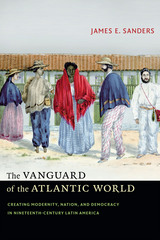 The Vanguard of the Atlantic World: Creating Modernity, Nation, and Democracy in Nineteenth-Century Latin America
James E. Sanders
Duke University Press, 2014 In the nineteenth century, Latin America was home to the majority of the world's democratic republics. Many historians have dismissed these political experiments as corrupt pantomimes of governments of Western Europe and the United States. Challenging that perspective, James E. Sanders contends that Latin America in this period was a site of genuine political innovation and popular debate reflecting Latin Americans' visions of modernity. Drawing on archival sources in Mexico, Colombia, and Uruguay, Sanders traces the circulation of political discourse and democratic practice among urban elites, rural peasants, European immigrants, slaves, and freed blacks to show how and why ideas of liberty, democracy, and universalism gained widespread purchase across the region, mobilizing political consciousness and solidarity among diverse constituencies. In doing so, Sanders reframes the locus and meaning of political and cultural modernity.
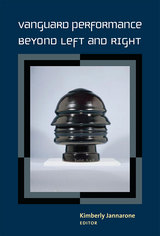 Vanguard Performance Beyond Left and Right
Kimberly Jannarone, Editor
University of Michigan Press, 2015 Vanguard Performance Beyond Left and Right challenges assumptions regarding “radical” and “experimental” performance that have long dominated thinking about the avant-garde. The book brings to light vanguard performances rarely discussed: those that support totalitarian regimes, promote conservative values, or have been effectively snapped up by right-wing regimes the performances intended to oppose. In so doing, the volume explores a central paradox: how innovative performances that challenge oppressive power structures can also be deployed in deliberate, passionate support of oppressive power. Essays by leading international scholars pose engaging questions about the historical avant-garde, vanguard acts, and the complex role of artistic innovation and live performance in global politics. Focusing on performances that work against progressive and democratic ideas (including scripted drama, staged suicide, choral dance, terrorism, rallies, and espionage), the book demonstrates how many compelling performance ideals—unification, exaltation, immersion—are, in themselves, neither moral nor immoral; they are only emotional and aesthetic urges that can be powerfully channeled into a variety of social and political outlets.
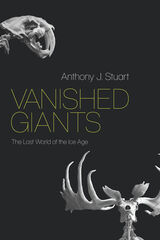 Vanished Giants: The Lost World of the Ice Age
Anthony J. Stuart
University of Chicago Press, 2021 Featuring numerous illustrations, this book explores the many lessons to be learned from Pleistocene megafauna, including the role of humans in their extinction, their disappearance at the start of the Sixth Extinction, and what they might teach us about contemporary conservation crises.
Long after the extinction of dinosaurs, when humans were still in the Stone Age, woolly rhinos, mammoths, mastodons, sabertooth cats, giant ground sloths, and many other spectacular large animals that are no longer with us roamed the Earth. These animals are regarded as “Pleistocene megafauna,” named for the geological era in which they lived—also known as the Ice Age.
In Vanished Giants: The Lost World of the Ice Age, paleontologist Anthony J. Stuart explores the lives and environments of these animals, moving between six continents and several key islands. Stuart examines the animals themselves via what we’ve learned from fossil remains, and he describes the landscapes, climates, vegetation, ecological interactions, and other aspects of the animals’ existence. Illustrated throughout, Vanished Giants also offers a picture of the world as it was tens of thousands of years ago when these giants still existed. Unlike the case of the dinosaurs, there was no asteroid strike to blame for the end of their world. Instead, it appears that the giants of the Ice Age were driven to extinction by climate change, human activities—especially hunting—or both. Drawing on the latest evidence provided by radiocarbon dating, Stuart discusses these possibilities. The extinction of Ice Age megafauna can be seen as the beginning of the so-called Sixth Extinction, which is happening right now. This has important implications for understanding the likely fate of present-day animals in the face of contemporary climate change and vastly increasing human populations.
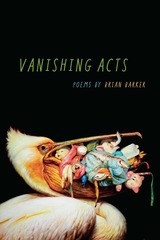 Vanishing Acts
Brian Barker
Southern Illinois University Press, 2019 In Vanishing Acts, Brian Barker cements his reputation as one of contemporary poetry’s great surrealists. These prose poems read like dreams and nightmares, fables and myths. With a dark whimsicality, Barker explores such topics as extinction, power, class, the consequences of tyranny and war, and the ongoing destruction of the environment in the name of progress.
A linked sequence of poems forms the book’s backbone, with an oracular voice from the future heralding the return—or hoped for return—of common animals. Part lyrical odes, part creation myths, part excerpts from a bizarre guide for naturalists, these poems mix fact and fiction, science and fable to create an unsettling vision of a dystopian world stricken by extinction, one where the world’s last catfish sleeps “in the shadow of a hydroelectric dam.” The imaginative language and bizarre stories of these poems are perfectly suited to capture a world that no longer makes sense: a man who wears a toupee to hide an injury inflicted by secret police, a group of villagers who make a bad bargain with a land agent.
The poems in Vanishing Acts straddle the comic and the tragic. They are by turns funny and haunting and ripe with scathing satire. They draw on the genres of speculative and science fiction as much as poetic traditions, and speak to the precarious state of man and the natural world in the twenty-first century.
 Vanishing America: Species Extinction, Racial Peril, and the Origins of Conservation
Miles A. Powell
Harvard University Press, 2016 Putting a provocative new slant on the history of U.S. conservation, Vanishing America reveals how wilderness preservation efforts became entangled with racial anxieties—specifically the fear that forces of modern civilization, unless checked, would sap white America’s vigor and stamina.
Nineteenth-century citizens of European descent widely believed that Native Americans would eventually vanish from the continent. Indian society was thought to be tied to the wilderness, and the manifest destiny of U.S. westward expansion, coupled with industry’s ever-growing hunger for natural resources, presaged the disappearance of Indian peoples. Yet, as the frontier drew to a close, some naturalists chronicling the loss of animal and plant populations began to worry that white Americans might soon share the Indians’ presumed fate.
Miles Powell explores how early conservationists such as George Perkins Marsh, William Temple Hornaday, and Aldo Leopold became convinced that the continued vitality of America’s “Nordic” and “Anglo-Saxon” races depended on preserving the wilderness. Fears over the destiny of white Americans drove some conservationists to embrace scientific racism, eugenics, and restrictive immigration laws. Although these activists laid the groundwork for the modern environmental movement and its many successes, the consequences of their racial anxieties persist.
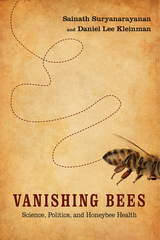 Vanishing Bees: Science, Politics, and Honeybee Health
Suryanarayanan, Sainath
Rutgers University Press, 2016 In 2005, beekeepers in the United States began observing a mysterious and disturbing phenomenon: once-healthy colonies of bees were suddenly collapsing, leaving behind empty hives full of honey and pollen. Over the following decade, widespread honeybee deaths—some of which have come to be called Colony Collapse Disorder (CCD)—have continued to bedevil beekeepers and threaten the agricultural industries that rely on bees for pollination. Scientists continue to debate the causes of CCD, yet there is no clear consensus on how to best solve the problem. Vanishing Bees takes us inside the debates over widespread honeybee deaths, introducing the various groups with a stake in solving the mystery of CCD, including beekeepers, entomologists, growers, agrichemical companies, and government regulators. Drawing from extensive interviews and first-hand observations, Sainath Suryanarayanan and Daniel Lee Kleinman examine how members of each group have acquired, disseminated, and evaluated knowledge about CCD. In addition, they explore the often-contentious interactions among different groups, detailing how they assert authority, gain trust, and build alliances. As it explores the contours of the CCD crisis, Vanishing Bees considers an equally urgent question: what happens when farmers, scientists, beekeepers, corporations, and federal agencies approach the problem from different vantage points and cannot see eye-to-eye? The answer may have profound consequences for every person who wants to keep fresh food on the table.
The Vanishing Children of Paris: Rumor and Politics before the French Revolution
Arlette Farge and Jacques Revel
Harvard University Press, 1991 In the spring of 1750 a two-day series of riots erupted in Paris when the populace discovered that police were sweeping children off the streets in an overzealous attempt to control vagrancy. Arlette Farge and Jacques Revel use this bizarre incident and its colorful cast of actors to view broader issues such as the power of rumor, mob psychology, the exercise of authority, and the maintenance of peace in Paris under the ancien régime.
 Vanishing Diaspora: The Jews in Europe Since 1945
Bernard Wasserstein
Harvard University Press, 1996 In 1939 there were ten million Jews in Europe. After Hitler there were four million. Today in 1996 there are under two million. On current projections the Jews will become virtually extinct as a significant element in European society over the course of the twenty-first century. Now, in the first comprehensive social and political history of the experience and fate of European Jews during the last fifty years, Bernard Wasserstein sheds light on the reasons for this dire demographic projection.
Drawing on a rich variety of sources, many hitherto unpublished, Wasserstein begins with the painful years of liberation after World War II when Jews tried to recover from the destruction of their people and communities, then traces the Jewish experience in Eastern and Western Europe in different national and ideological contexts. His important and original inquiry covers the impact on Jews of postwar reconstruction, Soviet occupation, the Cold War, and the collapse of communism. These, combined with the memory of Nazi genocide, the persistence of antisemitism, the development of Israel, and the Middle East conflicts, shaped the history of European Jewry in the second half of the twentieth century.
With exceptional eloquence and conviction, Vanishing Diaspora argues that survival for European Jews ultimately will depend on choices they themselves make to reverse trends. They have an alarmingly imbalanced death-to-birth ratio, and many have jettisoned religious observance in the spirit of a secular Europe, losing their cultural distinctiveness as well as their numbers. This often painful story of destruction, irreparable loss, and the shattering of ties thus serves as a wake-up call and a dramatic warning.
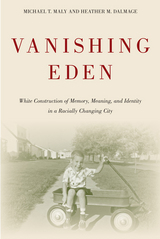 Vanishing Eden: White Construction of Memory, Meaning, and Identity in a Racially Changing City
Michael Maly
Temple University Press, 2015 For many whites, desegregation initially felt like an attack on their community. But how has the process of racial change affected whites’ understanding of community and race? In Vanishing Eden, Michael Maly and Heather Dalmage provide an intriguing analysis of the experiences and memories of whites who lived in Chicago neighborhoods experiencing racial change during the 1950s through the 1980s. They pay particular attention to examining how young people made sense of what was occurring, and how this experience impacted their lives. Using a blend of urban studies and whiteness studies, the authors examine how racial solidarity and whiteness were created and maintained—often in subtle and unreflective ways. Vanishing Eden also considers how race is central to the ways social institutions such as housing, education, and employment function. Surveying the shifting social, economic, and racial contexts, the authors explore how race and class at local and national levels shaped the organizing strategies of those whites who chose to stay as racial borders began to change.
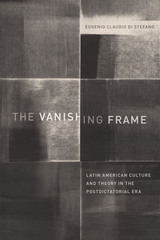 The Vanishing Frame: Latin American Culture and Theory in the Postdictatorial Era
By Eugenio Claudio Di Stefano
University of Texas Press, 2018 In the postdictatorial era, Latin American cultural production and criticism have been defined by a series of assumptions about politics and art—especially the claim that political freedom can be achieved by promoting a more direct experience between the textual subject (often a victim) and the reader by eliminating the division between art and life. The Vanishing Frame argues against this conception of freedom, demonstrating how it is based on a politics of human rights complicit with economic injustices. Presenting a provocative counternarrative, Eugenio Claudio Di Stefano examines literary, visual, and interdisciplinary artists who insist on the autonomy of the work of art in order to think beyond the politics of human rights and neoliberalism in Latin American theory and culture. Di Stefano demonstrates that while artists such as Diamela Eltit, Ariel Dorfman, and Albertina Carri develop a concept of justice premised on recognizing victims’ experiences of torture or disappearance, they also ignore the injustice of economic inequality and exploitation. By examining how artists such as Roberto Bolaño, Alejandro Zambra, and Fernando Botero not only reject an aesthetics of experience (and the politics it entails) but also insist on the work of art as a point of departure for an anticapitalist politics, this new reading of Latin American cultural production offers an alternative understanding of recent developments in Latin American aesthetics and politics that puts art at its center and the postdictatorship at its end.
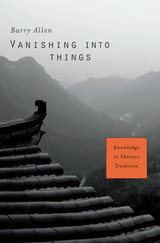 Vanishing into Things: Knowledge in Chinese Tradition
Barry Allen
Harvard University Press, 2015 Vanishing into Things explores the concept of knowledge in Chinese thought over two millennia, from Confucius to Wang Yangming (ca. 1500 CE), and compares the different philosophical imperatives that have driven Chinese and Western thought. Challenging the hyperspecialized epistemology of modern philosophy in the West, Barry Allen urges his readers toward an ethical appreciation of why knowledge is worth pursuing.
Western philosophers have long maintained that true knowledge is the best knowledge. Chinese thinkers, by contrast, have emphasized not the essence of knowing but the purpose. Ideas of truth play no part in their understanding of what the best knowledge is: knowledge is not deduced from principles or reducible to a theory. Rather, in Chinese tradition knowledge is expressed through wu wei, literally “not doing”—a response to circumstances that is at once effortless and effective. This type of knowledge perceives the evolution of circumstances from an early point, when its course can still be changed, provided one has the wisdom to grasp the opportunity.
Allen guides readers through the major Confucian and Daoist thinkers including Kongzi, Mengzi, Xunzi, Laozi, and Zhuangzi, examining their influence on medieval Neoconfucianism and Chan (Zen) Buddhism, as well as the theme of knowledge in China’s art of war literature. The sophisticated and consistent concept of knowledge elucidated here will be of relevance to contemporary Western and Eastern philosophers alike.
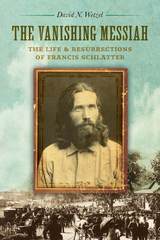 The Vanishing Messiah: The Life and Resurrections of Francis Schlatter
David N. Wetzel
University of Iowa Press, 2016 In 1895, an extraordinarily enigmatic faith healer emerged in the American West. An Alsatian immigrant and former cobbler, Francis Schlatter looked like popular depictions of Jesus, and it was said that his very touch could heal everything from migraines and arthritis to blindness and cancer. First in Albuquerque, and then in Denver, thousands flocked to him, hoping to receive his healing touch. Schlatter accepted no money for his work, behaved modestly, fasted heavily, and treated everyone, from wealthy socialites to impoverished immigrants, equally. He quickly captured national attention, and both the sick hoping to be cured and reporters hoping to expose a fraud hurried to Denver to see the celebrated healer. By November of 1895, it is estimated that Schlatter was treating thousands of people every day, and the neighborhood in which he was staying was overrun with the sick and lame, their families, reporters from across the country, and hucksters hoping to make a quick buck off the local attention. Then, one night, Schlatter simply vanished. Eighteen months later, his skeleton was reportedly found on a mountainside in Mexico’s Sierra Madre range, finally bringing Schlatter’s great healing ministry to an end.
Or did it?
Within hours of the announcement of Schlatter’s found remains, a long-haired man emerged in Cleveland to say that he was Francis Schlatter, and the next twenty-five years, several others claimed to be Denver’s great healer. In The Vanishing Messiah, a modern researcher painstakingly pieces together evidence from letters, newspaper reports, hospital records, mug shots, and published reminiscences of the healer to find out what really happened to Francis Schlatter after he left Denver in the middle of the night in November 1895. In doing so, David N. Wetzel uncovers a historical puzzle of lies, deception, and betrayal, and offers a tantalizing look into a nineteenth-century messiah and his twentieth-century reincarnations—one of whom may have been the healer himself.
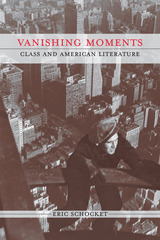 Vanishing Moments: Class and American Literature
Eric Schocket
University of Michigan Press, 2010 Vanishing Moments analyzes how various American authors have reified class through their writing, from the first influx of industrialism in the 1850s to the end of the Great Depression in the early 1940s. Eric Schocket uses this history to document America’s long engagement with the problem of class stratification and demonstrates how deeply America’s desire to deny the presence of class has marked even its most labor-conscious cultural texts.
Schocket offers careful readings of works by Herman Melville, Rebecca Harding Davis, William Dean Howells, Jack London, T. S. Eliot, Gertrude Stein, Muriel Rukeyser, and Langston Hughes, among others, and explores how these authors worked to try to heal the rift between the classes. He considers the challenges writers faced before the Civil War in developing a language of class amidst the predominant concerns about race and slavery; how early literary realists dealt with the threat of class insurrection; how writers at the turn of the century attempted to span the divide between the classes by going undercover as workers; how early modernists used working-class characters and idioms to shape their aesthetic experiments; and how leftists in the 1930s struggled to develop an adequate model to connect class and literature. Vanishing Moments’ unique combination of a broad historical scope and in-depth readings makes it an essential book for scholars and students of American literature and culture, as well as for political scientists, economists, and humanists.
Eric Schocket is Associate Professor of American Literature at Hampshire College.
“An important book containing many brilliant arguments—hard-hitting and original. Schocket demonstrates a sophisticated acquaintance with issues within the working-class studies movement.”
--Barbara Foley, Rutgers University
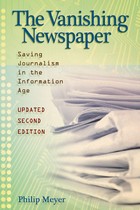 The Vanishing Newspaper [2nd Ed]: Saving Journalism in the Information Age
Philip Meyer
University of Missouri Press, 2009 Five years ago in The Vanishing Newspaper, Philip Meyer offered the newspaper industry a business model for preserving and stabilizing the social responsibility functions of the press in a way that could outlast technology-driven changes in media forms. Now he has updated this groundbreaking volume, taking current declines in circulation and the number of dailies into consideration and offering a greater variety of ways to save journalism. Meyer’s “influence model” is based on the premise that a newspaper’s main product is not news or information, but influence: societal influence, which is not for sale, and commercial influence, which is. The model is supported by an abundance of empirical evidence, including statistical assessments of the quality and influence of the journalist’s product, as well as its effects on business success. Meyer now applies this empirical evidence to recent developments, such as the impact of Craigslist and current trends in information technologies. New charts show how a surge in newsroom employment propped up readership in the 1980s, and data on the effects of newsroom desegregation are now included. Meyer’s most controversial suggestion, making certification available for reporters and editors, has been gaining ground. This new edition discusses several examples of certificate programs that are emerging in organizations both old and new. Understanding the relationship between quality and profit probably will not save traditional newspapers, but Meyer argues that such knowledge can guide new media enterprises. He believes that we have the tools to sustain high-quality journalism and preserve its unique social functions, though in a transformed way.
vanishing point.
Kimberly Reyes
Omnidawn, 2023 A collection by award-winning poet Kimberly Reyes that explores erased histories.
Through her latest collection, Kimberly Reyes navigates the physical, hereditary, and liminal worlds between land, time, and memory. The poems in vanishing point. take us to San Francisco, Ireland, and the Atlantic Ocean, reclaiming and examining contested space as the poet seeks to revive left-behind histories, reconsider what we see, and reveal what we cannot see.
Vanishing Points: Articulations of Death, Fragmentation, and the Unexperienced Experience of Created Objects
Natasha Chuk
Intellect Books, 2015 Deftly deploying Derrida’s notion of the “unexperienced experience” and building on Paul Virilio’s ideas about the aesthetics of disappearance, Vanishing Points explores the aesthetic character of presence and absence as articulated in contemporary art, photography, film, and emerging media. Addressing works ranging from Robert Rauschenberg to Six Feet Under, Natasha Chuk emphasizes the notion that art is an accident, an event, which registers numerous overlapping, contradictory orientations, or vanishing points, between its own components and the viewers’ perspective—generating the power to create unexperienced experiences. It will be a must read for anyone interested in contemporary art and its intersection with philosophy.
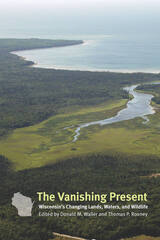 The Vanishing Present: Wisconsin's Changing Lands, Waters, and Wildlife
Edited by Donald M. Waller and Thomas P. Rooney
University of Chicago Press, 2008 Straddling temperate forests and grassland biomes and stretching along the coastline of two Great Lakes, Wisconsin contains tallgrass prairie and oak savanna, broadleaf and coniferous forests, wetlands, natural lakes, and rivers. But, like the rest of the world, the Badger State has been transformed by urbanization and sprawl, population growth, and land-use change. For decades, industry and environment have attempted to coexist in Wisconsin—and the dynamic tensions between economic progress and environmental protection makes the state a fascinating microcosm for studying global environmental change.
The Vanishing Present brings together a distinguished set of contributors—including scientists, naturalists, and policy experts—to examine how human pressures on Wisconsin’s changing lands, waters, and wildlife have redefined the state’s ecology. Though they focus on just one state, the authors draw conclusions about changes in temperate habitats that can be applied elsewhere, and offer useful insights into future of the ecology, conservation, and sustainability of Wisconsin and beyond.
A fitting tribute to the home state of Aldo Leopold and John Muir, The Vanishing Present is an accessible and timely case study of a significant ecosystem and its response to environmental change.
 Vanishing Sands: Losing Beaches to Mining
Orrin H. Pilkey, Norma J. Longo, William J. Neal, Nelson G. Rangel-Buitrago, Keith C. Pilkey, and Hannah L. Hayes
Duke University Press, 2022 In a time of accelerating sea level rise and increasingly intensifying storms, the world’s sandy beaches and dunes have never been more crucial to protecting coastal environments. Yet, in order to meet the demands of large-scale construction projects, sand mining is stripping beaches and dunes, destroying environments, and exploiting labor in the process. The authors of Vanishing Sands track the devastating impact of legal and illegal sand mining over the past twenty years, ranging from Africa, Asia, and the Caribbean to South America and the eastern United States. They show how sand mining has reached crisis levels: beach, dune, and river ecosystems are in danger of being lost forever, while organized crime groups use deadly force to protect their illegal mining operations. Calling for immediate and widespread resistance to sand mining, the authors demonstrate that its cessation is paramount for saving not only beaches, dunes, and associated environments but also lives and tourism economies everywhere.
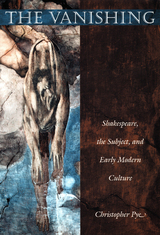 The Vanishing: Shakespeare, the Subject, and Early Modern Culture
Christopher Pye
Duke University Press, 2000 In The Vanishing Christopher Pye combines psychoanalytic and cultural theory to advance an innovative interpretation of Renaissance history and subjectivity. Locating the emergence of the modern subject in the era’s transition from feudalism to a modern societal state, Pye supports his argument with interpretations of diverse cultural and literary phenomena, including Shakespeare’s Hamlet and King Lear, witchcraft and demonism, anatomy theaters, and the paintings of Michelangelo. Pye explores the emergence of the early modern subject in terms of a range of subjectivizing mechanisms tied to the birth of a modern conception of history, one that is structured around a spatial and temporal horizon—a vanishing point. He also discusses the distinctly economic character of early modern subjectivity and how this, too, is implicated in our own modern modes of historical understanding. After explaining how the aims of New Historicist and Foucauldian approaches to the Renaissance are inseparably linked to such a historical conception, Pye demonstrates how the early modern subject can be understood in terms of a Lacanian and Zizekian account of the emerging social sphere. By focusing on the Renaissance as a period of remarkable artistic and cultural production, he is able to illustrate his points with discussions of a number of uniquely fascinating topics—for instance, how demonism was intimately related to a significant shift in law and symbolic order and how there existed at the time a “demonic” preoccupation with certain erotic dimensions of the emergent social subject. Highly sophisticated and elegantly crafted, The Vanishing will be of interest to students of Shakespeare and early modern culture, Renaissance visual art, and cultural and psychoanalytic theory.
 The Vanishing Subject: Early Psychology and Literary Modernism
Judith Ryan
University of Chicago Press, 1991 Is thinking personal? Or should we not rather say, "it thinks," just as we say, "it rains"? In the late nineteenth century a number of psychologies emerged that began to divorce consciousness from the notion of a personal self. They asked whether subject and object are truly distinct, whether consciousness is unified or composed of disparate elements, what grounds exist for regarding today's "self" as continuous with yesterday's. If the American pragmatist William James declared himself, on balance, in favor of a "real and verifiable personal identity which we feel," his Austrian counterpart, the empiricist Ernst Mach, propounded the view that "the self is unsalvageable."
The Vanishing Subject is the first comprehensive study of the impact of these pre-Freudian debates on modernist literature. In lucid and engaging prose, Ryan traces a complex set of filiations between writers and thinkers over a sixty-year period and restores a lost element in the genesis and development of modernism. From writers who see the "self" as nothing more or less than a bundle of sensory impressions, Ryan moves to others who hesitate between empiricist and Freudian views of subjectivity and consciousness, and to those who wish to salvage the self from its apparent disintegration. Finally, she looks at a group of writers who abandon not only the dualisms of subject and object, but dualistic thinking altogether.
Literary impressionism, stream-of-consciousness and point-of-view narration, and the question of epiphany in literature acquire a new aspect when seen in the context of the "psychologies without the self." Rilke's development of a position akin to phenomenology, Henry and Alice James's relation to their psychologist brother, Kafka's place in the modernist movements, Joyce's rewriting of Pater, Proust's engagement with contemporary thought, Woolf's presentation of consciousness, and Musil's projection of a utopian counter-reality are problems familiar to readers and critics: The Vanishing Subject radically revises the way we see them.
 Vanishing Women: Magic, Film, and Feminism
Karen Beckman
Duke University Press, 2003 With the help of mirrors, trap doors, elevators, photographs, and film, women vanish and return in increasingly spectacular ways throughout the nineteenth and twentieth centuries. Karen Beckman tracks the proliferation of this elusive figure, the vanishing woman, from her genesis in Victorian stage magic through her development in conjunction with photography and film. Beckman reveals how these new visual technologies projected their anxieties about insubstantiality and reproducibility onto the female body, producing an image of "woman" as utterly unstable and constantly prone to disappearance. Drawing on cinema studies and psychoanalysis as well as the histories of magic, spiritualism, and photography, Beckman looks at particular instances of female vanishing at specific historical moments—in Victorian magic’s obsessive manipulation of female and colonized bodies, spiritualist photography’s search to capture traces of ghosts, the comings and goings of bodies in early cinema, and Bette Davis’s multiple roles as a fading female star. As Beckman places the vanishing woman in the context of feminism’s discussion of spectacle and subjectivity, she explores not only the problems, but also the political utility of this obstinate figure who hovers endlessly between visible and invisible worlds. Through her readings, Beckman argues that the visibly vanishing woman repeatedly signals the lurking presence of less immediately perceptible psychic and physical erasures, and she contends that this enigmatic figure, so ubiquitous in late-nineteenth- and twentieth-century culture, provides a new space through which to consider the relationships between visibility, gender, and agency.
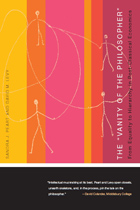 The "Vanity of the Philosopher": From Equality to Hierarchy in Post-Classical Economics
Sandra J. Peart and David M. Levy
University of Michigan Press, 2005 The "Vanity of the Philosopher" continues the themes introduced in Levy's acclaimed book How the Dismal Science Got Its Name.
Here, Peart and Levy tackle the issues of racism, eugenics, hierarchy, and egalitarianism in classical economics and take a broad view of classical economics' doctrine of human equality. Responding to perennial accusations from the left and the right that the market economy has created either inequality or too much equality, the authors trace the role of the eugenics movement in pulling economics away from the classical economist's respect for the individual toward a more racist view at the turn of the century.
The "Vanity of the Philosopher" reveals the consequences of hierarchy in social science. It shows how the "vanity of the philosopher" has led to recommendations that range from the more benign but still objectionable "looking after" paternalism, to overriding preferences, and, in the extreme, to eliminating purportedly bad preferences. The authors suggest that an approach that abstracts from difference and presumes equal competence is morally compelling.
"People in the know on intellectual history and economics await the next book from Peart and Levy with much the same enthusiasm that greets a new Harry Potter book in the wider world. This book delivers the anticipated delights big time!"
-William Easterly, Professor of Economics and Africana Studies, NYU, and non-resident Senior Fellow, Center for Global Development
"In their customary idiosyncratic manner, Sandra Peart and David Levy reexamine the way in which the views of classical economists on equality and hierarchy were shifted by contact with scholars in other disciplines, and the impact this had on attitudes towards race, immigration, and eugenics. This is an imaginative and solid work of scholarship, with an important historical message and useful lessons for scholars today."
-Stanley Engerman, John Munro Professor of Economics and Professor of History, University of Rochester
Sandra J. Peart, Professor of Economics at Baldwin-Wallace College, has published articles on utilitarianism, the methodology of J. S. Mill, and the transition to neoclassicism. This is her fourth book. David M. Levy is Professor of Economics at George Mason University and Director of the Center for Study of Public Choice. This is his third book.
 Vanity Unfair
Zuzana Cigánová
Seagull Books, 2022 Set in Slovakia, a revealing narrative about contemporary society.
An accidental pregnancy, a good-looking man who cares about no one but himself, marriage because the man “had a bit of a Christian upbringing,” divorce—that is the trajectory of Pipina’s life, leading to single motherhood and a thousand cruelties of everyday life because she is an ugly woman in a world where ugliness is worse than a death sentence. At every turn, she is reminded of her inferiority. She can’t wait for the end of each day when she can sit in the stairwell outside of her dilapidated apartment and retreat into her thoughts. Her drab life full of indignities dissolves only in her beautiful, cinematic dreams. In them, she experiences whatever she can’t do or have in real life. She creates a rich inner world, and her razor-sharp observations, interlaced with a good dose of humor, produce a revealing narrative about contemporary society. In the first English translation of her work, the brilliant Slovak author Zuzana Cigánová pulls back the veil on people’s most private thoughts—thoughts that could very much be our own.
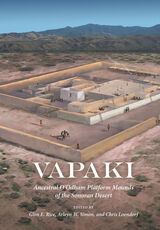 Vapaki: Ancestral O’Odham Platform Mounds of the Sonoran Desert
Edited by Glen E. Rice, Arleyn W. Simon, and Chris Loendorf
University of Utah Press, 2022 This volume presents a far-ranging conversation on the topic of Hohokam platform mounds in the history of the southern Arizona desert, exploring why they were built, how they were used, and what they meant in the lives of the farming communities who built them. Vapaki brings together diverse theoretical approaches, a mix of big-picture and tightly focused perspectives, detailed coverage for regional specialists of variation in the mounds, a broad synthesis useful for those working from other regional and topical foundations, and a rich corpus of perspectives and ideas for further research. Contributors grapple with questions about platform mounds, including the social, political, ideological, symbolic, and adaptive factors that contributed to their development, spread, and eventual cessation.
The differing perspectives presented here about what motivated Ancestral O’Odham populations of the Hohokam Period to build these monuments, whether as displays of status, identity, political ability, membership in regional networks, or architectural models of the cosmological order, offer insights to researchers studying monumental architecture in other contexts. O’Odham knowledge of the history and uses of mounds is combined with archaeological data to understand the place of platform mounds in the lives of the Ancestors and their continued presence among modern descendants.
A Vaquero of the Brush Country: The Life and Times of John D. Young
By John D. Young and J. Frank Dobie
University of Texas Press, 1998 This true story of the Texas brush range and the first cowboys, as thrilling as any tale of fiction, has become a classic in Western literature. It is the story of the land where cattle by tens of thousands were killed on the prairie and where the "Skinning War" was fought. It is the story of the Chisholm Trail up to Abilene and the Platte and of establishing a ranch on the free grass of the Texas Panhandle, of roping elk in Colorado, of trailing Billy the Kid in New Mexico, of the grim lands of the Pecos. And it is the story of John Young, old-time vaquero who was trail driver, hog chaser, sheriff, ranger, hunter of Mexican bandits, horse thief killer, prairie fire fighter, ranch manager, and other things—a man who was also something of a dreamer, a man of imagination.
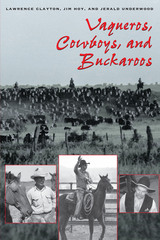 Vaqueros, Cowboys, and Buckaroos
By Lawrence Clayton, Jim Hoy, and Jerald Underwood
University of Texas Press, 2001 Herding cattle from horseback has been a tradition in northern Mexico and the American West since the Spanish colonial era. The first mounted herders were the Mexican vaqueros, expert horsemen who developed the skills to work cattle in the brush country and deserts of the Southwestern borderlands. From them, Texas cowboys learned the trade, evolving their own unique culture that spread across the Southwest and Great Plains. The buckaroos of the Great Basin west of the Rockies trace their origin to the vaqueros, with influence along the way from the cowboys, though they, too, have ways and customs distinctly their own. In this book, three long-time students of the American West describe the history, working practices, and folk culture of vaqueros, cowboys, and buckaroos. They draw on historical records, contemporary interviews, and numerous photographs to show what makes each group of mounted herders distinctive in terms of working methods, gear, dress, customs, and speech. They also highlight the many common traits of all three groups. This comparative look at vaqueros, cowboys, and buckaroos brings the mythical image of the American cowboy into focus and detail and honors the regional and national variations. It will be an essential resource for anyone who would know or portray the cowboy—readers, writers, songwriters, and actors among them.
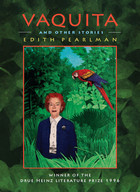 Vaquita and Other Stories
Edith Pearlman
University of Pittsburgh Press, 1996 When asked to describe her short stories, Edith Pearlman replied that they are stories about people in peculiar circumstances aching to Do The Right Thing. She elaborated with the same wit and intimacy that make her stories a delight to read:
“Before I was a writer I was a reader; and reading remains a necessary activity, occupying several joyous hours of every day. I like novels, essays, and biographies; but most of all I like the short story: narrative at its most confiding.
“My own work, and particularly the stories in Vaquita, aims at a similar intimacy between writer and reader. My imagined reader wants to know who loves whom, who drinks what, and, mostly, who answers to what summons. Thank Heavens for Spike Lee! Before his movies writers and critics had to natter about moral stances; now I can say with a more tripping tongue that my characters are people in peculiar circumstances, aching to Do The Right Thing if only they can figure out what The Right Thing is. If not, they’ll at least Do Their Own Right Thing Right.
“And I’m drawn to heat: sweltering Central American cities; a steamy soup kitchen; Jerusalem in midsummer; the rekindled passion of an old historian; the steady fire of terminal pain. I like solitaires, oddities, charlatans, and children. My characters are secretive; in almost every story somebody harbors a hidden love, dread, regret, or the memory of an insult awaiting revenge.
“When I stop writing stories I plan to write letters, short and then shorter. My mother could put three sentences onto a postcard and make the recipient think he’d read a novel. I’m working towards a similar compression.”
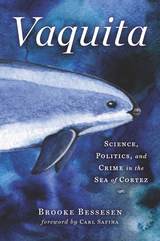 Vaquita: Science, Politics, and Crime in the Sea of Cortez
Brooke Bessesen
Island Press, 2018 "Intrepid conservation detective story." —Nature
"A lucid, informed, and gripping account...a must-read." —Science
"Passionate...a heartfelt and alarming tale." —Publishers Weekly
"Gripping...a well-told and moving tale of environmentalism and conservation." —Kirkus
"Compelling." —Library Journal
In 2006, vaquita, a diminutive porpoise making its home in the Upper Gulf of California, inherited the dubious title of world’s most endangered marine mammal. Nicknamed “panda of the sea” for their small size and beguiling facial markings, vaquitas have been in decline for decades, dying by the hundreds in gillnets intended for commercially valuable fish, as well as for an endangered fish called totoaba. When international crime cartels discovered a lucrative trade in the swim bladders of totoaba, illegal gillnetting went rampant, and now the lives of the few remaining vaquitas hang in the balance.
Author Brooke Bessesen takes us on a journey to Mexico’s Upper Gulf region to uncover the story. She interviewed townspeople, fishermen, scientists, and activists, teasing apart a complex story filled with villains and heroes, a story whose outcome is unclear. When diplomatic and political efforts to save the little porpoise failed, Bessesen followed a team of veterinary experts in a binational effort to capture the last remaining vaquitas and breed them in captivity—the best hope for their survival. In this fast-paced, soul-searing tale, she learned that there are no easy answers when extinction is profitable.
Whether the rescue attempt succeeds or fails, the world must ask itself hard questions. When vaquita and the totoaba are gone, the black market will turn to the next vulnerable species. What will we do then?
Vardis Fisher: A Mormon Novelist
Michael Austin
University of Illinois Press, 2021 Raised by devout Mormon parents, Vardis Fisher drifted from the faith after college. Yet throughout his long career, his writing consistently reflected Mormon thought. Beginning in the early 1930s, the public turned to Fisher's novels like Children of God to understand the increasingly visible Church of Jesus Christ of Latter-day Saints. His striking works vaulted him into the same literary tier as William Faulkner while his commercial success opened the New York publishing world to many of the founding figures in the Mormon literary canon. Michael Austin looks at Fisher as the first prominent American author to write sympathetically about the Church and examines his work against the backdrop of Mormon intellectual history. Engrossing and enlightening, Vardis Fisher illuminates the acclaimed author's impact on Mormon culture, American letters, and the literary tradition of the American West.
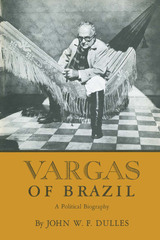 Vargas of Brazil: A Political Biography
By John W. F. Dulles
University of Texas Press, 1967 The dominant public figure in Brazil from 1930 until 1954 was a highly contradictory and controversial personality. Getúlio Vargas, from the pampas of the southern frontier state of Rio Grande do Sul, became the dictator who ruled without ever forgetting the lower classes. Vargas was a consummate artist at politics. He climbed the political ladder through seats in the state and national legislatures to the post of federal Finance Minister and to the governorship of Rio Grande do Sul. His career then took him to the National Palace as Provisional President and as Constitutional President, and later as the dictator of his "New State." After his deposition in 1945 and a period of semiretirement, his continuing widespread popularity resulted in his successful come-back campaign in 1950 for the Presidency on the Labor Party ticket. Vargas' contributions to Brazilian political and economic life were many and important. Taking advantage of the power which his political magic provided him, he brought Brazil from a loose confederacy of semifeudal states to a strongly centralized nation. He was a great eclectic, welding into his social, political, and economic policies what he found good in various programs. He was also a great opportunist in the sense that he adroitly took advantage of conditions and circumstances to effect his ends. He was intimately related to the revolutionary changes in Brazilian life after 1930. Vargas, "Father of the Brazilians," attributed achievements such as these to power in his own hands. His foes, however, still feared the political wizard, and they cheered the military when it deposed him. After his return, "on the arms of the people," Vargas saw that the armed forces were determined to repeat history, and in 1954 he chose another path—suicide. All of these exciting events are related in John W. F. Dulles's Vargas of Brazil: A Political Biography. Despite its emphasis on Vargas the politician and statesman, the reader comes to know Vargas the man. For this portrait of Vargas and of Brazil the author has drawn much material from State Department papers in the National Archives and from other public sources, and from interviews with numerous persons who were participants in the events he describes or observers of them. The result is an interesting, revealing, valid account of an important people. Many illustrations supplement the text.
 Variability, Scalability and Stability of Microgrids
S.M. Muyeen
The Institution of Engineering and Technology, 2019 A microgrid is a small network of electricity users with a local source of supply that is usually attached to a larger grid but can function independently. The interconnection of small scale generating units, such as PV and wind turbines, and energy storage systems, such as batteries, to a low voltage distribution grid involves three major challenges: variability, scalability, and stability. It must keep delivering reliable and stable power also when changing, or repairing, any component, or under varying wind and solar conditions. It also must be able to accept additional units, i.e. be scalable. This reference discusses these three challenges facing engineers and researchers in the field of power systems, covering topics such as demand side energy management, transactive energy, optimizing and sizing of microgrid components. Case studies and results provide illustrative examples in each chapter.
Variable Frequency AC Motor Drive System
David Finney
The Institution of Engineering and Technology, 1988 This book is intended to explain the technical principles involved in the many AC variable speed drive systems available today. It deals with all the DC link inverter and direct AC to AC converter systems that are in commercial use. The principles of AC motors are considered specifically from the variable frequency point of view, and this chapter concentrates on the effects of harmonics. The different types of power semiconductor switches are considered separately from the drive systems in which they are used.
 Variable Properties in Language: Their Nature and Acquisition
David W. Lightfoot and Jonathan Havenhill, Editors
Georgetown University Press, 2019 This edited volume, based on papers presented at the 2017 Georgetown University Round Table on Language and Linguistics (GURT), approaches the study of language variation from a variety of angles. Language variation research asks broad questions such as, "Why are languages' grammatical structures different from one another?" as well as more specific word-level questions such as, "Why are words that are pronounced differently still recognized to be the same words?" Too often, research on variation has been siloed based on the particular question—sociolinguists do not talk to historical linguists, who do not talk to phoneticians, and so on. This edited volume seeks to bring discussions from different subfields of linguistics together to explore language variation in a broader sense and acknowledge the complexity and interwoven nature of variation itself.
Variable Structure Systems: From principles to implementation
Asif Sabanovic
The Institution of Engineering and Technology, 2004 Variable structure systems, or sliding mode control systems, are non-linear automatic control systems whose structures are deliberately allowed to change, so that robust performance is obtained. It allows the design of high performance control systems that can be reliably and easily implemented at low cost. Although the basic theory is mature, the theory and the associated control system design methodologies are less well known to many control engineers. This new text seeks to redress the gap, and is split into three parts: the basics of sliding mode control, new trends in sliding mode control and applications of sliding mode control.
 Variables Related to Human Breast Cancer
V. Elving Anderson
University of Minnesota Press, 1958
Variables Related to Human Breast Cancer was first published in 1958.The question of what role, if any, heredity plays in the etiology of human cancer is of obvious importance in the continuing search for an answer to the riddle of cancer. This book describes a study which was conducted at the Dight Institute for Human Genetics of the University of Minnesota, seeking evidence on two aspects of the heredity question. The objectives were, first, to determine whether there is an increased frequency of cancer among relatives of breast cancer patients (over what would be expected by coincidence) and second, to find out whether any family tendency to cancer is general or site-specific.The families of 621 breast cancer patients treated at the Tumor Clinic of the University of Minnesota Hospitals were investigated, with special attention to the choice of original patients and to the completeness of information. For comparison the authors studied the families of husbands of the patients and also analyzed statistics on cancer cases and deaths in the general population.The methods used in the project are described in detail, the data are presented, and the results interpreted. The findings are of value not only in their scientific application but also for use in counseling relatives of breast cancer patients, since these relatives often have greater fear of developing cancer than the facts warrant.
 The Variation and Adaptive Expression of Antibodies
George P. Smith
Harvard University Press, 1973 During the past ten years, several theories have been proposed on the origin of the diversity of antibodies. George P. Smith presents a critical study of these theories in this detailed treatment of immunological problems from the point of view of molecular genetics.
Mr. Smith uses a new and simplifying approach to this long-standing controversy. By a comprehensive computerized analysis of antibody amino acid sequences (particularly the myeloma proteins), the author traces their evolution and matches his results against the expectations of the various theories of diversity. He discusses at length the other types of evidence as well.
Mr. Smith also deals with the clonal specialization of cells to produce a single antibody, and the relationship of this specialization to the somatic joining of antibody half-genes, which is one of the immune system's most important peculiarities.
Introductory material is provided to make this work understandable to molecular geneticists not versed in immunology and to immunologists not versed in molecular genetics.
This is a timely book offering a succinct and coherent summary of the various lines of evidence in a confused and controversial field.
 Variation, Senescence, and Neoplasia in Cultured Somatic Cells
John W. Littlefield
Harvard University Press, 1976 Aging and cancer may be manifestations of genetic, or epigenetic, changes in somatic cells. Through research, laboratory analysis of these related processes has become possible. Cells can be removed from the body, kept warm in laboratory glassware, nourished by artificial solutions, and studied for years, or even decades. Two types of cultures have emerged: Primary cultures, grown from cells obtained directly from living animals, may grow well for generations, but ultimately cease to divide. Established cultures, on the other hand, may grow and divide indefinitely. It is a striking fact that most, if not all, established cultures consist of cells that are heteroploid, having an abnormal chromosome complement that may include structural rearrangements as well as abnormalities of chromosome number.
Most established cultures are also neoplastic on behavior and morphology—in this, they resemble cancers—and established cultures are, in fact, often grown from cancer cells. Interest in the role of chromosomes in neoplasia has recently been overshadowed by an emphasis on tumor viruses. This book should reawaken the former interest. It will also arouse new interest in the role of epigenetic mechanisms of animal cells, in contrast to the classic genetic processes. As Dr. John Littlefield writes: “The relationship between the overcoming of senescence, the appearance of heteroploidy, and the acquisition of neoplastic qualities is not yet clear, but it is of such great theoretical and practical importance as to demand attention and new ideas.”
Variations in the Expression of Inka Power
Richard L. Burger
Harvard University Press, 2007 Until recently, little archaeological investigation has been dedicated to the Inka, the last great culture to flourish in Andean South America before the sixteenth-century arrival of the Spaniards. While the Inka have been traditionally viewed through the textual sources of early colonial histories, this volume draws on recent archaeological research to challenge theories on the chronology and development of the Inka Empire and how this culture spread across such a vast area. The volume demonstrates the great regional diversity of the Inka realm, with strategies of expansion that were shaped to meet a variety of local situations beyond the capital in Cusco. Using a range of theoretical and methodological approaches, scholars from the sciences, social sciences, and humanities provide a new understanding of Inka culture and history.
 Variations on Dawn and Dusk
Dan Beachy-Quick
Omnidawn, 2019 Acting as poetic records of light, the poems in Variations on Dawn and Dusk follow the sun as it warms, cools, colors, and shifts the space of Robert Irwin’s untitled (dawn to dusk) in the desert of Marfa, TX. Built on the footprint of the town’s old hospital, Irwin’s permanent installation is a remarkable structure with walls, windows, and screens that both capture and are taken over by the sun’s changing light. Through this deeply engaged ekphrasis, Dan Beachy-Quick uses language to participate in the overpowering elegance of Irwin’s structure. The poet’s fervent observations lead us in cycles of meditation, moving with the light that slides through the surfaces of the installation. Here, the very foundation of our vision—light—forms the vocabulary from which these poems are built.
Building from Irwin’s use of rhythm and structure, the poems in this collection are constructed with an architectural framework. Rhythmic procedures inversely link the first and last words of the first and last lines of each poem and tie the number of lines to the number of syllables in the first line. These structures form a pattern, a thoughtful consistency through which we are invited to move and meditate with each variation of light.
Variations on the Body
Michel Serres
University of Minnesota Press, 2015 World-renowned philosopher, Michel Serres writes a text in praise of the body and movement, in praise of teachers of physical education, coaches, mountain guides, athletes, dancers, mimes, clowns, artisans, and artists. This work describes the variations, the admirable metamorphoses that the body can accomplish. While animals lack such a variety of gestures, postures, and movements, the fluidity of the human body mimics the leisure of living beings and things; what’s more, it creates signs. Already here, within its movements and metamorphoses, the mind is born. The five senses are not the only source of knowledge: it emerges, in large part, from the imitations the plasticity of the body allows. In it, with it, by it knowledge begins.
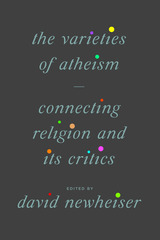 The Varieties of Atheism: Connecting Religion and Its Critics
Edited by David Newheiser
University of Chicago Press, 2022 Thoughtful essays to revive dialogue about atheism beyond belief.
The Varieties of Atheism reveals the diverse nonreligious experiences obscured by the combative intellectualism of Sam Harris, Richard Dawkins, and Christopher Hitchens. In fact, contributors contend that narrowly defining atheism as the belief that there is no god misunderstands religious and nonreligious persons altogether. The essays show that, just as religion exceeds doctrine, atheism also encompasses every dimension of human life: from imagination and feeling to community and ethics. Contributors offer new, expansive perspectives on atheism’s diverse history and possible futures. By recovering lines of affinity and tension between particular atheists and particular religious traditions, this book paves the way for fruitful conversation between religious and non-religious people in our secular age.
 Varieties of Civic Innovation: Deliberative, Collaborative, Network, and Narrative Approaches
Jennifer Girouard
Vanderbilt University Press, 2014 In this collection of original essays, empirical analysts and theorists across disciplines turn a critical eye to a variety of recent institutional forms and styles of innovation. They examine lived reality and theoretical underpinning, promise and accomplishment, but also the pitfalls and capacity-building challenges that face virtually all attempts to bring citizen voice, knowledge, and skill to the center of public problem solving. Their analyses are both hopeful and hard-headed and are guided by commitments to help understand appropriate fit and realistic sustainability. Cases include face-to-face deliberation, online networking and citizen journalism, policy forums, and community and stakeholder planning sessions across local, state and federal contexts. Policy issues run a broad gamut from community and regional economic development and environmental sustainability to minority rights and gay marriage.
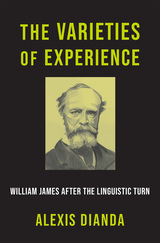 The Varieties of Experience: William James after the Linguistic Turn
Alexis Dianda
Harvard University Press, 2023 A reclamation of experience as the foremost concept in the work of William James, and a powerful argument for the continuing importance of his philosophy.
How does one deploy experience without succumbing to a foundationalist epistemology or an account of the subject rooted in immediately given objects of consciousness? In the wake of the so-called linguistic turn of the twentieth century, this is a question anyone thinking philosophically about experience must ask.
Alexis Dianda answers through a reading of the pragmatic tradition, culminating in a defense of the role of experience in William James’s thought. Dianda argues that by reconstructing James’s philosophical project, we can locate a model of experience that not only avoids what Wilfrid Sellars called “the myth of the given” but also enriches pragmatism broadly. First, Dianda identifies the motivations for and limitations of linguistic nominalism, insisting that critics of experience focus too narrowly on justification and epistemic practices. Then, by emphasizing how James’s concept of experience stresses the lived, affective, and nondiscursive, the argument holds that a more robust notion of experience is necessary to reflect not just how we know but how we act.
The Varieties of Experience provides a novel reconstruction of the relationship between psychology, moral thought, epistemology, and religion in James’s work, demonstrating its usefulness in tackling issues such as the relevance of perception to knowledge and the possibility of moral change. Against the tide of neopragmatic philosophers such as Richard Rorty and Robert Brandom, who argue that a return to experience must entail appeals to foundationalism or representationalism, Dianda’s intervention rethinks not only the value and role of experience but also the aims and resources of pragmatic philosophy today.
Varieties of Innovation Systems: The Governance of Knowledge Transfer in Europe
Michael Ortiz
Campus Verlag, 2013 This book investigates the governance structures and mechanisms of knowledge and technology transfer in the context of innovation and production systems in six regions of Europe. For that purpose, the author develops a new and innovative heuristic governance model of knowledge transfer systems. Against the assumption of far-reaching institutional coherence and homogeneity of national systems in existing scholarship, Michael Ortiz demonstrates that national innovation and production systems are regionally variegated. With analyses of strengths and weaknesses, barriers, shortcomings, and dilemmas of regional innovation and knowledge transfer systems, the book ultimately identifies best practice models and policy recommendations for the investigated regions.
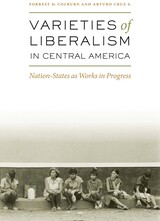 Varieties of Liberalism in Central America: Nation-States as Works in Progress
By Forrest D. Colburn and Arturo Cruz S.
University of Texas Press, 2007 Why do some countries progress while others stagnate? Why does adversity strengthen some countries and weaken others? Indeed, in this era of unprecedented movement of people, goods, and ideas, just what constitutes a nation-state? Forrest Colburn and Arturo Cruz suggest how fundamental these questions are through an exploration of the evolution of Guatemala, El Salvador, Honduras, Nicaragua, and Costa Rica over the last quarter of a century, a period of intriguing, often confounding, paradoxes in Central America's development. Offering an elegant defense of empiricism, Colburn and Cruz explore the roles of geography and political choice in constructing nations and states. Countries are shown to be unique: there are a daunting number of variables. There is causality, but not the kind that can be revealed in the laboratory or on the blackboard. Liberalism—today defined as democracy and unfettered markets—may be in vogue, but it has no inherent determinants. Democracy and market economies, when welded to the messy realities of individual countries, are compatible with many different outcomes. The world is more pluralistic in both causes and effects than either academic theories or political rhetoric suggest.
Varieties of Marxist Humanism: Philosophical Revision in Postwar Eastern Europe
James H. Satterwhite
University of Pittsburgh Press, 1992 Satterwhite analyzes the work of revisionist thinkers in four East European countries whose critique of the orthodox “official” Marxism laid the philosophical groundwork for the 1989-1990 upheavals in Eastern Europe and a reassessment of Marxist thought generally throughout the world.
Varieties of Moral Personality: Ethics and Psychological Realism
Owen Flanagan
Harvard University Press, 1993 Owen Flanagan argues in this book for a more psychologically realistic ethical reflection and spells out the ways in which psychology can enrich moral philosophy. Beginning with a discussion of such “moral saints” as Gandhi, Mother Teresa, and Oskar Schindler, Flanagan charts a middle course between an ethics that is too realistic and socially parochial and one that is too idealistic, giving no weight to our natures.
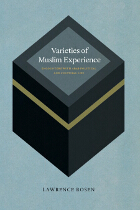 Varieties of Muslim Experience: Encounters with Arab Political and Cultural Life
Lawrence Rosen
University of Chicago Press, 2008 In Varieties of Muslim Experience, anthropologist Lawrence Rosen explores aspects of Arab Muslim life that are, at first glance, perplexing to Westerners. He ranges over such diverse topics as why Arabs eschew portraiture, why a Muslim scientist might be attracted to fundamentalism, and why the Prophet must be protected from blasphemous cartoons. What connects these seemingly disparate features of Arab social, political, and cultural life? Rosen argues that the common thread is the importance Arabs place on the negotiation of interpersonal relationships—a link that helps to explain actions as seemingly unfathomable as suicide bombing and as elusive as Quranic interpretation.
Written with eloquence and a deep knowledge of the entire spectrum of Muslim experience, Rosen’s book will interest not only anthropologists and Islamicists but anyone invested in better understanding the Arab world.
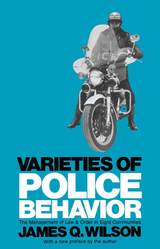 Varieties of Police Behavior: The Management of Law and Order in Eight Communities, With a New Preface by the Author
James Q. Wilson
Harvard University Press, 1968 The patrolman has the most difficult, complex, and least understood task in the police department. Much less is known of him than of his better publicized colleague, the detective. In this important and timely book, James Q. Wilson describes the patrolman and the problems he faces that arise out of constraints imposed by law, politics, public opinion, and the expectations of superiors.
The study considers how the uniformed officer in eight communities deals with such common offenses as assault, theft, drunkenness, vice, traffic, and disorderly conduct. Six of the communities are in New York State: Albany, Amsterdam, Brighton, Nassau County, Newburgh, and Syracuse. The others are Highland Park, Illinois, and Oakland, California.
Enforcing laws dealing with common offenses is especially difficult because it raises the question of administrative discretion. Murder, in the eyes of the police, is unambiguously wrong, and murderers are accordingly arrested; but in cases such as street-corner scuffles or speeding motorists, the patrolman must decide whether to intervene (should the scuffle be stopped? should the motorist be pulled over?) and, if he does, just how to intervene (by arrest? a warning? an interrogation?). In most large organizations, the lowest-ranking members perform the more routinized tasks and the means of accomplishing these tasks are decided by superiors, but in a police department the lowest-ranking officer—the patrolman—is almost solely responsible for enforcing those laws which are the least precise, the most ambiguous. Three ways or “styles” of policing—the watchman, the legalistic, and the service styles—are analyzed and their relation to local politics is explored.
In the final chapter, Mr. Wilson discusses if and how the patrolman’s behavior can be changed and examines some current proposals for reorganizing police departments. He observes that the ability of the patrolman to do his job well may determine our success in managing social conflict and our prospects for maintaining a proper balance between liberty and order.
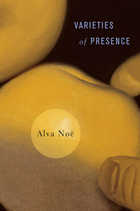 Varieties of Presence
Alva Noë
Harvard University Press, 2012 The world shows up for us—it is present in our thought and perception. But, as Alva Noë contends in his latest exploration of the problem of consciousness, it doesn’t show up for free. The world is not simply available; it is achieved rather than given. As with a painting in a gallery, the world has no meaning—no presence to be experienced—apart from our able engagement with it. We must show up, too, and bring along what knowledge and skills we’ve cultivated. This means that education, skills acquisition, and technology can expand the world’s availability to us and transform our consciousness.
Although deeply philosophical, Varieties of Presence is nurtured by collaboration with scientists and artists. Cognitive science, dance, and performance art as well as Kant and Wittgenstein inform this literary and personal work of scholarship intended no less for artists and art theorists, psychologists, cognitive scientists, and anthropologists than for philosophers.
Noë rejects the traditional representational theory of mind and its companion internalism, dismissing outright the notion that conceptual knowledge is radically distinct from other forms of practical ability or know-how. For him, perceptual presence and thought presence are species of the same genus. Both are varieties of exploration through which we achieve contact with the world. Forceful reflections on the nature of understanding, as well as substantial examination of the perceptual experience of pictures and what they depict or model are included in this far-ranging discussion.
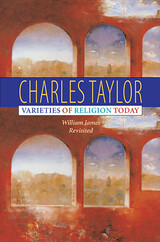 Varieties of Religion Today: William James Revisited
Charles Taylor
Harvard University Press, 2003 “Varieties of Religion Today is a provocative, witty, and worthy conversation with James’s timeless work.” —Publishers Weekly
A hundred years after William James delivered the celebrated lectures that became The Varieties of Religious Experience, one of the foremost thinkers in the English-speaking world returns to the questions posed in James’s masterpiece to clarify the circumstances and conditions of religion in our day. An elegant mix of the philosophy and sociology of religion, Charles Taylor’s powerful book maintains a clear perspective on James’s work in its historical and cultural contexts, while casting a new and revealing light upon the present.
Lucid, readable, and dense with ideas that promise to transform current debates about religion and secularism, Varieties of Religion Today is much more than a revisiting of James’s classic. Rather, it places James’s analysis of religious experience and the dilemmas of doubt and belief in an unfamiliar but illuminating context, namely the social horizon in which questions of religion come to be presented to individuals in the first place.
Taylor begins with questions about the way in which James conceives his subject, and shows how these questions arise out of different ways of understanding religion that confronted one another in James’s time and continue to do so today. Evaluating James’s treatment of the ethics of belief, he goes on to develop an innovative and provocative reading of the public and cultural conditions in which questions of belief or unbelief are perceived to be individual questions. What emerges is a remarkable and penetrating view of the relation between religion and social order and, ultimately, of what “religion” means.
 The Varieties of Religious Experience
William James
Harvard University Press, 1985 The Varieties of Religious Experience, first delivered as the Gifford Lectures in Edinburgh, was published in 1902 and quickly established itself as a classic. It ranks with its great predecessor, The Principles of Psychology, as one of William James's masterworks.
The book is not concerned with institutional religion. Its subtitle is "A Study in Human Nature," and James defines his subject as the feelings, acts, and experiences of individuals in relation to what they consider to be divine. His broad topics include the religion of healthy-mindedness; the sick soul; the divided self and its unification; conversion; saintliness; and mysticism. These and other phenomena are vividly documented by individual case histories--recorded in autobiographies, diaries, confessions, and similar writings--drawn from the whole range of world literature.
Constantly reprinted over the years, Varieties here appears for the first time in an edition prepared and annotated according to modern standards of textual scholarship. Manuscript material has been used to recover the form in which the last two lectures were originally delivered.
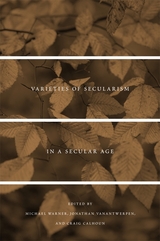 Varieties of Secularism in a Secular Age
Michael Warner
Harvard University Press, 2013 “What does it mean to say that we live in a secular age?” This apparently simple question opens into the massive, provocative, and complex A Secular Age, where Charles Taylor positions secularism as a defining feature of the modern world, not the mere absence of religion, and casts light on the experience of transcendence that scientistic explanations of the world tend to neglect.
In Varieties of Secularism in a Secular Age, a prominent and varied group of scholars chart the conversations in which A Secular Age intervenes and address wider questions of secularism and secularity. The distinguished contributors include Robert Bellah, José Casanova, Nilüfer Göle, William E. Connolly, Wendy Brown, Simon During, Colin Jager, Jon Butler, Jonathan Sheehan, Akeel Bilgrami, John Milbank, and Saba Mahmood.
Varieties of Secularism in a Secular Age succeeds in conveying to readers the complexity of secularism while serving as an invaluable guide to a landmark book.
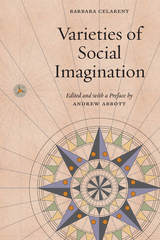 Varieties of Social Imagination
Barbara Celarent
University of Chicago Press, 2017 In July 2009, the American Journal of Sociology (AJS) began publishing book reviews by an individual writing as Barbara Celarent, professor of particularity at the University of Atlantis. Mysterious in origin, Celarent’s essays taken together provide a broad introduction to social thinking. Through the close reading of important texts, Celarent’s short, informative, and analytic essays engaged with long traditions of social thought across the globe—from India, Brazil, and China to South Africa, Turkey, and Peru. . . and occasionally the United States and Europe.
Sociologist and AJS editor Andrew Abbott edited the Celarent essays, and in Varieties of Social Imagination, he brings the work together for the first time. Previously available only in the journal, the thirty-six meditations found here allow readers not only to engage more deeply with a diversity of thinkers from the past, but to imagine more fully a sociology—and a broader social science—for the future.
 Varieties of Spanish in the United States
John M. Lipski
Georgetown University Press, 2008 Thirty-three million people in the United States speak some variety of Spanish, making it the second most used language in the country. Some of these people are recent immigrants from many different countries who have brought with them the linguistic traits of their homelands, while others come from families who have lived in this country for hundreds of years. John M. Lipski traces the importance of the Spanish language in the United States and presents an overview of the major varieties of Spanish that are spoken there. Varieties of Spanish in the United States provides—in a single volume—useful descriptions of the distinguishing characteristics of the major varieties, from Cuban and Puerto Rican, through Mexican and various Central American strains, to the traditional varieties dating back to the sixteenth and eighteenth centuries found in New Mexico and Louisiana. Each profile includes a concise sketch of the historical background of each Spanish-speaking group; current demographic information; its sociolinguistic configurations; and information about the phonetics, morphology, syntax, lexicon, and each group's interactions with English and other varieties of Spanish. Lipski also outlines the scholarship that documents the variation and richness of these varieties, and he probes the phenomenon popularly known as "Spanglish." The distillation of an entire academic career spent investigating and promoting the Spanish language in the United States, this valuable reference for teachers, scholars, students, and interested bystanders serves as a testimony to the vitality and legitimacy of the Spanish language in the United States. It is recommended for courses on Spanish in the United States, Spanish dialectology and sociolinguistics, and teaching Spanish to heritage speakers.
 Varieties of State Regulation: How China Regulates Its Socialist Market Economy
Yukyung Yeo
Harvard University Press In Varieties of State Regulation, Yukyung Yeo explores how, despite China’s increasing integration into the global market, the Chinese central party-state continues to oversee the most strategic sectors of its economy. Since the 1990s, as major state firms were spun off from the ministries that managed them under the central planning system, the nature of the state in governing the economy has been remarkably transformed into that of a regulator.
Based on over 100 interviews conducted with Chinese central and local officials, firms, scholars, journalists, and consultants, the book demonstrates that the form of central state control varies considerably across leading industrial sectors, depending on the dominant mode of state ownership, conception of control, and governing structure. By analyzing and comparing institutional dynamics across various sectors, Yeo explains variations in the pattern of China’s regulation of its economy. She contrasts the regulation of the automobile industry, a relatively decentralized sector, with the highly-centralized telecommunications industry, and demonstrates how China’s central party-state maintains regulatory authority over key local state-owned enterprises. Placing these findings in historical and comparative contexts, the book presents the evolution and current practice of state regulation in China and examines its compatibility with other contemporary government practices.
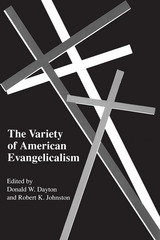 The Variety of American Evangelicalism
Donald W. Dayton
University of Tennessee Press, 2002 Those labeled as “evangelicals” commonly are assumed to constitute a large and fairly homogeneous segment of American Protestantism. This volume suggests that, in fact, evangelicalism is better understood as a set of distinct subtraditions, each with its own history, organizations, and priorities. The differences among groups are so important that the question arises: Is the term “evangelical” useful at all?
This book attempts to enter as sympathetically as possible into the self-understandings of movements usually grouped under the evangelical umbrella. For each of twelve major traditions, a leading scholarly interpreter first articulates the group’s theological orientation and then explores the relationship between that movement and broader “evangelical” issues and organizations. Contributors develop remarkably useful and diverse conceptual strategies for charting the complex evangelical landscape.
In crisp summary chapters, the editors draw differing conclusions from the many perspectives offered. Donald Dayton wants to abandon the category “evangelical” altogether. Robert Johnston sees the varied traditions as an “extended family” whose members embody common characteristics to greater or lesser degrees.
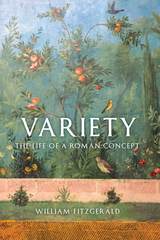 Variety: The Life of a Roman Concept
William Fitzgerald
University of Chicago Press, 2016 The idea of variety may seem too diffuse, obvious, or nebulous to be worth scrutinizing, but modern usage masks the rich history of the term. This book examines the meaning, value, and practice of variety from the vantage point of Latin literature and its reception and reveals the enduring importance of the concept up to the present day.
William Fitzgerald looks at the definition and use of the Latin term varietas and how it has played out in different works and with different authors. He shows that, starting with the Romans, variety has played a key role in our thinking about nature, rhetoric, creativity, pleasure, aesthetics, and empire. From the lyric to elegy and satire, the concept of variety has helped to characterize and distinguish different genres. Arguing that the ancient Roman ideas and controversies about the value of variety have had a significant afterlife up to our own time, Fitzgerald reveals how modern understandings of diversity and choice derive from what is ultimately an ancient concept.
 The Varnish and the Glaze: Painting Splendor with Oil, 1100–1500
Marjolijn Bol
University of Chicago Press, 2023 A new history of the techniques, materials, and aesthetic ambitions that gave rise to the radiant verisimilitude of Jan van Eyck’s oil paintings on panel.
Panel painters in both the middle ages and the fifteenth century created works that evoke the luster of precious stones, the sheen of polished gold and silver, and the colorful radiance of stained glass. Yet their approaches to rendering these materials were markedly different. Marjolijn Bol explores some of the reasons behind this radical transformation by telling the history of the two oil painting techniques used to depict everything that glistens and glows—varnish and glaze.
For more than a century after his death, the fifteenth-century painter Jan van Eyck was widely credited with inventing varnish and oil paint, on account of his unique visual realism. Once this was revealed to be a myth, the verisimilitude of his work was attributed instead to a new translucent painting technique: the glaze. Today, most theories about how Van Eyck achieved this realism revolve around the idea that he was the first to discover or refine the glazing technique. Bol, however, argues that, rather than being a fifteenth-century refinement, varnishing and glazing began centuries before. Drawing from an extensive body of recipes, Bol pieces together how varnishes and glazes were first developed as part of the medieval art of material mimesis. Artisans embellished metalwork and wood with varnishes and glazes to imitate gold and gems; infused rock crystal with oil, resin, and colorants to imitate more precious minerals; and oiled parchment to transform it into the appearance of green glass. Likewise, medieval panel painters used varnishes and glazes to create the look of enamel, silk, and more.
The explorations of materials and their optical properties by these artists stimulated natural philosophers to come up with theories about transparent and translucent materials produced by the earth. Natural historians, influenced by medieval artists’ understanding of refraction and reflection, developed theories about gems, their creation, and their optical qualities.
The Varnished Truth: Truth Telling and Deceiving in Ordinary Life
David Nyberg
University of Chicago Press, 1993 Everyone says that lying is wrong. But when we say that lying is bad and hurtful and that we would never intentionally tell a lie, are we really deceiving anyone? In this wise and insightful book, David Nyberg exposes the tacit truth underneath our collective pretense and reveals that an occasional lie can be helpful, healthy, creative, and, in some situations, even downright moral.
The Varnished Truth takes us beyond philosophical speculation and clinical analysis to give us a sense of what it really means to tell the truth. As Nyberg lays out the complexities involved in leading a morally decent life, he compels us to see the spectrum of alternatives to telling the truth and telling a clear-cut lie.
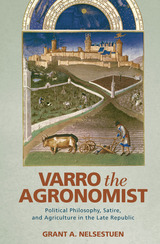 Varro the Agronomist: Political Philosophy, Satire, and Agriculture in the Late Republic
Grant A. Nelsestuen
Ohio State University Press, 2015 Some six years after his narrow escape from proscription in 43 bce, Marcus Terentius Varro, the “most learned” of the Romans, wrote a technical treatise on farming in the form of a satirico-philosophical dialogue. Grant A. Nelsestuen argues that far from simply being just another encyclopedic entry of a seemingly aloof antiquarian or offering an escapist’s retreat into rustication, Varro’s De Re Rustica uses the model of the farm to craft an implicitly political treatise that grapples with multifarious challenges facing the contemporary Roman world.
On one level, Varro’s treatise presents an innovative account of the Roman farm, which rationalizes new agricultural and pastoral opportunities for contemporary elite owners of large-scale estates. But on another level, this bold agronomical vision associates the farm’s different spheres with distinct areas under Roman control, thereby allegorizing Rome’s empire on the model of a farm. Nelsestuen argues that Varro’s treatise thus provides his contemporaries with a model for governing the Roman state, anticipates Augustus’ subsequent transformation of Roman dominion into a coherent territorial state, and offers an ancient theory of imperialism.
Shedding new light on the only completely extant work of a much-celebrated but ill-understood figure, Varro the Agronomist has much to offer to those interested in Latin literature—especially, Cicero and Vergil—as well as on the political dimensions of intellectual life in first-century bce Rome, ancient imperialism, and Roman political philosophy.
VAS: An Opera in Flatland: A Novel. By Steve Tomasula. Art and Design by Stephen Farrell.
Steve Tomasula and Stephen Farrell
University of Chicago Press, 2004 Printed in the colors of flesh and blood, VAS: An Opera in Flatland—a hybrid image-text novel—demonstrates how differing ways of imagining the body generate diverse stories of history, gender, politics, and, ultimately, the literature of who we are.
A constantly surprising, VAS combines a variety of voices, from journalism and libretto to poem and comic book. Often these voices meet in counterpoint, and the meaning of the narrative emerges from their juxtapositions, harmonies, or discords. Utilizing a wide and historical sweep of representations of the body—from pedigree charts to genetic sequences—VAS is, finally, the story of finding one's identity within the double helix of language and lineage.
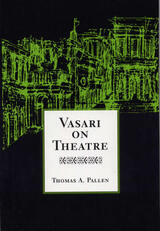 Vasari on Theatre
Thomas A. Pallen
Southern Illinois University Press, 1999
In the process of creating the massive work that eventually became Lives of the Most Eminent Painters, Sculptors, and Architects, painter and scholar Giorgio Vasari (1511–1574) spent much of the mid-sixteenth century traveling throughout Italy, meeting Renaissance artists and writing about their lives and works.
From this imposing source, Thomas A. Pallen has created a compendium of theatrical references augmented by related modern Italian scholarship. Vasari's Lives—daunting because of its sheer magnitude—has remained relatively obscure to English-speaking theatre historians. To introduce the numerous scenographic references of this great work to the English-speaking audience, Pallen provides new translations of all relevant passages, as well as a table of cross-references to the principal editions of Vasari in both English and Italian. And because Vasari often omitted important information, Pallen annotates the text, providing important names, places, and historical background.
Essentially, Pallen divides Vasari's work into four categories: triumphs and pageantry, ingegni for mystery plays and festivals, theatrical scenery, and miscellanea and lacunae. Although triumphs and pageantry were not directly theatrical, they were executed by many of the same artists who worked on theatrical productions and either used or introduced many Renaissance Italian theatrical techniques. The works described here range from tableaux vivants and other forms of street decoration to fireworks displays.
While Vasari did not personally know the work of either Filippo Brunelleschi or Francesco d'Angelo (called Cecca), he discusses their inventions for staging mystery plays and street festivals; indeed, Pallen shows how the work of these two artists paved the way for all later Renaissance scenography.
Pallen then deals with Vasari's references to and descriptions of the theatrical scenery and lighting effects of his time and the artists who created them. In accordance with the schema developed by Elena Povoledo, Pallen leads the reader through the evolution of scenographic thought and practice from the elementary work of Girolamo Genga to the advanced settings created by Vasari himself.
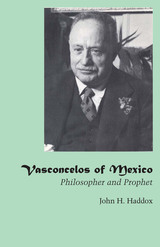 Vasconcelos of Mexico: Philosopher and Prophet
By John H. Haddox
University of Texas Press, 1967 José Vasconcelos—lawyer, politician, writer, educator, philosopher, prophet, and mystic—was one of the most influential and controversial figures in the intellectual life of twentieth-century Mexico. Vasconcelos was driven by the desire to gain a complete and comprehensive vision of reality, employing his own aesthetic-emotive method and a poetic mode of expression. The complex philosophical system that resulted is what he called “aesthetic monism.” But this is only one side of the man. Vasconcelos was also vitally interested in both the proximate realities and remote possibilities of Mexico, in the character of the “cosmic race” of his homeland, and in the relations between his own country and the others of this hemisphere. Soon after Vasconcelos’s death in 1959, Eduardo García Máynez spoke of him, in a moving tribute, as “without question the most inspiring intellectual and human figure that Mexico has produced.” Unhappily—and perhaps disgracefully—he has remained almost unknown outside the Spanish-speaking world. Histories of Mexico published in English usually give passing mention to his role as Minister of Public Education or his unsuccessful campaign for the presidency, but his aesthetic system and his socio-political ideas have been ignored by philosophers in the United States. Here, for the first time, is a unified, inclusive, and occasionally critical presentation of the entire range of Vasconcelos’s thought, from his metaphysics and theory of knowledge through his aesthetics and ethics to his social and political philosophy. It is enriched by an appendix in which the most significant passages from Vasconcelos’s own philosophical writings are presented in English translations.
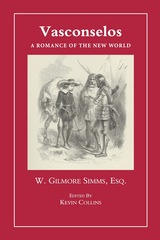 Vasconselos: A Romance of the New World
Kevin Collins
University of Arkansas Press, 2013 The writings of William Gilmore Simms (1806–1870) provide a sweeping fictional portrait of the colonial and antebellum South in all of its regional diversity. Simms's account of the region is more comprehensive than that of any other author of his time; he treats the major intellectual and social issues of the South and depicts the bonds and tensions among all of its inhabitants. By the mid-1840s Simms's novels were so well known that Edgar Allan Poe could call him "the best novelist which this country has, on the whole, produced." Perhaps the darkest of Simms's novel-length works, Vasconselos (1853) presents a fictionalized account of one of the first European efforts to settle the land that would become the United States, the Hernando de Soto expedition of 1539. Set largely in Havana, Cuba, as the explorers prepare to embark, the work explores such themes as the marginalization of racial and national minorities, the historical abuse of women, and the tendency of absolute power to corrupt absolutely. In addition, Simms anticipates in this colonial romance the works of renowned scholars who would follow him, including the historian Frederick Jackson Turner and the entire formal scholarly field of psychology, which would take shape only long after the author's death.
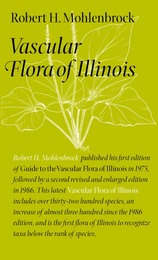 Vascular Flora of Illinois
Robert H. Mohlenbrock
Southern Illinois University Press, 2002
The first flora of Illinois was prepared in 1846 by Dr. Samuel B. Mead, a physician from Augusta, Illinois. Between 1846 and 1963, several people published plant lists and floras for various parts of Illinois. In 1975, Robert H. Mohlenbrock published his first edition of Guide to the Vascular Flora of Illinois, followed by a second expanded and revised edition in 1986.
This latest Vascular Flora of Illinois includes over thirty-two hundred species, an increase of almost three hundred since 1986. In addition, for the first time, taxa below the rank of species are recognized and may be identified by keys. Investigating seldom-visited patches of prairies, wetlands, and forested canyons, Mohlenbrock has added several native species to this flora. And while there has been extensive exploration for plants, Mohlenbrock has also researched the herbaria in an attempt to verify previous reports of records of Illinois plants.
Because of a reinterpretation of existing genera, the number of genera of Illinois plants has increased markedly. Recent biosystematic techniques have begun to substantiate the genera that botanists such as John Kunkel Small, Per Axel Rydberg, and Edmund C. Greene proposed nearly a century ago.
The sequence of groups in this book is ferns, conifers, and flowering plants, with dicotyledons given before monocotyledons. Within each group, the families are arranged alphabetically, as are the genera within each family and the species within each genus.
For each taxon recognized in this book, Mohlenbrock gives a common name if one is generally used in Illinois. He follows this by an indication of flowering time for flowering plants and of spore-production time for ferns and their relatives. He also provides a habitat statement and a general comment on distribution in Illinois for each taxon. Synonyms for some other scientific names used previously for a taxon appear in italics. This book contains indexes both for common names and for family and genus names.
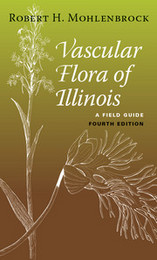 Vascular Flora of Illinois: A Field Guide, Fourth Edition
Robert H. Mohlenbrock
Southern Illinois University Press, 2013 This latest edition of Vascular Flora of Illinois includes over thirty-four hundred species of flora from Illinois, adding more than 250 newly-recognized plants to this definitive collection. Because cataloguing our heritage is foremost in importance among naturalists, this book compiles essential information about plants in Illinois. Mohlenbrock includes all known taxa native to Illinois either at present or in the past and all non-native vascular plants that grow spontaneously and appear able to maintain themselves year after year without cultivation. The sequence of groups in the guide is ferns, conifers, and flowering plants, with cotyledons given before monocotyledons. Within each group, the families are arranged alphabetically, as are the genera within each family and the species within each genus. For each taxon recognized in this book, Mohlenbrock gives us a common name if one is generally used in Illinois. He follows this with an indication of flowering time for flowering plants, and of spore-production time in the case of ferns and their relatives. He also provides a habitat statement and a general comment on distribution in Illinois for each taxon. Containing information on Illinois flora not available anywhere else, this fourth edition of Vascular Flora of Illinois is essential for ecologists, environmentalists, and land developers. Those interested in wildflower identification will also find this guide helpful.
Vascular Plant Families and Genera
R. K. Brummitt
Royal Botanic Gardens, Kew, 2000 Without doubt the standard reference of vascular plant generic names. Divided into three parts, Part 1 alphabetically lists all 14,000 generic names accepted by Kew with 10,000 synonyms, Part 2 is a list of genera by family and Part 3 analyses plant families according to various systems of classification.
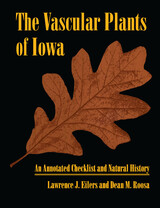 The Vascular Plants of Iowa: An Annotated Checklist and Natural History
Lawrence J. Eilers
University of Iowa Press, 1994 Anyone who works with the vascular plants of Iowa—researchers, conservationists, teachers, agricultural specialists, horticulturists, gardeners, and so on—and those who are simply interested in knowing more about the state's plants have long felt a need for a comprehensive flora of Iowa. This meticulously researched volume is a giant first step toward such a flora. This book consists of an extended essay on the natural history of the vascular plants of Iowa, a discussion of their origins, a description of the state's natural regions, and a painstakingly annotated checklist of Iowa vascular plants. The data, which apply to over 150 years, took more than 15 years to collect. All known vascular plants that grow and persist in Iowa without cultivation are included in the checklist. These are native plants, primarily, but a large number of introduced species have become established throughout the state. Also included are Iowa's major crop plants and some of its common garden plants. The lengthy checklist provides an accurate and up-to-date listing of species names and common names, synonyms, distribution, habitat, abundance, and origin; county names are given for very rare species, and the most complete information has been provided for all rare plants and troublesome species. The wealth of information is this well-organized, practical volume—which describes more than two thousand species from Adiantum pedatum, the northern maidenhair fern of moist woods and rocky slopes, to Zannichellia palustris, the horned pondweed of shallow marshes and coldwater streams—makes it possible to identify Iowa plants correctly. All midwesterners will want to own a copy of The Vascular Plants of Iowa.
 Vascular Plants of Minnesota: A Checklist and Atlas
Gerald B. Ownbey and Thomas Morley
University of Minnesota Press, 1993 Vascular Plants of Minnesota was first published in 1991. Minnesota Archive Editions uses digital technology to make long-unavailable books once again accessible, and are published unaltered from the original University of Minnesota Press editions. A definitive reference to the 2,010 vascular plant species (ferns, conifers, and flowering plants) currently found in Minnesota. The maps of he Atlas section show the geographic distribution of each plant, allowing the reader to visualize—for the first time—exactly where a species occurs in the state. Historical plant collections as well as records from detailed surveys conducted in the 1970s and 1980s by the Minnesota DNR, The Nature Conservancy, and individual researchers are included in this volume. The flora of Minnesota is of special interest because it represents the western limits of the vast eastern deciduous forest flora, the northern and eastern boundaries of the flora of the prairies and great plains, and the southwestern limits of the northern coniferous forest. These three contrasting continental floras meet more sharply in Minnesota than in other regions. The Checklist section provides both an authoritative summary of the nomenclature of Minnesota plants and extensive references to taxonomic literature. As such, it is the most complete list ever prepared for the entire state. Arranged alphabetically, group within group, the Checklist provides both Latin and common names for all species, subspecies, and varieties. Gerald B. Ownbey is an emeritus professor in the Department of Plant Biology at the University of Minnesota, Twin Cities. As the curator of the University Herbarium for more than thirty years, he developed its collection of almost 750,000 specimens to make it the largest in the Midwest. Professor Ownbey is the author of Common Wild Flowers of Minnesota (University of Minnesota Press, 1971). Thomas Morley is also an emeritus professor in the Department of Plant Biology at the University of Minnesota, Twin Cities. In addition to introducing hundreds of students to Minnesota flora in his popular course "Minnesota Plant Life," he is widely recognized for his pioneering efforts to protect remnants of Minnesota's native habitats. Professor Morley is the author of Spring Flora in Minnesota (University of Minnesota Press, 1966).
Vascular Plants of Northern Utah: An Identification Manual
Richard Shaw
Utah State University Press, 1989 Over 1,900 indigenous, alien, and culivated species found in the deserts and mountains of northern Utah are identified in this illustrated manual for professionals, students, and amateur taxonomists.
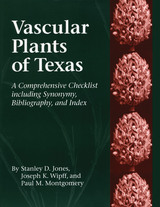 Vascular Plants of Texas: A Comprehensive Checklist Including Synonymy, Bibliography, and Index
By Stanley D. Jones, Joseph K. Wipff, and Paul M. Montgomery
University of Texas Press, 1997 Everyone with a professional interest in the flora of Texas will welcome this checklist of the vascular plants. This comprehensive list also includes crops, persistent perennials, and naturalized plants and encompasses over 1,000 changes to the previous (Hatch, 1990) checklist. The authors have arranged this checklist phylogenetically by classes following the Cronquist system. Several features make this checklist especially useful. Chief among them is the relative synonymy (name history). An extensive index makes current classification and correct nomenclature readily accessible, while the botanical bibliography is the most extensive ever compiled for Texas. The authors also note which plants have been listed as threatened or endangered by the Texas Organization of Endangered Species, which are designated as Federal Noxious Weeds, and which have been chosen as state tree, flower, fruit, etc. by the Texas Legislature.
Vasily Zhukovsky's Romanticism and the Emotional History of Russia
Ilya Vinitsky
Northwestern University Press, 2015 The first major study in English of Vasily Zhukovsky (1783–1852)—poet, translator of German romantic verse, and mentor of Pushkin—this book brings overdue attention to an important figure in Russian literary and cultural history. Vinitsky’s “psychological biography” argues that Zhukovsky very consciously set out to create for himself an emotional life reflecting his unique brand of romanticism, different from what we associate with Pushkin or poets such as Byron or Wordsworth. For Zhukovsky, ideal love was harmonious, built on a mystical foundation of spiritual kinship. Vinitsky shows how Zhukovksy played a pivotal role in the evolution of ideas central to Russia’s literary and cultural identity from the end of the eighteenth century into the decades following the Napoleonic Wars.
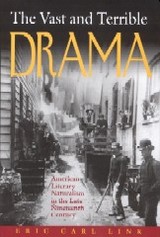 The Vast and Terrible Drama: American Literary Naturalism in the Late Nineteenth Century
Eric Carl Link
University of Alabama Press, 2004 A broad treatment of the cultural, social, political, and literary under-pinnings of an entire period and movement in American letters
The Vast and Terrible Drama is a critical study of the context in which authors such as Oliver Wendell Holmes, Stephen Crane, Frank Norris, Theodore Dreiser, and Jack London created their most significant work. In 1896 Frank Norris wrote: "Terrible things must happen to the characters of the naturalistic tale. They must be twisted from the ordinary . . . and flung into the throes of a vast and terrible drama." There could be "no teacup tragedies here." This volume broadens our understanding of literary naturalism as a response to these and other aesthetic concerns of the 19th century. Themes addressed include the traditionally close connection between French naturalism and American literary naturalism; relationships between the movement and the romance tradition in American literature, as well as with utopian fictions of the 19th century; narrative strategies employed by the key writers; the dominant naturalist theme of determinism; and textual readings that provide broad examples of the role of the reader. By examining these and other aspects of American literary naturalism, Link counters a century of criticism that has perhaps viewed literary naturalism too narrowly, as a subset of realism, bound by the conventions of realistic narration.
The Vatican and the Emergence of the Modern Middle East
Agnes de Dreuzy
Catholic University of America Press, 2016 The Holy See and the Emergence of the Modern Middle East examines the originality of Pope Benedict XVs diplomacy (1914-1922) during the First World War and the immediate post-war period in the modern Middle East emerging after the fall of the Ottoman Empire. A thorough exploration of the pontiff's statecraft regarding Syria, Lebanon, and Palestine serves as the case study and emphasizes Pope Benedict's participation in preparing the Catholic Church for an active role in the new world order.
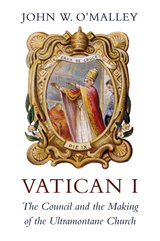 Vatican I: The Council and the Making of the Ultramontane Church
John W. O'Malley
Harvard University Press, 2018 In 1869, some seven hundred Catholic bishops traveled to Rome to participate in the first church-wide council in three hundred years. The French Revolution had shaken the foundations of the church. Pope Pius IX was determined to set things right through a declaration by the council that the pope was infallible.
John W. O’Malley brings to life the bitter, schism-threatening conflicts that erupted at Vatican I. The pope’s zeal in pressing for infallibility raised questions about the legitimacy of the council, at the same time as Italian forces under Garibaldi seized the Papal States and were threatening to take control of Rome itself. Gladstone and Bismarck entered the fray. As its temporal dominion shrank, the Catholic Church became more pope-centered than ever before, with lasting consequences.
“O’Malley’s account of the debate over infallibility is masterful.”
—Commonweal
“[O’Malley] excels in describing the ways in which the council initiated deep changes that still affect the everyday lives of Catholics.”
—First Things
“An eminent scholar of modern Catholicism…O’Malley…invit[es] us to see Catholicism’s recent history as profoundly shaped by and against the imposing legacy of Pius IX.”
—Wall Street Journal
“Gripping…O’Malley continues to engage us with a past that remains vitally present.”
—The Tablet
“The worldwide dean of church historians has completed his trinity of works on church councils…[A] masterclass in church history…telling us as much about the church now as then.”
—America
Vatican II Behind the Iron Curtain
Piotr H. Kosicki
Catholic University of America Press, 2016 The goal of this volume is to begin writing Central and Eastern Europe back into the story of the Second Vatican Council, its origins, and its consequences. This volume assembles - for the first time in any language - a broad overview of the place of four different Communist-run countries - Czechoslovakia, Hungary, Poland, and Yugoslavia - in the story of the Council. Framing these is an account of how the Cold War impacted the Council and its reception. The book engages with both English-language scholarship and the national historiographies of the countries that it examines, offering a global lens on the present state of research (covering all relevant languages) and seeking to propel that research forward. All of the chapters draw on both non-English secondary literature and original primary sources - some published, some archival.
 Vatican Israel Accords
Breger
University of Notre Dame Press, 2004 When The Fundamental Agreement between the Holy See and the State of Israel was signed on December 30, 1993, it established diplomatic ties between the Vatican and Israel for the first time. Published during the tenth anniversary year of this historic document, The Vatican-Israel Accords brings together essays that analyze the legal, historical, theological, and political meaning of the Accords.
The compelling essays in this collection explore not only the document and events surrounding its signing, but also the past, present, and future of Catholic-Jewish relations. Contributors, who include scholars from Israel, Italy, France, Spain, and the United States, contend that the history and structure of the Accords offer lessons that may be instructive for others involved in seeking peaceful resolutions to conflict, particularly those who work for peace between Palestine and Israel. This book is for anyone interested in law, political science, ecumenism, diplomacy, or peace studies.
Contributors: Marshall J. Breger, Laurenzo Cremonesi, Msgr. Richard Mathes, David-Maria A. Jaeger, O.F.M., Leonard Hammer, Silvio Ferrari, Rafael Palomino, Msgr. Roland Minnerath, Rabbi David Rosen, Moshe Hirsch, Geoffrey Watson, Giorgio Filibeck, Ruth Lapidoth, Fr. Drew Christiansen, S.J., and Rabbi Jack Bemporad.
MARSHALL J. BREGER is professor of law at the Columbus School of Law, Catholic University of America.
Reviews
"The Vatican-Israel Accords promises to make a tremendous contribution to understanding a tangled relationship. It is a unique, and uniquely valuable, volume." --George Weigel, Ethics and Public Policy Center, Washington, D.C.
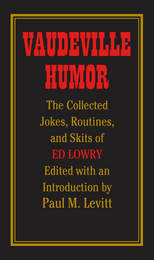 Vaudeville Humor: The Collected Jokes, Routines, and Skits of Ed Lowry
Edited with an Introduction by Paul M. Levitt
Southern Illinois University Press, 2006 Vaudeville Humor: The Collected Jokes, Routines, and Skits of Ed Lowry contains vaudeville jokes, skits, and routines from the first three decades of the twentieth century originally compiled by comedian Ed Lowry (1896–1983). Although occasionally found in bits and pieces in anthologies and in some period dramatic comedies, vaudeville humor has never before been available in one collection—performers rarely if ever kept a record of their jokes and routines. Fortunately, Ed Lowry was an inveterate collector. He kept copious notebooks of jokes and routines that he not only commissioned but also stole from other comics, clipped from newspapers, and copied from now defunct popular magazines of the day. Editor Paul M. Levitt has reorganized the material into categories that preserve some of the flavor of Lowry’s scrapbooks yet provide for finer distinctions. Part one, “Jokes,” is organized by subject matter and cataloged by genre, dialects, and wordplay. From “Accidents” to “Work,” this exhaustive catalog of humor features over one thousand jokes with topics that range from city slickers and country hicks through midgets and old maids to Swedes and tattoos. Part two, “MC Material: Biz, Jokes, Routines, and Skits” is germane to the job of master of ceremonies, routines, and skits. It features topics from fractured fairy tales to stuttering. Part three, an appendix, “Ed Lowry Laffter,”reproduces a privately published collection that is now a rare collector’s item. “Although some of the jokes can undoubtedly be found in other places,” explains Levitt in his introduction, “I know of no source as rich as this one for the twenties and thirties, a period so abundant in humor that for years afterward it fueled radio, cinema, and television.”
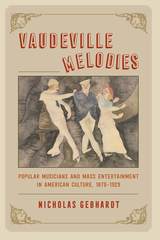 Vaudeville Melodies: Popular Musicians and Mass Entertainment in American Culture, 1870-1929
Nicholas Gebhardt
University of Chicago Press, 2017 If you enjoy popular music and culture today, you have vaudeville to thank. From the 1870s until the 1920s, vaudeville was the dominant context for popular entertainment in the United States, laying the groundwork for the music industry we know today.
In Vaudeville Melodies, Nicholas Gebhardt introduces us to the performers, managers, and audiences who turned disjointed variety show acts into a phenomenally successful business. First introduced in the late nineteenth century, by 1915 vaudeville was being performed across the globe, incorporating thousands of performers from every branch of show business. Its astronomical success relied on a huge network of theatres, each part of a circuit and administered from centralized booking offices. Gebhardt shows us how vaudeville transformed relationships among performers, managers, and audiences, and argues that these changes affected popular music culture in ways we are still seeing today. Drawing on firsthand accounts, Gebhardt explores the practices by which vaudeville performers came to understand what it meant to entertain an audience, the conditions in which they worked, the institutions they relied upon, and the values they imagined were essential to their success.
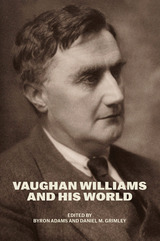 Vaughan Williams and His World
Edited by Byron Adams and Daniel M. Grimley
University of Chicago Press, 2023 A biography of Ralph Vaughan Williams, published in collaboration with the Bard Music Festival.
Ralph Vaughan Williams (1872–1958) was one of the most innovative and creative figures in twentieth-century music, whose symphonies stand alongside those of Sibelius, Nielsen, Shostakovich, and Roussel. After his death, shifting priorities in the music world led to a period of critical neglect. What could not have been foreseen is that by the second decade of the twenty-first century, a handful of Vaughan Williams’s scores would attain immense popularity worldwide. Yet the present renown of these pieces has led to misapprehension about the nature of Vaughan Williams’s cultural nationalism and a distorted view of his international cultural and musical significance.
Vaughan Williams and His World traces the composer’s stylistic and aesthetic development in a broadly chronological fashion, reappraising Vaughan Williams’s music composed during and after the Second World War and affirming his status as an artist whose leftist political convictions pervaded his life and music. This volume reclaims Vaughan Williams’s deeply held progressive ethical and democratic convictions while celebrating his achievements as a composer.
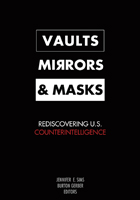 Vaults, Mirrors, and Masks: Rediscovering U.S. Counterintelligence
Jennifer E. Sims and Burton Gerber, Editors
Georgetown University Press, 2009 Decision makers matching wits with an adversary want intelligence—good, relevant information to help them win. Intelligence can gain these advantages through directed research and analysis, agile collection, and the timely use of guile and theft. Counterintelligence is the art and practice of defeating these endeavors. Its purpose is the same as that of positive intelligence—to gain advantage—but it does so by exploiting, disrupting, denying, or manipulating the intelligence activities of others. The tools of counterintelligence include security systems, deception, and disguise: vaults, mirrors, and masks. In one indispensable volume, top practitioners and scholars in the field explain the importance of counterintelligence today and explore the causes of—and practical solutions for—U.S. counterintelligence weaknesses. These experts stress the importance of developing a sound strategic vision in order to improve U.S. counterintelligence and emphasize the challenges posed by technological change, confused purposes, political culture, and bureaucratic rigidity. Vaults, Mirrors, and Masks skillfully reveals that robust counterintelligence is vital to ensuring America's security. Published in cooperation with the Center for Peace and Security Studies and the George T. Kalaris Memorial Fund, Edmund A. Walsh School of Foreign Service, Georgetown University.
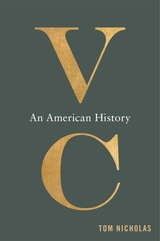 VC: An American History
Tom Nicholas
Harvard University Press, 2019 “An incisive history of the venture-capital industry.”
—New Yorker
“An excellent and original economic history of venture capital.”
—Tyler Cowen, Marginal Revolution
“A detailed, fact-filled account of America’s most celebrated moneymen.”
—New Republic
“Extremely interesting, readable, and informative…Tom Nicholas tells you most everything you ever wanted to know about the history of venture capital, from the financing of the whaling industry to the present multibillion-dollar venture funds.”
—Arthur Rock
“In principle, venture capital is where the ordinarily conservative, cynical domain of big money touches dreamy, long-shot enterprise. In practice, it has become the distinguishing big-business engine of our time…[A] first-rate history.”
—New Yorker
VC tells the riveting story of how the venture capital industry arose from America’s longstanding identification with entrepreneurship and risk-taking. Whether the venture is a whaling voyage setting sail from New Bedford or the latest Silicon Valley startup, VC is a state of mind as much as a way of doing business, exemplified by an appetite for seeking extreme financial rewards, a tolerance for failure and experimentation, and a faith in the promise of innovation to generate new wealth.
Tom Nicholas’s authoritative history takes us on a roller coaster of entrepreneurial successes and setbacks. It describes how iconic firms like Kleiner Perkins and Sequoia invested in Genentech and Apple even as it tells the larger story of VC’s birth and evolution, revealing along the way why venture capital is such a quintessentially American institution—one that has proven difficult to recreate elsewhere.
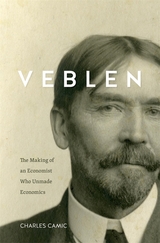 Veblen: The Making of an Economist Who Unmade Economics
Charles Camic
Harvard University Press, 2020 Co-Winner of the 2022 Theory Prize, American Sociological Association
A bold new biography of the thinker who demolished accepted economic theories in order to expose how people of economic and social privilege plunder their wealth from society’s productive men and women.
Thorstein Veblen was one of America’s most penetrating analysts of modern capitalist society. But he was not, as is widely assumed, an outsider to the social world he acidly described. Veblen overturns the long-accepted view that Veblen’s ideas, including his insights about conspicuous consumption and the leisure class, derived from his position as a social outsider.
In the hinterlands of America’s Midwest, Veblen’s schooling coincided with the late nineteenth-century revolution in higher education that occurred under the patronage of the titans of the new industrial age. The resulting educational opportunities carried Veblen from local Carleton College to centers of scholarship at Johns Hopkins, Yale, Cornell, and the University of Chicago, where he studied with leading philosophers, historians, and economists. Afterward, he joined the nation’s academic elite as a professional economist, producing his seminal books The Theory of the Leisure Class and The Theory of Business Enterprise. Until late in his career, Veblen was, Charles Camic argues, the consummate academic insider, engaged in debates about wealth distribution raging in the field of economics.
Veblen demonstrates how Veblen’s education and subsequent involvement in those debates gave rise to his original ideas about the social institutions that enable wealthy Americans—a swarm of economically unproductive “parasites”—to amass vast fortunes on the backs of productive men and women. Today, when great wealth inequalities again command national attention, Camic helps us understand the historical roots and continuing reach of Veblen’s searing analysis of this “sclerosis of the American soul.”
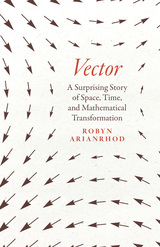 Vector: A Surprising Story of Space, Time, and Mathematical Transformation
Robyn Arianrhod
University of Chicago Press, 2024 A celebration of the seemingly simple idea that allowed us to imagine the world in new dimensions—sparking both controversy and discovery.
The stars of this book, vectors and tensors, are unlikely celebrities. If you ever took a physics course, the word “vector” might remind you of the mathematics needed to determine forces on an amusement park ride, a turbine, or a projectile. You might also remember that a vector is a quantity that has magnitude and (this is the key) direction. In fact, vectors are examples of tensors, which can represent even more data. It sounds simple enough—and yet, as award-winning science writer Robyn Arianrhod shows in this riveting story, the idea of a single symbol expressing more than one thing at once was millennia in the making. And without that idea, we wouldn’t have such a deep understanding of our world.
Vector and tensor calculus offers an elegant language for expressing the way things behave in space and time, and Arianrhod shows how this enabled physicists and mathematicians to think in a brand-new way. These include James Clerk Maxwell when he ushered in the wireless electromagnetic age; Einstein when he predicted the curving of space-time and the existence of gravitational waves; Paul Dirac, when he created quantum field theory; and Emmy Noether, when she connected mathematical symmetry and the conservation of energy. For it turned out that it’s not just physical quantities and dimensions that vectors and tensors can represent, but other dimensions and other kinds of information, too. This is why physicists and mathematicians can speak of four-dimensional space-time and other higher-dimensional “spaces,” and why you’re likely relying on vectors or tensors whenever you use digital applications such as search engines, GPS, or your mobile phone.
In exploring the evolution of vectors and tensors—and introducing the fascinating people who gave them to us—Arianrhod takes readers on an extraordinary, five-thousand-year journey through the human imagination. She shows the genius required to reimagine the world—and how a clever mathematical construct can dramatically change discovery’s direction.
The Veda in Kashmir, Volume I: History and Present State of Vedic Tradition in the Western Himalayas
Michael Witzel
Harvard University Press The Veda in Kashmir presents a detailed history and the current state of Veda tradition in Kashmir. It traces the vicissitudes of Vedic texts and rituals and their survival during some 400 years of Muslim rule. The peculiarities of the Śākalya Ṛgveda, Kaṭha Yajurveda, and Paippalāda Atharvaveda texts are discussed in great detail. The rituals from birth to death of the Pandits, the Kashmiri Brahmins, are depicted and explained, including current interpretation. This two-volume work includes a DVD that contains additional texts, rituals, sound recordings, and films taken in 1973 and 1979.
Veeck As In Wreck: The Autobiography of Bill Veeck
Bill Veeck with Ed Linn
University of Chicago Press, 2001 Bill Veeck was an inspired team builder, a consummate showman, and one of the greatest baseball men ever involved in the game. His classic autobiography, written with the talented sportswriter Ed Linn, is an uproarious book packed with information about the history of baseball and tales of players and owners, including some of the most entertaining stories in all of sports literature.
Ve-’Ed Ya‘aleh (Gen 2:6), Volume 1: Essays in Biblical and Ancient Near Eastern Studies Presented to Edward L. Greenstein
Peter Machinist
SBL Press, 2021 Sixty-six colleagues, friends, and former students of Edward L. Greenstein present essays honoring him upon his retirement. Throughout Greenstein's half-century career he demonstrated expertise in a host of areas astonishing in its breadth and depth, and each of the essays in these two volumes focuses on an area of particular interest to him. Volume 1 includes essays on ancient Near Eastern studies, Biblical Hebrew and Northwest Semitic languages, and biblical law and narrative. Volume 2 includes essays on biblical wisdom and poetry, biblical reception and exegesis, and postmodern readings of the Bible.
Ve-’Ed Ya‘aleh (Gen 2:6), Volume 2: Essays in Biblical and Ancient Near Eastern Studies Presented to Edward L. Greenstein
Peter Machinist
SBL Press, 2021 Sixty-six colleagues, friends, and former students of Edward L. Greenstein present essays honoring him upon his retirement. Throughout Greenstein's half-century career he demonstrated expertise in a host of areas astonishing in its breadth and depth, and each of the essays in these two volumes focuses on an area of particular interest to him. Volume 1 includes essays on ancient Near Eastern studies, Biblical Hebrew and Northwest Semitic languages, and biblical law and narrative. Volume 2 includes essays on biblical wisdom and poetry, biblical reception and exegesis, and postmodern readings of the Bible.
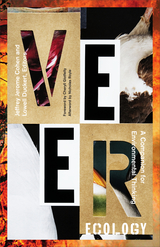 Veer Ecology: A Companion for Environmental Thinking
Jeffrey Jerome Cohen
University of Minnesota Press, 2017 The words most commonly associated with the environmental movement—save, recycle, reuse, protect, regulate, restore—describe what we can do to help the environment, but few suggest how we might transform ourselves to better navigate the sudden turns of the late Anthropocene. Which words can help us to veer conceptually along with drastic environmental flux? Jeffrey Jerome Cohen and Lowell Duckert asked thirty brilliant thinkers to each propose one verb that stresses the forceful potential of inquiry, weather, biomes, apprehensions, and desires to swerve and sheer. Each term is accompanied by a concise essay contextualizing its meaning in times of resource depletion, environmental degradation, and global climate change. Some verbs are closely tied to natural processes: compost, saturate, seep, rain, shade, sediment, vegetate, environ. Many are vaguely unsettling: drown, unmoor, obsolesce, power down, haunt. Others are enigmatic or counterintuitive: curl, globalize, commodify, ape, whirl. And while several verbs pertain to human affect and action—love, represent, behold, wait, try, attune, play, remember, decorate, tend, hope—a primary goal of Veer Ecology is to decenter the human. Indeed, each of the essays speaks to a heightened sense of possibility, awakening our imaginations and inviting us to think the world anew from radically different perspectives. A groundbreaking guide for the twenty-first century, Veer Ecology foregrounds the risks and potentialities of living on—and with—an alarmingly dynamic planet. Contributors: Stacy Alaimo, U of Texas at Arlington; Joseph Campana, Rice U; Holly Dugan, George Washington U; Lara Farina, West Virginia U; Cheryll Glotfelty, U of Nevada, Reno; Anne F. Harris, DePauw U; Tim Ingold, U of Aberdeen; Serenella Iovino, U of Turin; Stephanie LeMenager, U of Oregon; Scott Maisano, U of Massachusetts, Boston; Tobias Menely, U of California, Davis; Steve Mentz, St. John’s U; J. Allan Mitchell, U of Victoria; Timothy Morton, Rice U; Vin Nardizzi, U of British Columbia; Laura Ogden, Dartmouth College; Serpil Opperman, Hacettepe U, Ankara; Daniel C. Remein, U of Massachusetts, Boston; Margaret Ronda, U of California, Davis; Nicholas Royle, U of Sussex; Catriona Sandilands, York U; Christopher Schaberg, Loyola U; Rebecca R. Scott, U of Missouri; Theresa Shewry, U of California, Santa Barbara; Mick Smith, Queen’s U; Jesse Oak Taylor, U of Washington; Brian Thill, Golden West College; Coll Thrush, U of British Columbia, Vancouver; Cord J. Whitaker, Wellesley College; Julian Yates, U of Delaware.
Veganism, Sex and Politics: Tales of Danger and Pleasure
C. Lou Hamilton
Intellect Books, 2019 Veganism is so much more than what we eat. It’s about striving to live an ethical life in a profoundly unethical world. Is being vegan difficult or is it now easier than ever? What does veganism have to do with wider struggles for social justice – feminism, LGBTQ+ politics, anti-racism and environmentalism?
 Vegas Strong: Bearing Witness 1 October 2017
Roberta Sterman Sabbath
University of Nevada Press, 2023 Mass shootings have been on the rise in the United States since the early 2000s, but until the heartbreak of the 1 October 2017 Route 91 Harvest Music Festival, the citizens of Las Vegas had never experienced the violence and tragedy of this now all-too-frequent occurrence. That day, fifty-eight people were shot to death on site, while another two victims later died of their injuries. The 1 October incident physically wounded nearly 900 concert-goers, but psychologically impacted countless untold victims.
As individual and institutional response to urgent requests for help came in both during and after the 1 October catastrophe, those who call Las Vegas home struggled to cope with pain and grief. Now, editor Roberta Sabbath draws together a collection of personal essays, oral histories, interviews, scholarly writings, and commentaries to remember those whose lives were lost, and to honor survivors and their loved ones. Written five years after the tragedy, each contribution offers a unique story of healing, demonstrating the wide-ranging experiences and repercussions of the event. The essays in this collection represent a broad diversity of voices from political leaders, health professionals, first responders, community members, and incident survivors. This work is dedicated to those who lost their lives on 1 October 2017, to survivors and their loved ones, and to the caregivers—both individual and institutional—all of whom continue to keep Vegas Strong.
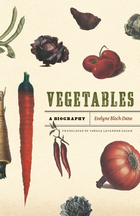 Vegetables: A Biography
Evelyne Bloch-Dano
University of Chicago Press, 2012 From Michael Pollan to locavores, Whole Foods to farmers' markets, today cooks and foodies alike are paying more attention than ever before to the history of the food they bring into their kitchens—and especially to vegetables. Whether it’s an heirloom tomato, curled cabbage, or succulent squash, from a farmers' market or a backyard plot, the humble vegetable offers more than just nutrition—it also represents a link with long tradition of farming and gardening, nurturing and breeding. In this charming new book, those veggies finally get their due. In capsule biographies of eleven different vegetables—artichokes, beans, chard, cabbage, cardoons, carrots, chili peppers, Jerusalem artichokes, peas, pumpkins, and tomatoes—Evelyne Bloch-Dano explores the world of vegetables in all its facets, from science and agriculture to history, culture, and, of course, cooking. From the importance of peppers in early international trade to the most recent findings in genetics, from the cultural cachet of cabbage to Proust’s devotion to beef-and-carrot stew, to the surprising array of vegetables that preceded the pumpkin as the avatar of All Hallow’s Eve, Bloch-Dano takes readers on a dazzling tour of the fascinating stories behind our daily repasts. Spicing her cornucopia with an eye for anecdote and a ready wit, Bloch-Dano has created a feast that’s sure to satisfy gardeners, chefs, and eaters alike.
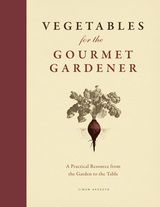 Vegetables for the Gourmet Gardener: A Practical Resource from the Garden to the Table
Simon Akeroyd
University of Chicago Press, 2014 The rise of the slow food movement and the return to home gardens mean cooks are donning gardening gloves as often as oven mitts. Modern cooking is heading back to its roots, with home cooks embracing local ingredients and down-to-earth recipes. With more and more of us discovering the delight of preparing and eating freshly harvested food, Vegetables for the Gourmet Gardener is the indispensable guide to what to grow, cook, and eat.
A feast for the eyes and the table, this user-friendly resource traverses the realms of both the garden and the kitchen, addressing the cultivation, storage, and preparation of nearly seventy useful vegetables. Practical growing tips, fascinating histories, nutritional information, and classic recipes appear alongside botanical illustrations drawn from the Royal Horticultural Society’s cherished collection. With both familiar varieties and novel options, Vegetables for the Gourmet Gardener will inspire you to create a world of new shapes, colors, and tastes.
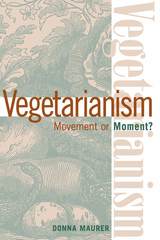 Vegetarianism: Movement Or Moment: Promoting A Lifestyle For Cult Change
Donna Maurer
Temple University Press, 2002 Vegetarianism seems to be increasing in popularity and acceptance in the United States and Canada, yet, quite surprisingly, the percentage of the population practicing vegetarian diets has not changed dramatically over the past 30 years. People typically view vegetarianism as a personal habit or food choice, even though organizations in North America have been promoting vegetarianism as a movement since the 1850s. This book examines the organizational aspects of vegetarianism and tries to explain why the predominant movement strategies have not successfully attracted more people to adopt a vegetarian identity.Vegetarianism: Movement or Moment? is the first book to consider the movement on a broad scale from a social science perspective. While this book takes into account the unique history of North American vegetarianism and the various reasons why people adopt vegetarian diets, it focuses on how movement leaders' beliefs regarding the dynamics of social change contributes to the selection of particular strategies for attracting people to vegetarianism. In the context of this focus, this book highlights several controversies about vegetarianism that have emerged in nutrition and popular media over the past 30 years.
The Vegetation of Wisconsin: An Ordination of Plant Communities
John T. Curtis
University of Wisconsin Press, 1959 One of the most important contributions in the field of plant ecology during the twentieth century, this definitive survey established the geographical limits, species compositions, and as much as possible of the environmental relations of the communities composing the vegetation of Wisconsin.
The Vegetational History of the Oaxaca Valley and Zapotec Plant Knowledge
C. Earle Smith and Ellen Messer
University of Michigan Press, 1978 In Part I of this volume, C. Earle Smith draws on years of survey in the Oaxaca Valley and archaeological discoveries of plant remains in the region to create a portrait of the valley’s original wild vegetation, previous to human settlement. In Part 2, Ellen Messer provides the results of her ethnobotanical study of the Zapotec residents of Mitla, a town in the southern highlands of the Valley of Oaxaca. Over the course of four years, she studied with local residents to learn the names and uses for wild plants and agricultural plants in the area.
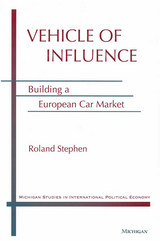 Vehicle of Influence: Building a European Car Market
Roland Stephen
University of Michigan Press, 2000 This study examines a crucial period in European integration, ending in the early 1990s, when significant progress was made towards the dream of a unified European market. It shows how European automakers were part of these changes and how their influence within the institutions of the European Union (EU) yielded a wide range of policy compromises governing a single European car market.
The book begins by reviewing the history of the EU and the logic of regional free trade, and goes on to develop a political explanation for the kinds of changes that actually occurred. The author argues that European automakers enjoyed a privileged place in the political arena, albeit one much transformed by the new institutions of the EU. Therefore, these firms often significantly influenced regional policy outcomes. The argument is applied to policymaking in the important areas of environmental regulation, trade, subsidies, and anti-trust regulation.
This work lies at the intersection of business, economics, and political science and is of interest to both experts and non-specialists with an interest in the tremendous economic and political changes brought about by the creation of a united Europe and, more generally, by the worldwide process of regional economic integration. Academics, professionals, businessmen, and leaders in government all have something to learn from the way in which firms and governments combined to build the largest car market in the world.
Roland Stephen is Assistant Professor in the Department of Political Science, North Carolina State University.
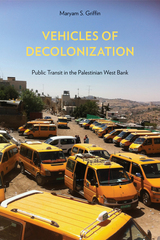 Vehicles of Decolonization: Public Transit in the Palestinian West Bank
Maryam S. Griffin
Temple University Press, 2022 Examining the border-enclosure strategy Israel uses to impose Palestinian im/mobilization, Maryam Griffin considers the ways public transportation in the Palestinian West Bank is a constant site of social struggle. Her illuminating book, Vehicles of Decolonization, studies collective movement, resistance, and everyday life in the West Bank to show how Palestinians assert a kind of Indigenous self-determination over mobility that Israeli settler colonialism seeks to undermine. Having immersed herself in a year of fieldwork, Griffin maps multiple engagements with the flexible bus, shared van, and private taxi services to demonstrate that the politics of mobility are shaped by ongoing settler colonialism and Indigenous struggle. Griffin uses critical border studies to look at the contested nature of mobility at the sites of transit, where Palestinians practice self-determination through routine participation, spectacular political organizing and demonstration, and artistic renderings. Featuring a variety of street images, Vehicles of Decolonization shows that multiple registers of people power work in concert not only to resist settler colonial logics but to reinhabit the land through the practice and preservation of alternative relations of mobility.
Vehicle-to-Grid: Linking electric vehicles to the smart grid
Junwei Lu
The Institution of Engineering and Technology, 2015 Plug-in electric and hybrid vehicles (PEVs) have the potential to provide substantial storage to a city's grid, a key component in mitigating intermittency issues of power sources. But the batteries of these vehicles also need to be charged at times when their users need them. Thus, V2G (vehicle-to-grid) is becoming an important issue in the future grid. An integrated treatment of this system, from power generation, monitoring, storage in stationary and PEV batteries to control is a complex task.
Vehicle-to-Grid Technology in Power Distribution Systems
Ali Moradi Amani
The Institution of Engineering and Technology, 2025 Electric vehicles offer more than just transportation; they hold the key to a more resilient energy grid. Vehicle-to-Grid (V2G) technology makes this possible, but significant technical, economic, social, and legal challenges stand in the way. This requires advancements in grid planning and operation, power electronics and control, communication, and charging infrastructure. The race is on to maximize the benefits of V2G while minimizing the risks.
Vehicular Ad Hoc Networks and Emerging Technologies for Road Vehicle Automation
Amit Kumar Tyagi
The Institution of Engineering and Technology, 2022 The automation of road vehicles is still developing, moving towards improved technology, safety, energy and fuel efficiency, comfort, economic growth, and real-world applications. Vehicle connectivity and information exchange over the road is an essential requirement for the future of automated driving. This book is intended to help bridge the gap between theory and applications of autonomous vehicles.
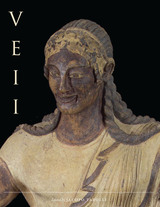 Veii
Edited by Jacopo Tabolli with Orlando Cerasuolo
University of Texas Press, 2019 Reputed to be the richest city of Etruria, Veii was one of the most important cities in the ancient Mediterranean world. It was located ten miles northwest of Rome, and the two cities were alternately allied and at war for over three hundred years until Veii fell to Rome in 396 BCE, although the city continued to be inhabited until the Middle Ages. Rediscovered in the seventeenth century, Veii has undergone the longest continuous excavation of any of the Etruscan cities. The most complete volume on the city in English, Veii presents the research and interpretations of multiple generations of Etruscan scholars who are at the forefront of the discipline. Their essays are grouped into four parts. The first provides a general overview of archaeological excavation at Veii and discusses the different types of methodologies employed over the years. The second part narrates the history of Etruscan occupation of the city and its role in the greater Mediterranean world. The third section examines the surviving material culture of Veii, including pottery, painting, sculpture, metalworking, and architectural terracottas. Finally, the legacy of Veii is discussed, and a chronology of the site is presented. This pioneering research offers all students of the ancient Mediterranean a new understanding of the development of Veii and its territory from the late Bronze Age to the Roman conquest, as well as of the interactions of Veii with nearby sites and territories in central Tyrrhenian Italy.
Veil and Burn
Laurie Clements Lambeth
University of Illinois Press, 2007 Concerned with physical experience, pain, and disability, Veil and Burn illuminates an intense desire to feel through the Other, embrace it, become it, and in the transformation, to understand the suffering body. In poems about animals, artifacts, and monsters, Lambeth displays a fascination for all bodies while exploring their pain, common fate, alienation, and abilities. Hovering between poem and prose fragment, between the self and fellow creatures, Laurie Clements Lambeth celebrates physical sensation, imbuing it with lyric shape, however broken, however imprisoned the shape may be.
 The Veil of Isis: An Essay on the History of the Idea of Nature
Pierre Hadot
Harvard University Press, 2006 Nearly twenty-five hundred years ago the Greek thinker Heraclitus supposedly uttered the cryptic words "Phusis kruptesthai philei." How the aphorism, usually translated as "Nature loves to hide," has haunted Western culture ever since is the subject of this engaging study by Pierre Hadot. Taking the allegorical figure of the veiled goddess Isis as a guide, and drawing on the work of both the ancients and later thinkers such as Goethe, Rilke, Wittgenstein, and Heidegger, Hadot traces successive interpretations of Heraclitus' words. Over time, Hadot finds, "Nature loves to hide" has meant that all that lives tends to die; that Nature wraps herself in myths; and (for Heidegger) that Being unveils as it veils itself. Meanwhile the pronouncement has been used to explain everything from the opacity of the natural world to our modern angst.
From these kaleidoscopic exegeses and usages emerge two contradictory approaches to nature: the Promethean, or experimental-questing, approach, which embraces technology as a means of tearing the veil from Nature and revealing her secrets; and the Orphic, or contemplative-poetic, approach, according to which such a denuding of Nature is a grave trespass. In place of these two attitudes Hadot proposes one suggested by the Romantic vision of Rousseau, Goethe, and Schelling, who saw in the veiled Isis an allegorical expression of the sublime. "Nature is art and art is nature," Hadot writes, inviting us to embrace Isis and all she represents: art makes us intensely aware of how completely we ourselves are not merely surrounded by nature but also part of nature.
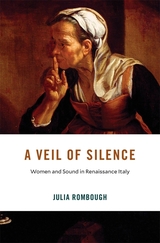 A Veil of Silence: Women and Sound in Renaissance Italy
Julia Rombough
Harvard University Press, 2024 An illuminating study of early modern efforts to regulate sound in women’s residential institutions, and how the noises of city life—both within and beyond their walls—defied such regulation.
Amid the Catholic reforms of the sixteenth and seventeenth centuries, the number of women and girls housed in nunneries, reformatories, and charity homes grew rapidly throughout the city of Florence. Julia Rombough follows the efforts of legal, medical, and ecclesiastical authorities to govern enclosed women, and uncovers the experiences of the women themselves as they negotiated strict sensory regulations. At a moment when quiet was deeply entangled with ideals of feminine purity, bodily health, and spiritual discipline, those in power worked constantly to silence their charges and protect them from the urban din beyond institutional walls.
Yet the sounds of a raucous metropolis found their way inside. The noise of merchants hawking their wares, sex workers laboring and socializing with clients, youth playing games, and coaches rumbling through the streets could not be contained. Moreover, enclosed women themselves contributed to the urban soundscape. While some embraced the pursuit of silence and lodged regular complaints about noise, others broke the rules by laughing, shouting, singing, and conversing. Rombough argues that ongoing tensions between legal regimes of silence and the inevitable racket of everyday interactions made women’s institutions a flashpoint in larger debates about gender, class, health, and the regulation of urban life in late Renaissance Italy.
Attuned to the vibrant sounds of life behind walls of stone and sanction, A Veil of Silence illuminates a revealing history of early modern debates over the power of the senses.
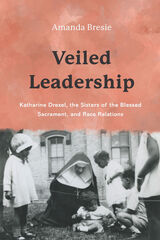 Veiled Leadership: Katharine Drexel, The Sisters of the Blessed Sacrament, and Race Relations
Amanda Bresie
Catholic University of America Press, 2023 On the rainy morning of October 1, 2000, Pope John Paul II canonized Mother Katharine Drexel. Born into a wealthy Philadelphia family, Drexel bucked society and formed the Sisters of the Blessed Sacrament for Indians and Colored People. Her compelling personal story has excited many biographers who have highlighted her holiness and catalogued her good deeds. During her life, newspapers called her the “Millionaire Nun,” and much of the literature on Drexel and the Sisters of the Blessed Sacrament exalts Katharine Drexel’s disbursement of her vast fortune to benefit Black and Indigenous people. The often repeated stories of a riches to rags holy woman miss the true significance of what Mother Katharine and the Sisters of the Blessed Sacrament attempted. Drexel was not merely the ATM of Catholic Home Missions; rather, she challenged the hierarchy to reimagine its mission in the United States. In an era when the Church controlled the actions and censored the opinions of women religious, they had to listen to Mother Katharine. Most writing on Drexel and the SBS focus on Drexel’s spiritual journey, but Veiled Leadership traces the daily operations of her charitable empire and looks at how the Sisters implemented Drexel’s vision in the field. The SBS were not always welcomed in the communities they served, and they experienced conflict from both white supremacists and the people they wanted to aid.
Veiled Leadership examines the lives of Mother Katharine and her congregation within the context of larger constructs of gender, race, religion, reform, and national identity. It explores what happens when a non-dominant culture tries to impose its views and morals on other non-dominant cultures. In other words, as outliers themselves—they were semi-cloistered Catholic women from primarily immigrant backgrounds in a culture that regarded their lifestyles as alien and unnatural—their attempts to Americanize and assimilate Black and Indigenous people, whose families had been in the country for generations longer than the nuns’ own, adds complexity to our understanding of cultural hegemony.
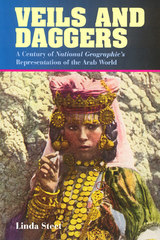 Veils And Daggers
Linda Steet
Temple University Press, 2000 National Geographic magazine is an American popular culture icon that, since its founding in 1888, has been on a nonstop tour classifying and cataloguing the peoples of the world. With more than ten million subscribers, National Geographic is the third largest magazine in America, following only TV Guide and Reader's Digest. National Geographic has long been a staple of school and public libraries across the country.
In Veils and Daggers, Linda Steet provides a critically insightful and alternative interpretation of National Geographic. Through an analysis of the journal's discourses in Orientalism, patriarchy, and primitivism in the Arab world as well as textual and visual constructions of Arab men and women, Islam, and Arab culture, Veils and Daggers unpacks the ideological perspectives that have guided National Geographic throughout its history. Drawing on cultural, feminist, and postcolonial criticism, Steet generates alternative readings that challenge the magazine's claims to objectivity. In this fascinating journey, it becomes clear that neither text nor image in the magazine can be regarded as natural or self-evident and she artfully demonstrates that the act of representing others "inevitably involves some degree of violence, decontextualization, minaturization, etc." The subject area known as Orientalism, she shows, is a manmade concept that as such must be studied as an integral component of the social, rather than the natural or divine world.
Veils and Daggers repositions and redefines National Geographic as an educational journal. Steet's work is an important and groundbreaking contribution in the area of social construction of knowledge, social foundations of education, popular educational media, and social studies as well as racial identity, ethnicity, gender. Once encountered, readers of National Geographic will never regard it in the same manner again.
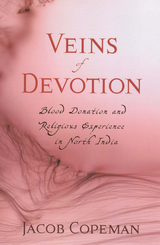 Veins of Devotion: Blood Donation and Religious Experience in North India
Copeman, Jacob
Rutgers University Press, 2008 According to public health orthodoxy, blood for transfusion is safer when derived from voluntary, nonremunerated donors. As developing nations phase out compensated blood collection efforts to comply with this current policy, many struggle to keep their blood stores up. Veins of Devotion details recent collaborations between guru-led devotional movements and public health campaigns to encourage voluntary blood donation in northern India. Focusing primarily on Delhi, Jacob Copeman carefully situates the practice within the context of religious gift-giving, sacrifice, caste, kinship, and nationalism. The book analyzes the operations of several high-profile religious orders that organize large-scale public blood-giving events and argues that blood donation has become a site not only of frenetic competition between different devotional movements, but also of intense spiritual creativity. Despite tensions between blood banks and these religious groups, their collaboration is a remarkable success storyùthe nation's blood supply is replenished while blood donors discover new devotional possibilities.
Download open access ebook here.
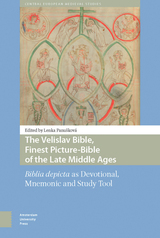 The Velislav Bible, Finest Picture-Bible of the Late Middle Ages: Biblia depicta as Devotional, Mnemonic and Study Tool
Edited by Lenka Panušková
Amsterdam University Press, 2018 The Velislav Bible is one of the most beautiful medieval Bohemian manuscripts. It is a heavily illustrated manuscript that contains only short selections of the text, that instruct the reader about the story depicted. The last picture in the manuscript shows a man kneeling before St. Catherine, identified as Velislav, hence the name of the manuscript. The Bible comprises stories from the Books of Genesis and Exodus, visions of Daniel, and the stories of Samson as well as of Judith. The narrative of the Antichrist precedes the Christological part. The New Testament continues with the Book of Revelation, stories following the Ascension of Christ, and key events from the lives of St. Peter and St. Paul. The manuscript closes with the legend of St. Wenceslas, the patron saint of Bohemia. The essays in The Velislav Bible, Finest Picture-Bible of the Late Middle Ages: Biblia depicta as Devotional, Mnemonic and Study Tool analyze the manuscript from historical, textual, art-historical, and iconographic perspectives. However, a shared concern of all the authors is to think about its functions. An edition of the Latin titulis is being published here for the first time.
 Velleius Paterculus
Velleius Paterculus
Harvard University Press, 2024 A Roman commander’s comprehensive history of Rome.
The histories of Velleius Paterculus chronicle the story of Rome and Roman culture from the fall of Troy to AD 30. Although his work’s title, proem, and opening chapters are lost along with the narrative from Romulus to the Battle of Pydna in 168 BC, Velleius provides much valuable information, especially about the reigns of Augustus and Tiberius (30 BC–AD 37), for which he provides our only extant historical depiction by a contemporary witness. Velleius was also an active participant: after service under both emperors as a military tribune in Thrace, Macedonia, Greece, and Asia Minor and as a cavalry officer and legatus in Germany and Pannonia, he joined Tiberius at his triumph in AD 12 and became praetor in 15, after which he seems to have retired from public life except for meetings of the senate.
Much like his near-contemporaries Cornelius Nepos (LCL 467) and Valerius Maximus (LCL 492, 493), Velleius adopted for his work a condensed and selective format, but his style is richly literary and he allows himself to digress when themes or topics seem especially interesting or significant: these include literature, rhetoric, culture, chronology, and dating, as well as individual Roman towns, colonies, and provinces, about which he was richly informed through firsthand familiarity with Rome and much of the empire along a vast arc that stretched from the Elbe to the Euphrates.
This edition of Velleius Paterculus, which replaces that of F. W. Shipley, offers a new translation, ample annotation, and a freshly edited text.
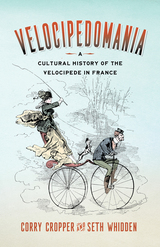 Velocipedomania: A Cultural History of the Velocipede in France
Corry Cropper
Bucknell University Press, 2023 When blacksmith Pierre Michaux affixed pedals to the front axle of a two-wheeled scooter with a seat, he helped kick off a craze known as velocipedomania, which swept France in the late 1860s. The immediate forerunner of the bicycle, the velocipede similarly reflected changing cultural attitudes and challenged gender norms.
Velocipedomania is the first in-depth study of the velocipede fad and the popular culture it inspired. It explores how the device was hailed as a symbol of France’s cutting-edge technological advancements, yet also marketed as an invention with a noble pedigree, born from the nation’s cultural and literary heritage. Giving readers a window into the material culture and enthusiasms of Second Empire France, it provides the first English translations of 1869’s Manual of the Velocipede, 1868’s Note on Monsieur Michaux’s Velocipede, and the 1869 operetta Dagobert and his Velocipede. It also reprints scores of rare images from newspapers and advertisements, analyzing how these magnificent machines captured the era’s visual imagination. By looking at how it influenced French attitudes towards politics, national identity, technology, fashion, fitness, and gender roles, this book shows how the short-lived craze of velocipedomania had a big impact.
Velocity
Nancy Krygowski
University of Pittsburgh Press, 2007 Velocity time travels through memory and conjecture, yet Krygowski's poems--often sad, sometimes humorous, always generous--return us continually to the beautiful and difficult here-and-now. Lovingly grounded in the ordinary, these are thinking poems--tightly crafted, accessible inquiries more interested in exploring stark and complicated knowledge than in proclaiming it. The poems, which use a sister's death as a touchstone, dwell in the overlap of emotions. Loss touches happiness, desire touches fear, love touches futile knowing. Krygowski's unstoppable energy for seeking and revealing disparate thoughts and emotions makes the collection wholly human. This fresh, surprising voice speaks for the intelligent heart in each of us.
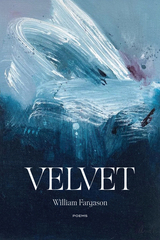 Velvet: Poems
William Fargason
Northwestern University Press, 2024 An exposed and exposing collection of poetry on inherited trauma, chronic illness, and the American South
Velvet, the second full-length collection from award-winning poet William Fargason, explores chronic illness, patriarchal abuse, intergenerational trauma, and racial inequality in the American South. Its speaker moves through the generations that preceded him to understand himself, and to heal from traumas both inherited and lived. As part of that heritage, the speaker confronts a family history of participation in racist ideologies and organizations to make sense of his own place within, and responsibility to, this history. In the titular lyric essay, “Velvet,” Fargason braids scientific research and YouTube videos in an attempt to forge paths for healing while contending with an inherited chronic disease. Ultimately, Velvet argues against traditional forms of toxic masculinity and suggests that vulnerability, soft and bleeding as the velvet on a deer’s antlers, offers one solution to it.
Venda Children's Songs: A Study in Ethnomusicological Analysis
John Blacking
University of Chicago Press, 1995 John Blacking is widely recognized for his theoretical works How Musical Is Man? and The Anthropology of the Body. This series of essays and articles on the music of the Venda people of the northern Transvaal in South Africa constitutes his major scholarly legacy.
Venda Children's Songs presents a detailed analysis of both the music and the cultural significance of children's songs among the Venda. Among its many original contributions is the identifying of the role of melody in generating rhythm, something that distinguishes this form of music from that of Venda adults as well as from other genres of African music in general.
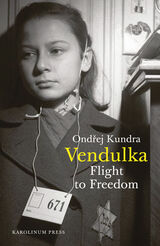 Vendulka: Flight to Freedom
Ondrej Kundra
Karolinum Press, 2021 So many lives were cut short by the Holocaust, many with no trace to leave behind for future generations to remember. Vendulka tells the story of a single scrap of remembrance—a candid photograph taken in the midst of this unspeakable tragedy—and that artifact’s amazing aftermath.
Famed Czech photographer Jan Lukas snapped an offhand portrait of twelve-year-old Vendulka Vogl in March 1943. A friend of the Vogls, Lukas was saying goodbye to the family, who were soon to leave Prague for a concentration camp. The photograph almost didn’t see the light of day—Lukas knew that if the Nazis found it on him, he could wind up in the camps as well—but the image was eventually developed and came to symbolize the Holocaust and humanize its victims. Seventy years after this famous picture was taken, investigative journalist Ondřej Kundra discovered that, despite all odds, Vendulka Vogl had survived the camps of Terezín, Auschwitz, and Christianstadt, and was in fact still alive and living in the United States. Kundra persuaded her to tell the remarkable story surrounding the photograph: her survival, her later decision to flee the Communist regime for America, and how she later reconnected with Jan Lukas, maintaining a lifelong friendship.
Vogl’s thrillingly moving story, Kundra’s sharp and engaging writing, and Lukas’s striking photography all combine to make Vendulka an inspiring investigation into the horrors of totalitarianism and the redemptive beauty of friendship.
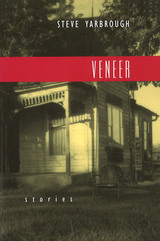 Veneer: Stories
Stories by Steve Yarbrough
University of Missouri Press, 1998
Acclaimed short story writer Steve Yarbrough, whose works have been included in the Pushcart Prize anthology and The Best American Mystery Stories 1998, once again demonstrates his gift for vividly rendered characters and evocative themes in his latest collection of fiction.
Veneer presents a variety of characters from cultural backgrounds and settings that range from California to Mississippi to Eastern Europe. Yarbrough's sensitive portrayals of loss and longing are individual and unsettling; a disaffected college football coach, a movie star with a "substance problem," and a small-town girl coming to grips with the murder of her mother are just a few examples of the turbulent lives he portrays. In every instance, each character is "constantly searching for some way to bridge the gap, so small and yet so vast, between a right move and a wrong one."
A poignant theme running through this collection is the conflict between appearance and reality. Yarbrough presents the reader with deep narrative layers, juxtaposing the gritty present with nostalgic recollections of an idealized past or hopeful projections into a rosy future. "Veneer," the title piece, beautifully reveals the depth of this conflict. On the surface, the narrator, a married man whose family is away on vacation, enjoys a dinner with a woman who has been a longtime friend. Beneath that "veneer," however, lies a more complex, perhaps troubling, relationship between the two friends, a relationship only partially obscured by the comic recounting of a childhood Independence Day.
Yarbrough is at his best when he offers us brief glimpses into his characters' minds and imaginations, brilliantly exposing subtle vulnerabilities as cracks in the veneer. "Bohemia" follows the travels of two young lovers as they explore Europe. The woman fears that her lover will abandon her, and when she wakes to find him gone one evening, she believes her fear is confirmed. Yet his return does not alleviate her insecurity. The reality of her lover's presence and her continued anxiety emphasize the many layers that constitute the woman's world.
Diverse in locale, character, and content, the stories in Veneer present rare views into the rifts between husband and wife, parent and child, one sibling and another. Crafting these compelling, deceptively simple stories is a writer whose "true subject is the human heart."
Venetian Disegno: New Frontiers
Edited by Maria Aresin and Thomas Dalla Costa
Paul Holberton Publishing, 2023 A volume that offers a fresh perspective on the art of Venice and the Veneto region of Italy by focusing on the artistic idea of disegno. Disengo (Italian for drawing or design) refers to the philosophical relationship between the conceptual role of design and the physical act of drawing. Venetian Disegno explores this theme and its history in the Veneto artistic landscape with contributions on myriad artists and art forms including drawing, painting, printmaking, sculpture, and architecture. Divided into five thematic sections and sumptuously illustrated with over one hundred images, Venetian Disegno represents a significant contribution to scholarship on the art of Venice, Renaissance workshops, and drawing studies.
A Venetian Spy’s Account of the War of Candia: Emmanuel Mormori’s Italian Text with English Translation and Dossier of Sources
Kiril Petkov
Arc Humanities Press, 2025 This text is an eyewitness account of the crucial first five years of the War of Candia (1645–1669), also known as the Cretan War and Fifth Ottoman-Venetian War: the war between the Republic of Venice and her allies against the Ottoman Empire and the Barbary States. It is a primary source for the longest Mediterranean conflict of the early modern age. Composed by Emmanuel Mormori, a hitherto obscure Greek Cretan nobleman, the text is accompanied by an extensive introduction focusing on the author, who appears to have been a Venetian intelligence agent in Ottoman-conquered Chania (in Crete), and, for a period of five years, became key to the Venetian war effort. The volume includes a dossier of documents illuminating this figure, culled from the collections of the State Archive of Venice.
|
|
